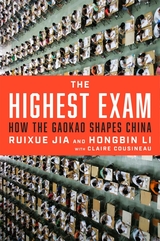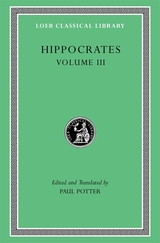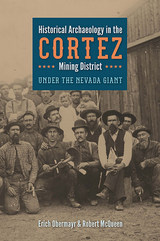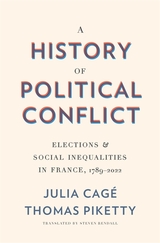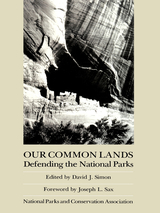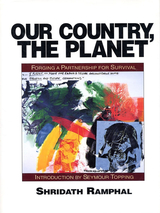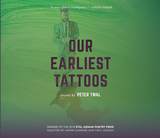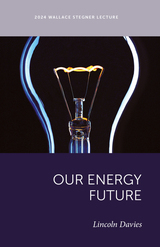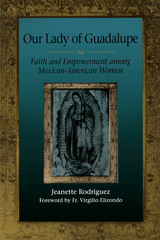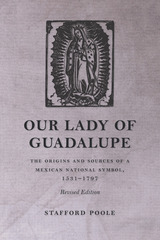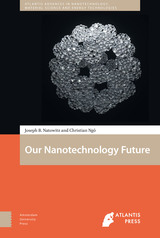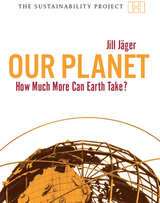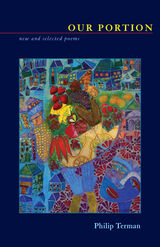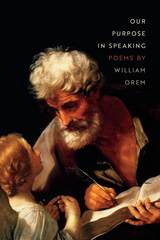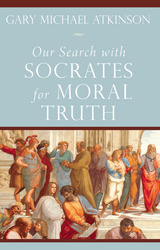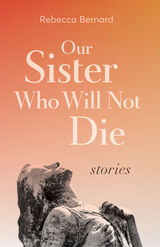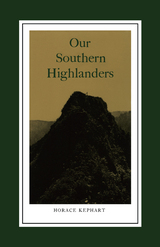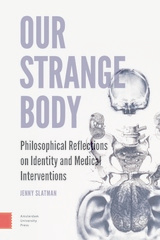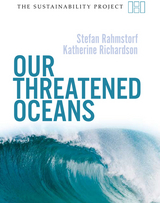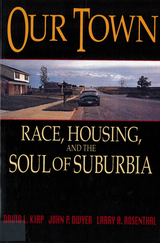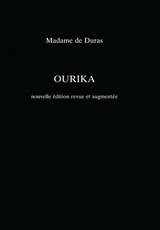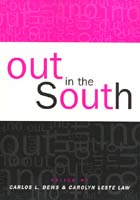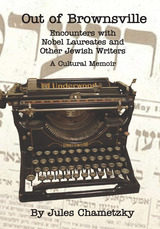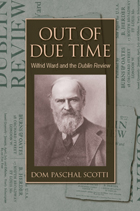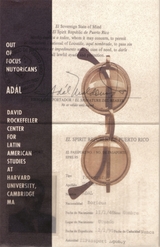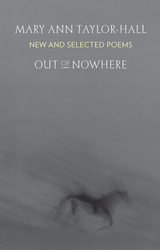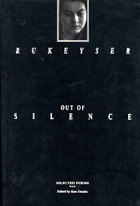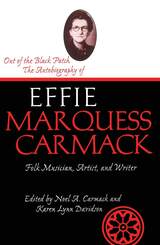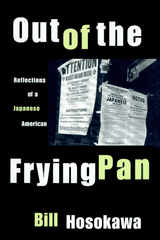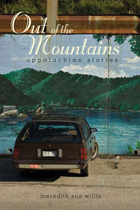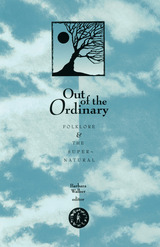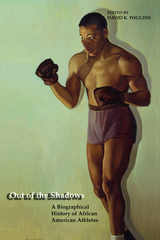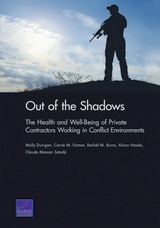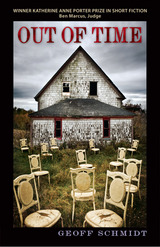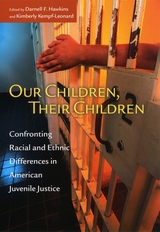 Our Children, Their Children: Confronting Racial and Ethnic Differences in American Juvenile Justice
Edited by Darnell F. Hawkins and Kimberly Kempf-Leonard
University of Chicago Press, 2005 In Our Children, Their Children, a prominent team of researchers argues that a second-rate and increasingly punitive juvenile justice system is allowed to persist because most people believe it is designed for children in other ethnic and socioeconomic groups. While public opinion, laws, and social policies that convey distinctions between "our children" and "their children" may seem to conflict with the American ideal of blind justice, they are hardly at odds with patterns of group differentiation and inequality that have characterized much of American history.
Our Children, Their Children provides a state-of-the-science examination of racial and ethnic disparities in the American juvenile justice system. Here, contributors document the precise magnitude of these disparities, seek to determine their causes, and propose potential solutions. In addition to race and ethnicity, contributors also look at the effects on juvenile justice of suburban sprawl, the impact of family and neighborhood, bias in postarrest decisions, and mental health issues. Assessing the implications of these differences for public policy initiatives and legal reforms, this volume is the first critical summary of what is known and unknown in this important area of social research.
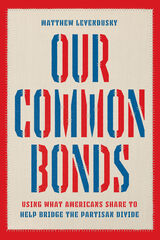 Our Common Bonds: Using What Americans Share to Help Bridge the Partisan Divide
Matthew Levendusky
University of Chicago Press, 2023 A compelling exploration of concrete strategies to reduce partisan animosity by building on what Democrats and Republicans have in common.
One of the defining features of twenty-first-century American politics is the rise of affective polarization: Americans increasingly not only disagree with those from the other party but distrust and dislike them as well. This has toxic downstream consequences for both politics and social relationships. Is there any solution?
Our Common Bonds shows that—although there is no silver bullet that will eradicate partisan animosity—there are concrete interventions that can reduce it. Matthew Levendusky argues that partisan animosity stems in part from partisans’ misperceptions of one another. Democrats and Republicans think they have nothing in common, but this is not true. Drawing on survey and experimental evidence, the book shows that it is possible to help partisans reframe the lens through which they evaluate the out-party by priming commonalities—specifically, shared identities outside of politics, cross-party friendships, and common issue positions and values identified through civil cross-party dialogue. Doing so lessons partisan animosity, and it can even reduce ideological polarization. The book discusses what these findings mean for real-world efforts to bridge the partisan divide.
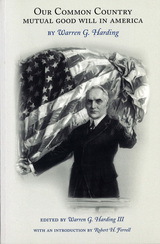 Our Common Country: Mutual Good Will in America
Warren G. Harding, Edited by Warren G. Harding, III, & Intro by Robert H. Ferrell
University of Missouri Press, 2003 Our Common Country is a collection of informal addresses, eighteen in all, given by Warren G. Harding as president-elect that defined his vision for the United States. What makes these addresses as relevant today as they were in 1921 is the unsettled mood of the country. Even though World War I is now a distant memory, today’s Americans have suffered through similar conflicts. In 1917 when Americans went off to war, the red, white, and blue flew everywhere. Two million American soldiers went to France and fifty thousand of them died; the battle of the Meuse-Argonne was one of the costliest in American history. With the announcement by America’s allies that the United States’s contributions to the war were insignificant compared to their own, President Wilson’s leadership began to collapse. Also, the domestic economy’s boom was turning to a bust and the national debt was expanding. The general consensus of Americans was that “things had gone to hell in a handbasket.” In an effort to ease the minds of troubled and confused Americans, President Harding tried to provide them with inspiration. Addressing different groups of the population—mothers, veterans, patriots, farmers, businessmen, the press—he sought to send a consistent personal message of reassurance. During his administration, he would bring a formal end to the war by signing the Treaty of Berlin and would limit strategic armaments through the treaties of the Washington Conference. He would also establish the Bureau of the Budget, thereby bringing order to the departmental and bureaucratic requests that had disgraced budget making for decades. He planted the seeds for a department of health, education, and welfare, which was finally realized thirty years later. Although the former president was much maligned after his death, his good works during his term of office speak for themselves and show concern for his fellow Americans. His warmth, strength of character, and intelligence are demonstrated throughout these addresses. Harding spoke to his own time, yet these addresses speak to our own confusing times as well.
Our Common Lands: Defending The National Parks
Edited by David J. Simon; Foreword by Joseph L. Sax
Island Press, 1988 This accessible book explains the complexities of key environmental laws and how they can be used to protect our national parks. It includes discussions of successful and unsuccessful attempts to use the laws and how the courts have interpreted them.
Our Country, The Planet: Forging A Partnership For Survival
Shridath Ramphal; Introduction by Seymour Topping
Island Press, 1992 Our Country, The Planet is a wide-ranging discussion of the global environmental crisis that accounts for the positions and perceptions of both developed and developing nations. As president of the World Conservation Union and the only person to have served on all five independent international commissions on global issues, Shridath Ramphal brings to his study a unique perspective and deep understanding of both development and the environment.
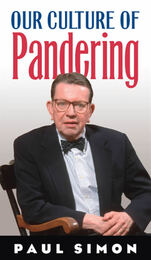 Our Culture of Pandering
Paul Simon
Southern Illinois University Press, 2006 As we broaden our views, embrace our differences, foster advancements in science and technology, and collaboratively strengthen the political, social, and educational underpinnings from which we build informed and productive lives, we have much to be proud of as a nation and as a people. But we are tempted—particularly during times of political unrest and unbridled patriotism—to ignore the far-reaching repercussions of a society that caters to money and power. In Our Culture of Pandering, former U.S. Senator Paul Simon interrogates the arenas of politics, media, religion, and education to decry the disturbing practices that confuse public service with profit-making ventures or popularity contests, that compromise the best interests of the broader population to appease a powerful few. Boldly and eloquently contributing to a cumulative understanding of how we can build a sturdier, more ethical foundation for the future, Simon suggests proactive, long-term solutions to the problems that threaten our country’s moral, financial, and intellectual well-being—problems that are increasingly exacerbated by our culture of pandering. Lest we grow complacent and our nation static, Simon urges us to demand more from the political candidates who chase dollar signs and cater to polls, to raise our expectations of local and national media outlets that recycle gossip and peddle scandals while foreign policy and international news receive back-page treatment or no treatment at all. He asks us to consider the implications of churches that spend more money remodeling their buildings than helping those in need within their own communities and throughout the world, and he presses us to acknowledge the staggering, long-term consequences of schools that drop their academic standards to sustain their reputations and maintain funding. Our Culture of Pandering is a stalwart and earnest call to action from a steadfast and trusted advocate of progressive public policy. Leavened with altruism and rich with compassion for citizens of America and beyond, present and future, this important and cautioning treatise advocates genuine leadership in the realms of politics, media, religion, and education. In his trademark lucid and synoptic style, Simon supplements up-to-date examples of pandering in our society from a breadth of sources with commentary and interpretive wisdom garnered from a lifetime of public service.
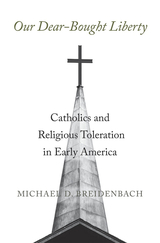 Our Dear-Bought Liberty: Catholics and Religious Toleration in Early America
Michael D. Breidenbach
Harvard University Press, 2021 How early American Catholics justified secularism and overcame suspicions of disloyalty, transforming ideas of religious liberty in the process.
In colonial America, Catholics were presumed dangerous until proven loyal. Yet Catholics went on to sign the Declaration of Independence and helped to finalize the First Amendment to the Constitution. What explains this remarkable transformation? Michael Breidenbach shows how Catholic leaders emphasized their church’s own traditions—rather than Enlightenment liberalism—to secure the religious liberty that enabled their incorporation in American life.
Catholics responded to charges of disloyalty by denying papal infallibility and the pope’s authority to intervene in civil affairs. Rome staunchly rejected such dissent, but reform-minded Catholics justified their stance by looking to conciliarism, an intellectual tradition rooted in medieval Catholic thought yet compatible with a republican view of temporal independence and church–state separation. Drawing on new archival material, Breidenbach finds that early American Catholic leaders, including Maryland founder Cecil Calvert and members of the prominent Carroll family, relied on the conciliarist tradition to help institute religious toleration, including the Maryland Toleration Act of 1649.
The critical role of Catholics in establishing American church–state separation enjoins us to revise not only our sense of who the American founders were, but also our understanding of the sources of secularism. Church–state separation in America, generally understood as the product of a Protestant-driven Enlightenment, was in key respects derived from Catholic thinking. Our Dear-Bought Liberty therefore offers a dramatic departure from received wisdom, suggesting that religious liberty in America was not bestowed by liberal consensus but partly defined through the ingenuity of a persecuted minority.
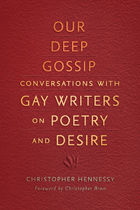 Our Deep Gossip: Conversations with Gay Writers on Poetry and Desire
Christopher Hennessy; Foreword by Christopher Bram
University of Wisconsin Press, 2013 From Walt Whitman forward, a century and a half of radical experimentation and bold speech by gay and lesbian poets has deeply influenced the American poetic voice. In Our Deep Gossip, Christopher Hennessy interviews eight gay men who are celebrated American poets and writers: Edward Field, John Ashbery, Richard Howard, Aaron Shurin, Dennis Cooper, Cyrus Cassells, Wayne Koestenbaum, and Kazim Ali. The interviews showcase the complex ways art and life intertwine, as the poets speak about their early lives, the friends and communities that shaped their work, the histories of gay writers before them, how sex and desire connect with artistic production, what coming out means to a writer, and much more. While the conversations here cover almost every conceivable topic of interest to readers of poetry and poets themselves, the book is an especially important, poignant, far-reaching, and enduring document of what it means to be a gay artist in twentieth- and early twenty-first-century America.
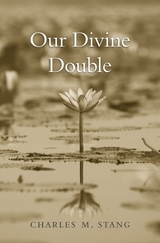 Our Divine Double
Charles M. Stang
Harvard University Press, 2016 What if you were to discover that you were not entirely you, but rather one half of a whole, that you had, in other words, a divine double? In the second and third centuries CE, this idea gripped the religious imagination of the Eastern Mediterranean, providing a distinctive understanding of the self that has survived in various forms throughout the centuries, down to the present. Our Divine Double traces the rise of this ancient idea that each person has a divine counterpart, twin, or alter-ego, and the eventual eclipse of this idea with the rise of Christian conciliar orthodoxy.
Charles Stang marshals an array of ancient sources: from early Christianity, especially texts associated with the apostle Thomas “the twin”; from Manichaeism, a missionary religion based on the teachings of the “apostle of light” that had spread from Mesopotamia to the Mediterranean; and from Neoplatonism, a name given to the renaissance of Platonism associated with the third-century philosopher Plotinus. Each of these traditions offers an understanding of the self as an irreducible unity-in-duality. To encounter one’s divine double is to embark on a path of deification that closes the gap between image and archetype, human and divine.
While the figure of the divine double receded from the history of Christianity with the rise of conciliar orthodoxy, it survives in two important discourses from late antiquity: theodicy, or the problem of evil; and Christology, the exploration of how the Incarnate Christ is both human and divine.
Our Earliest Tattoos: Poems
Peter Twal
University of Arkansas Press, 2018 Our Earliest Tattoos destabilizes traditional notions about memory, its permanence and supposed purity, with a simple premise: to remember is to enact violence against the body. Brazen, fragmentary, and intimate, these sonnets depict with astonishing creativity what can come of worshiping the past.
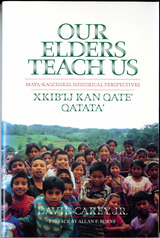 Our Elders Teach Us: Maya-Kaqchikel Historical Perspectives
David Anthony Carey, with a preface by Allan Burns
University of Alabama Press, 2001 In this rich and dynamic work, David Carey Jr. provides a new perspective on contemporary Guatemalan history by allowing the indigenous peoples to speak for themselves. Combining the methodologies of anthropology and history, Carey uses both oral interviews and meticulous archival research to construct a history of the last 130 years in Guatemala from the perspective of present-day Mayan people. His research took place over five years, including intensive language study, four summers of fieldwork, and a year-long residence in Comalapa, during which he conducted most of the 414 interviews. By casting a wide net for his interviews—from tiny hamlets to bustling Guatemala City—Carey gained insight into more than a single community or a single group of Maya. The Maya-Kaqchikel record their history through oral tradition; thus, few written accounts exist. Comparing the Kaqchikel point of view to that of the western scholars and Ladinos who have written most of the history texts, Carey reveals the people and events important to the Maya, which have been virtually written out of the national history. A motto of the Guatemalan organization Maya Decinio para el Pueblo Indigena (Maya Decade for the Indigenous People) is that people who do not know their past cannot build a future. By elucidating what the Kaqchikel think of their own past, Carey also illuminates the value of non-Western theoretical and methodological approaches that can be applied to the history of other peoples. Valuable to historians, anthropologists, archaeologists, or anyone interested in Mayan and Latin American studies, this book will inform as well as enchant.
Our Energy Future
Lincoln Davies
University of Utah Press, 2025 One of the greatest challenges of our time is the transition to clean energy. As climate change disrupts natural and human systems, a successful clean energy transition offers hope to a world upended by an overreliance on carbonbased fossil fuels.
In Our Energy Future, Lincoln Davies shines a bright light on the challenges the transition presents, including energy equity, political partisanship, the need for holistic solutions, and adaptability in the face of change. Our Energy Future makes the case for why the United States’ current transition to clean energy provides our world with something we so desperately need today: hope.
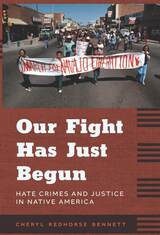 Our Fight Has Just Begun: Hate Crimes and Justice in Native America
Cheryl Redhorse Bennett
University of Arizona Press, 2022 Our Fight Has Just Begun is a timely and urgent work. The result of more than a decade of research, it revises history, documents anti-Indianism, and gives voice to victims of racial violence. Navajo scholar Cheryl Redhorse Bennett reveals a lesser-known story of Navajo activism and the courageous organizers that confronted racial injustice and inspired generations.
Illuminating largely untold stories of hate crimes committed against Native Americans in the Four Corners region of the United States, this work places these stories within a larger history, connecting historical violence in the United States to present-day hate crimes. Bennett contends that hate crimes committed against Native Americans have persisted as an extension of an “Indian hating” ideology that has existed since colonization, exposing how the justice system has failed Native American victims and families.
While this book looks deeply at multiple generations of unnecessary and ongoing pain and violence, it also recognizes that this is a time of uncertainty and hope. The movement to abolish racial injustice and racially motivated violence has gained fierce momentum. Our Fight Has Just Begun shows that racism, hate speech, and hate crimes are ever present and offers recommendations for racial justice.
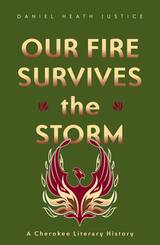 Our Fire Survives the Storm: A Cherokee Literary History
Daniel Heath Justice
University of Minnesota Press, 2006 Once the most powerful indigenous nation in the southeastern United States, the Cherokees survive and thrive as a people nearly two centuries after the Trail of Tears and a hundred years after the allotment of Indian Territory. In Our Fire Survives the Storm, Daniel Heath Justice traces the expression of Cherokee identity in that nation’s literary tradition.
Through cycles of war and peace, resistance and assimilation, trauma and regeneration, Cherokees have long debated what it means to be Cherokee through protest writings, memoirs, fiction, and retellings of traditional stories. Justice employs the Chickamauga consciousness of resistance and Beloved Path of engagement—theoretical approaches that have emerged out of Cherokee social history—to interpret diverse texts composed in English, a language embraced by many as a tool of both access and defiance.
Justice’s analysis ultimately locates the Cherokees as a people of many perspectives, many bloods, mingled into a collective sense of nationhood. Just as the oral traditions of the Cherokee people reflect the living realities and concerns of those who share them, Justice concludes, so too is their literary tradition a textual testament to Cherokee endurance and vitality.
Daniel Heath Justice is assistant professor of aboriginal literatures at the University of Toronto.
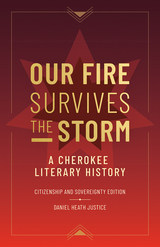 Our Fire Survives the Storm: A Cherokee Literary History, Citizenship and Sovereignty Edition
Daniel Heath Justice
University of Minnesota Press, 2026 The twentieth-anniversary edition of the path-clearing study of Cherokee writing in English, with an emphatic refocus on voices from the three Cherokee tribal nations
This Citizenship and Sovereignty Edition of Our Fire Survives the Storm is a thoroughly updated, nationhood-focused, twentieth-anniversary revision of Daniel Heath Justice’s influential study of Cherokee writing in English. Through politically astute and historically grounded readings of diverse texts by citizens of the Cherokee Nation, United Keetoowah Band of Cherokee Indians, and Eastern Band of Cherokee Indians, Justice connects Cherokee literature to Indigenous sovereignty, nationhood, and collective futurity. Guided by a reparative vision that directly contends with the outdated literary legacies of the book’s first edition, this revision confronts the ongoing harms of unsubstantiated and false Cherokee heritage claims on literary studies, replacing readings of primary texts by unverified claimants with those of Cherokee citizen writers. As Justice addresses issues of accountability, he engages with the past two decades of Indigenous scholarship, fully updating terminology, concepts, and scholarly resources. He expands and deepens the intellectual and historical context for Cherokee literary production introduced in the first edition, and he discusses Cherokee writing and community in the mid-twentieth century, the Cherokee Freedmen’s long struggle for justice, and the future of Cherokee nationhood. Highlighting the work of authors who illustrate the transformative collective discourses of what it means to be Cherokee, Justice examines the richness of Cherokee literary expression through motifs of roots, removal, and nationhood in traditional stories, speeches, legal and governance documents, memoirs, short stories, novels, and plays. An invitation to reflective criticism, this new edition of Our Fire Survives the Storm is grounded in the belief that Indigenous nationhood is a necessary ethical response to the violence of the settler imaginary. Retail e-book files for this title are screen-reader friendly with images accompanied by short alt text and/or extended descriptions.
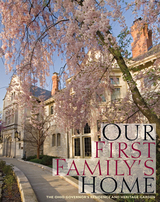 Our First Family’s Home: The Ohio Governor’s Residence and Heritage Garden
Mary Alice Mairose
Ohio University Press, 2008 This richly illustrated volume tells the story of thehome that has served as Ohio’s executive residence since 1957, and of the nine governors and their families who have lived in the house. Our First Family’s Home offers the first complete history of the residence and garden that represent Ohio to visiting dignitaries and the citizens of the state alike. Once in a state of decline, the house has been lovingly restored and improved by itsresidents. Development of the Ohio Heritage Garden has increased the educational potential of the house and has sparked an interest in the preservation of native plant species. Looking toward the future, the Residence is also taking the lead in promoting environmental issues such as solar powerand green energy. Photographs by award-winning environmental photographer Ian Adams and botanical art by Dianne McElwain showcase the beauty of the home’s architecture and the myriad of native plants that grace the three acres on which the Residence stands. Dianne McElwain is a member of the American Society of Botanical Artists in New York. Her botanical paintings have won numerous awards and are found in prestigious collections throughout the United States. Essays highlight the Jacobethan Revival architecture and the history of the home. The remaining pieces cover the garden and include an intimate tour of the Heritage Garden, which was inspired by Ohio’s diverse landscape. Finally, former Governor Ted Strickland and First Lady Frances Strickland discuss the increasing focus on green energy at the Governor’s Residence and First Lady Emerita Hope Taft explains how native plants can help sustain the environment.
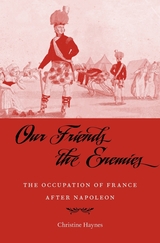 Our Friends the Enemies: The Occupation of France after Napoleon
Christine Haynes
Harvard University Press, 2018 The Napoleonic wars did not end with Waterloo. That famous battle was just the beginning of a long, complex transition to peace. After a massive invasion of France by more than a million soldiers from across Europe, the Allied powers insisted on a long-term occupation of the country to guarantee that the defeated nation rebuild itself and pay substantial reparations to its conquerors. Our Friends the Enemies provides the first comprehensive history of the post-Napoleonic occupation of France and its innovative approach to peacemaking.
From 1815 to 1818, a multinational force of 150,000 men under the command of the Duke of Wellington occupied northeastern France. From military, political, and cultural perspectives, Christine Haynes reconstructs the experience of the occupiers and the occupied in Paris and across the French countryside. The occupation involved some violence, but it also promoted considerable exchange and reconciliation between the French and their former enemies.
By forcing the restored monarchy to undertake reforms to meet its financial obligations, this early peacekeeping operation played a pivotal role in the economic and political reconstruction of France after twenty-five years of revolution and war. Transforming former European enemies into allies, the mission established Paris as a cosmopolitan capital and foreshadowed efforts at postwar reconstruction in the twentieth century.
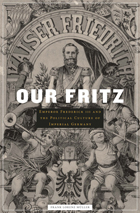 Our Fritz: Emperor Frederick III and the Political Culture of Imperial Germany
Frank Lorenz Müller
Harvard University Press, 2011 On June 15, 1888, a mere ninety-nine days after ascending the throne to become king of Prussia and German emperor, Frederick III succumbed to throat cancer. Europeans were spellbound by the cruel fate nobly borne by the voiceless Fritz, who for more than two decades had been celebrated as a military hero and loved as a kindly gentleman. A number of grief-stricken individuals reportedly offered to sacrifice their own healthy larynxes to save the ailing emperor.
Frank Lorenz Müller, in the first comprehensive life of Frederick III ever written, reconstructs how the hugely popular persona of “Our Fritz” was created and used for various political purposes before and after the emperor’s tragic death. Sandwiched between the reign of his ninety-year-old father and the calamitous rule of his own son, the future emperor William II, Frederick III served as a canvas onto which different political forces projected their hopes and fears for Germany's future. The book moves beyond the myth that Frederick’s humane liberalism would have built a lasting Anglo-German partnership, perhaps even preventing World War I, and beyond the castigations and exaggerations of parties with a different agenda. Surrounded by an unforgettable cast of characters that includes the emperor’s widely hated English wife, Vicky—daughter of Queen Victoria—and the scheming Otto von Bismarck, Frederick III offers in death as well as in life a revealing, poignant glimpse of Prussia, Germany, and the European world that his son would help to shatter.
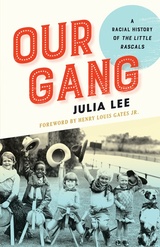 Our Gang: A Racial History of The Little Rascals
Julia Lee
University of Minnesota Press, 2015 It was the age of Jim Crow, riddled with racial violence and unrest. But in the world of Our Gang, black and white children happily played and made mischief together. They even had their own black and white version of the KKK, the Cluck Cluck Klams—and the public loved it. The story of race and Our Gang, or The Little Rascals, is rife with the contradictions and aspirations of the sharply conflicted, changing American society that was its theater. Exposing these connections for the first time, Julia Lee shows us how much this series, from the first silent shorts in 1922 to its television revival in the 1950s, reveals about black and white American culture—on either side of the silver screen. Behind the scenes, we find unconventional men like Hal Roach and his gag writers, whose Rascals tapped into powerful American myths about race and childhood. We meet the four black stars of the series—Ernie “Sunshine Sammy” Morrison, Allen “Farina” Hoskins, Matthew “Stymie” Beard, and Billie “Buckwheat” Thomas—the gang within the Gang, whose personal histories Lee pursues through the passing years and shifting political landscape. In their checkered lives, and in the tumultuous life of the series, we discover an unexplored story of America, the messy, multiracial nation that found in Our Gang a comic avatar, a slapstick version of democracy itself.
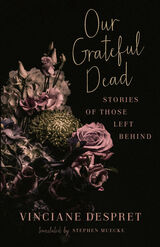 Our Grateful Dead: Stories of Those Left Behind
Vinciane Despret
University of Minnesota Press, 2021 An award-winning exploration of the presence of the dead in the lives of the living
A common remedy after suffering the loss of a loved one is to progress through the “stages of grief,” with “acceptance” as the final stage in the process. But is it necessary to leave death behind, to stop dwelling on the dead, to get over the pain? Vinciane Despret thinks not. In her fascinating, elegantly translated book, this influential thinker argues that, in practice, people in all cultures continue to enjoy a lively, inventive, positive relationship with their dead. Through her unique storytelling woven from ethnographic sources and her own family history, Despret assembles accounts of those who have found ways to live their daily lives with their dead. She rejects the idea that one must either subscribe to “complete mourning” (in a sense, to get rid of the dead) or else fall into fantasy and superstition. She explores instead how the dead still play an active, tangible role through those who are living, who might assume their place in a family or in society; continue their labor or art; or thrive from a shared inheritance or an organ donation. This is supported by dreams and voices, novels, television and popular culture, the work of clairvoyants, and the everyday stories and activities of the living. For decades now, in the West, the dead have been discreet and invisible. Today, especially as a result of the Covid-19 pandemic, Despret suggests that perhaps we will be willing to engage with the dead in ways that bring us happiness despite our loss. Despret’s unique method of inquiry makes her book both entertaining and instructive. Our Grateful Dead offers a new, pragmatic approach to social and cultural research and may indeed provide compassionate therapy for those of us coping with death.
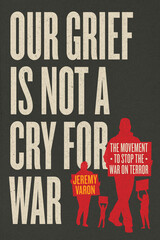 Our Grief Is Not a Cry for War: The Movement to Stop the War on Terror
Jeremy Varon
University of Chicago Press, 2025 An original history of the popular movement against the War on Terror—the greatest case of “we told you so” in modern political history.
Just after 9/11, President George W. Bush climbed the rubble where the World Trade Center had stood. Surrounded by shouts of anger, he said, “The people who knocked these buildings down will hear all of us soon!” With these words, Bush ushered in the War on Terror. Quickly, a global protest movement mobilized against it, reshaping the political, moral, and media landscape.
Jeremy Varon’s Our Grief Is Not a Cry for War is the definitive history of that movement. Millions of Americans participated in thousands of acts of protest, from demonstrations to civil disobedience to peace encampments in Iraq. On February 15, 2003, up to 30 million people worldwide took to the streets in the largest protest in human history. But this enormous outcry was not enough to stop the US invasion of Iraq. Varon explores the limits to the movement’s power but also shows how it worked to make opposition to the Iraq War a part of public debate, hastening its end and limiting the broader War on Terror. In the book, you’ll meet the families of the 9/11 victims, Iraq War veterans, and Gold Star families who spoke out against war.
Written with a lively and revelatory voice, Our Grief Is Not a Cry for War illuminates the passion of the peace movement, the mark it made, and the enduring legacies of the War on Terror.
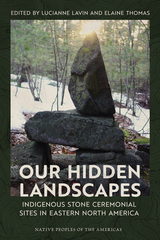 Our Hidden Landscapes: Indigenous Stone Ceremonial Sites in Eastern North America
Lucianne Lavin
University of Arizona Press, 2023 Challenging traditional and long-standing understandings, this volume provides an important new lens for interpreting stone structures that had previously been attributed to settler colonialism. Instead, the contributors to this volume argue that these locations are sacred Indigenous sites.
This volume introduces readers to eastern North America’s Indigenous ceremonial stone landscapes (CSLs)—sacred sites whose principal identifying characteristics are built stone structures that cluster within specific physical landscapes. Our Hidden Landscapes presents these often unrecognized sites as significant cultural landscapes in need of protection and preservation.
In this book, Native American authors provide perspectives on the cultural meaning and significance of CSLs and their characteristics, while professional archaeologists and anthropologists provide a variety of approaches for better understanding, protecting, and preserving them. The chapters present overwhelming evidence in the form of oral tradition, historic documentation, ethnographies, and archaeological research that these important sites created and used by Indigenous peoples are deserving of protection.
This work enables archaeologists, historians, conservationists, foresters, and members of the general public to recognize these important ritual sites.
Contributors
Nohham Rolf Cachat-Schilling
Robert DeFosses
James Gage
Mary Gage
Doug Harris
Julia A. King
Lucianne Lavin
Johannes (Jannie) H. N. Loubser
Frederick W. Martin
Norman Muller
Charity Moore Norton
Paul A. Robinson
Laurie W. Rush
Scott M. Strickland
Elaine Thomas
Kathleen Patricia Thrane
Matthew Victor Weiss
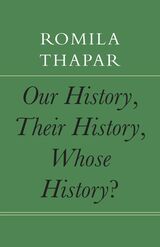 Our History, Their History, Whose History?
Romila Thapar
Seagull Books, 2023 An overview of nationalism and its impact on the study of history from one of India’s most prominent historians.
In this timely book, historian Romila Thapar delves into the complex world of nationalism and its impact on the interpretations of the past and on the discipline of history itself. History, she expounds, is no mere collection of information and chronology, and its purpose extends well beyond storytelling.
Recognizing nationalism as a powerful force that gives rise to various narratives that provide ancestry to communities and shape the direction of societies, Thapar explores how, in India, two conflicting notions of nationalism have evolved and shaped the idea of the nation. Today, one such nationalistic theory claims the victimization of one religious community by another through centuries of “misrule.” Such a claim willfully ignores ample evidence to the contrary to suit a particular political and ideological purpose. Thapar counters such attempts at misrepresentation by citing several historical instances of the nuanced interface and intermingling of cultures, as well as by showing how today’s conflicts have their roots in the British colonial construction of India’s history. She also addresses the recent controversy surrounding the deletions of sections of Indian history textbooks published by NCERT, the Indian educational council, and suggests that the intention is more likely to be the promotion of a particular reading of history that conforms to the ideology of those in power.
Engaging and thought-provoking, Our History, Their History, Whose History? invites readers to question the authenticity of historical narratives touted by one group of nationalists, and it explores the clash between professional historians who study the past to understand our inherited present and fabricators who wield history for political gain.
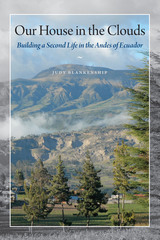 Our House in the Clouds: Building a Second Life in the Andes of Ecuador
By Judy Blankenship
University of Texas Press, 2013 While many baby boomers are downsizing to a simpler retirement lifestyle, photographer and writer Judy Blankenship and her husband Michael Jenkins took a more challenging leap in deciding to build a house on the side of a mountain in southern Ecuador. They now live half the year in Cañar, an indigenous community they came to know in the early nineties when Blankenship taught photography there. They are the only extranjeros (outsiders) in this homely, chilly town at 10,100 feet, where every afternoon a spectacular mass of clouds rolls up from the river valley below and envelopes the town. In this absorbing memoir, Blankenship tells the interwoven stories of building their house in the clouds and strengthening their ties to the community. Although she and Michael had spent considerable time in Cañar before deciding to move there, they still had much to learn about local customs as they navigated the process of building a house with traditional materials using a local architect and craftspeople. Likewise, fulfilling their obligations as neighbors in a community based on reciprocity presented its own challenges and rewards. Blankenship writes vividly of the rituals of births, baptisms, marriages, festival days, and deaths that counterpoint her and Michael’s solitary pursuits of reading, writing, listening to opera, playing chess, and cooking. Their story will appeal to anyone contemplating a second life, as well as those seeking a deeper understanding of daily life in the developing world.
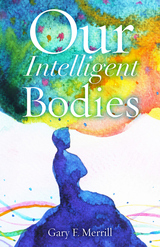 Our Intelligent Bodies
Gary F. Merrill
Rutgers University Press, 2020 Human intelligence isn’t just located in the brain. Our bodies are marvelously sophisticated and complex, with a variety of autonomic systems that help maintain our health without us ever having to think about them. But how exactly do all these physiological structures actually work?
In Our Intelligent Bodies, physiology professor Gary F. Merrill takes you on a guided tour through the human body. You’ll learn how our eyes are designed to detect unimaginably small bursts of light and how our ears contain bundles of tiny hairs, each one attuned to different sound frequencies. You’ll also discover how our hearts are smart enough to compensate for skipped beats and irregular rhythms and how our pulmonary system adjusts for low oxygen levels. You’ll even find out why the gut is sometimes called the “second brain,” its reflexes controlled by millions of neurons.
Written in a fun, easy-to-comprehend style and filled with illuminating analogies, Our Intelligent Bodies also brings readers up to date on cutting-edge research into the wonders of human physiology. It will give you a new appreciation for the smart decisions our bodies are making when our brains aren’t paying attention.
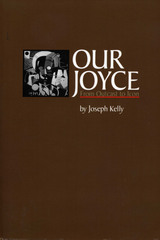 Our Joyce: From Outcast to Icon
By Joseph Kelly
University of Texas Press, 1997 James Joyce began his literary career as an Irishman writing to protest the deplorable conditions of his native country. Today, he is an icon in a field known as "Joyce studies." Our Joyce explores this amazing transformation of a literary reputation, offering a frank look into how and for whose benefit literary reputations are constructed. Joseph Kelly looks at five defining moments in Joyce's reputation. Before 1914, when Joyce was most in control of his own reputation, he considered himself an Irish writer speaking to the Dublin middle classes. When T. S. Eliot and Ezra Pound began promoting Joyce in 1914, however, they initiated a cult of genius that transformed Joyce into a prototype of the "egoist," a writer talking only to other writers. This view served the purposes of Morris Ernst in the 1930s, when he defended Ulysses against obscenity charges by arguing that geniuses were incapable of obscenity and that they wrote only for elite readers. That view of Joyce solidified in Richard Ellmann's award-winning 1950s biography, which portrayed Joyce as a self-centered genius who cared little for his readers and less for the world at war around him. The biography, in turn, led to Joyce's canonization by the academy, where a "Joyce industry" now flourishes within English departments.
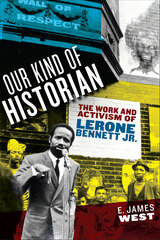 Our Kind of Historian: The Work and Activism of Lerone Bennett Jr.
E. James West
University of Massachusetts Press, 2022 Journalist, activist, popular historian, and public intellectual, Lerone Bennett Jr. left an indelible mark on twentieth-century American history and culture. Rooted in his role as senior editor of Ebony magazine, but stretching far beyond the boundaries of the Johnson Publishing headquarters in Chicago, Bennett’s work and activism positioned him as a prominent advocate for Black America and a scholar whose writing reached an unparalleled number of African American readers. This critical biography—the first in-depth study of Bennett’s life—travels with him from his childhood experiences in Jim Crow Mississippi and his time at Morehouse College in Atlanta to his later participation in a dizzying range of Black intellectual and activist endeavors. Drawing extensively on Bennett’s previously inaccessible archival collections at Emory University and Chicago State, as well as interviews with close relatives, colleagues, and confidantes, Our Kind of Historian celebrates his enormous influence within and unique connection to African American communities across more than half a century of struggle.
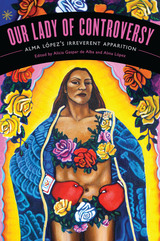 Our Lady of Controversy: Alma López's “Irreverent Apparition”
Edited by Alicia Gaspar de Alba and Alma López
University of Texas Press, 2011 Months before Alma López's digital collage Our Lady was shown at the Museum of International Folk Art in 2001, the museum began receiving angry phone calls from community activists and Catholic leaders who demanded that the image not be displayed. Protest rallies, prayer vigils, and death threats ensued, but the provocative image of la Virgen de Guadalupe (hands on hips, clad only in roses, and exalted by a bare-breasted butterfly angel) remained on exhibition. Highlighting many of the pivotal questions that have haunted the art world since the NEA debacle of 1988, the contributors to Our Lady of Controversy present diverse perspectives, ranging from definitions of art to the artist's intention, feminism, queer theory, colonialism, and Chicano nationalism. Contributors include the exhibition curator, Tey Marianna Nunn; award-winning novelist and Chicana historian Emma Pérez; and Deena González (recognized as one of the fifty most important living women historians in America). Accompanied by a bonus DVD of Alma López's I Love Lupe video that looks at the Chicana artistic tradition of reimagining la Virgen de Guadalupe, featuring a historic conversation between Yolanda López, Ester Hernández, and Alma López, Our Lady of Controversy promises to ignite important new dialogues.
Our Lady of Guadalupe: Faith and Empowerment among Mexican-American Women
By Jeanette Rodriguez
University of Texas Press, 1994 Our Lady of Guadalupe is the most important religious symbol of Mexico and one of the most powerful female icons of Mexican culture. In this study, based on research done among second-generation Mexican-American women, Rodriguez examines the role the symbol of Guadalupe has played in the development of these women. She goes beyond the thematic and religious implications of the symbol to delve into its relevance to their daily lives. Rodriguez's study offers an important reinterpretation of one of the New World's most potent symbols. Her conclusions dispute the common perception that Guadalupe is a model of servility and suffering. Rather, she reinterprets the symbol of Guadalupe as a liberating and empowering catalyst for Mexican-American women.
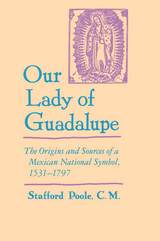 Our Lady of Guadalupe: The Origins and Sources of a Mexican National Symbol, 1531–1797
Stafford Poole
University of Arizona Press, 1995 The devotion to Our Lady of Guadalupe, based on the story of apparitions of the Virgin Mary to Juan Diego, an Indian neophyte, at the hill of Tepeyac in December 1531, is one of the most important formative religious and national symbols in the history of Mexico. In this first work ever to examine in depth every historical source of the Guadalupe apparitions, Stafford Poole traces the origins and history of the account, and in the process challenges many commonly accepted assumptions and interpretations. Poole finds that, despite common belief, the apparition account was unknown prior to 1648, when it was first published by a Mexican priest. And then, the virgin became the predominant devotion not of the Indians, but of the criollos, who found in the story a legitimization of their own national aspirations and an almost messianic sense of mission and identity. Poole finds no evidence of a contemporary association of the Virgin of Guadalupe with the Mexican goddess Tonantzin, as is frequently assumed, and he rejects the common assertion that the early missionaries consciously substituted Guadalupe for a preconquest deity.
Our Lady of Guadalupe: The Origins and Sources of a Mexican National Symbol, 1531–1797
Stafford Poole
University of Arizona Press, 2017 For decades, Stafford Poole has stood at the forefront of scholarship on the historicity of the Virgin of Guadalupe, an icon that serves as one of the most important formative religious and national symbols in the history of Mexico. Poole’s groundbreaking first edition of Our Lady of Guadalupe was the first ever to examine in depth every historical source of the Guadalupe apparitions. In this revised edition, Poole employs additional sources and commentary to further challenge common interpretations and assumptions about the Guadalupan tradition.
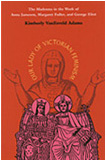 Our Lady Of Victorian Feminism: The Madonna in the Work of Anna Jameson, Margaret Fuller, and George Eliot
Kimberly VanEsveld Adams
Ohio University Press, 2000 Our Lady of Victorian Feminism is about three nineteenth-century women, Protestants by background and feminists by conviction, who are curiously and crucially linked by their extensive use of the Madonna in arguments designed to empower women.
In the field of Victorian studies, few scholars have looked beyond the customary identification of the Christian Madonna with the Victorian feminine ideal—the domestic Madonna or the Angel in the House. Kimberly VanEsveld Adams shows, however, that these three Victorian writers made extensive use of the Madonna in feminist arguments. They were able to see this figure in new ways, freely appropriating the images of independent, powerful, and wise Virgin Mothers.
In addition to contributions in the fields of literary criticism, art history, and religious studies, Our Lady of Victorian Feminism places a needed emphasis on the connections between the intellectuals and the activists of the nineteenth-century women's movement. It also draws attention to an often neglected strain of feminist thought, essentialist feminism, which proclaimed sexual equality as well as difference, enabling the three writers to make one of their most radical arguments, that women and men are made in the image of the Virgin Mother and the Son, the two faces of the divine.
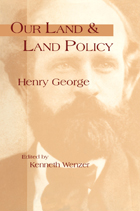 Our Land & Land Policy: Speeches Lectures, and Miscellaneous Writings
Kenneth C. Wenzer
Michigan State University Press, 1999 Even before the publication of Progress and Poverty in 1879, San Francisco political economist and publisher Henry George (1839-1897) had written extensively about what he considered to be the causes for worldwide economic inequity—land monopolization and speculation by wealthy entrepreneurs and corrupt politicians. But his attacks on these evils were coupled with a plan for a possible brighter future, for a world in which disparities between people of different classes could be adjusted. By the time he died in 1897, his assessments of liberal 19th-century economic theory were critically acclaimed in Europe and the United States.
Michigan State University Press's new edition of Our Land and Land Policy includes the texts of speeches George delivered and essays he published during three decades of political activism. These pieces were chosen originally in 1901 by George's son, Henry George, Jr., to portray the expansiveness and depth of his father's philosophy and the sincerity with which the elder George struggled throughout his life for social justice.
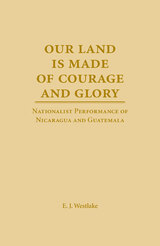 Our Land is Made of Courage and Glory: Nationalist Performance of Nicaragua and Guatemela
E. J. Westlake
Southern Illinois University Press, 2005 Our Land Is Made of Courage and Glory: Nationalist Performance of Nicaragua and Guatemala adds to a growing and timely body of work on nationalist drama. Examining important twentieth-century plays that few people have written about in English, E. J. Westlake analyzes the phenomenon of nation as performance by focusing on the definition of a people, national metaphors, and the uses of national history. Westlake discerns the common characteristics that constitute nationalist plays, a genre that seeks to legitimate the nature of a nation by defining its boundaries, race, language, citizens, and history. Particularly relevant in an era influenced by imperialism, migration, and globalization, the volume probes the concepts of nation and nationalism in the context of postcolonial literary and performance theory. Our Land Is Made of Courage and Glory covers the political and theatrical history of Nicaragua and Guatemala. Westlake examines how the blending of races factors into nationalism with a look at the play El tren amarillo by Manuel Galich and uses Nobel laureate Miguel Ángel Asturias’s Soluna to show how nationalists appropriate Mayan culture to create a sense of the Guatemalan people and culture. She discusses the mapping of history as a linear progression in Alan Bolt’s Banana republic and as a cycle of patricide in Por los caminos van los campesinos by Pablo Cuadra. Westlake also suggests that Rolando Steiner’s La noche de Wiwilí, a play taken from an eyewitness account, acts as a site of official national memory, and she examines as well the canonizing of the folk ballet El Güegüence to further explore the notion of sites of memory versus lived memory. Raising essential questions about the future of nationalism and nationalist performance, Our Land Is Made of Courage and Glory will be of interest to scholars and students in drama, Latin American theatre studies, political science, and history.
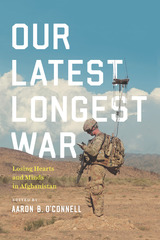 Our Latest Longest War: Losing Hearts and Minds in Afghanistan
Edited by Aaron B. O'Connell
University of Chicago Press, 2017 The first rule of warfare is to know one’s enemy. The second is to know thyself. More than fifteen years and three quarters of a trillion dollars after the US invasion of Afghanistan, it’s clear that the United States followed neither rule well.
America’s goals in Afghanistan were lofty to begin with: dismantle al Qaeda, remove the Taliban from power, remake the country into a democracy. But not only did the mission come completely unmoored from reality, the United States wasted billions of dollars, and thousands of lives were lost. Our Latest Longest War is a chronicle of how, why, and in what ways the war in Afghanistan failed. Edited by historian and Marine lieutenant colonel Aaron B. O’Connell, the essays collected here represent nine different perspectives on the war—all from veterans of the conflict, both American and Afghan. Together, they paint a picture of a war in which problems of culture and an unbridgeable rural-urban divide derailed nearly every field of endeavor. The authors also draw troubling parallels to the Vietnam War, arguing that deep-running ideological currents in American life explain why the US government has repeatedly used armed nation-building to try to transform failing states into modern, liberal democracies. In Afghanistan, as in Vietnam, this created a dramatic mismatch of means and ends that neither money, technology, nor the force of arms could overcome.
The war in Afghanistan has been the longest in US history, and in many ways, the most confounding. Few who fought in it think it has been worthwhile. These are difficult topics for any American or Afghan to consider, especially those who lost friends or family in it. This sobering history—written by the very people who have been fighting the war—is impossible to ignore.
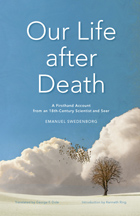 Our Life after Death: A Firsthand Account from an 18th-Century Scientist and Seer
Emanuel Swedenborg
Swedenborg Foundation Publishers, 2013 In his classic Heaven and Hell, Swedenborg takes the reader on a journey through the afterlife, describing the spiritual world in intricate detail. Our Life after Death is a collection of writings from that volume that focus specifically on what happens to us as we cross over and what we experience as new souls in the world of spirits, where we prepare to find our soul’s permanent home.
Swedenborg tells us that it is not God who judges people and send them to either heaven or hell, but rather it is we who judge ourselves. In this book Swedenborg reveals the process by which people confront who they were on earth, discover their true selves, and use that self-knowledge to discover their final home in the afterlife.
An introduction by near-death researcher Dr. Kenneth Ring draws parallels between Swedenborg’s experiences and those of millions of modern people who have had near-death experiences. This book provides a brief but thought-provoking introduction to Swedenborg’s afterlife for those who want to delve deeper into this fascinating subject.
 Our Little Life: A Novel with Other Archival Texts
By José Antonio Villarreal, edited by Juan Velasco
Lever Press, 2025 Our Little Life is the original title of José Antonio Villarreal’s groundbreaking 1959 novel Pocho, which shaped Mexican-American literature for decades. Pocho narrated the experiences of and challenges to the Mexican-American community in 1930s Silicon Valley through the story of Richard Rubio and his family, ending with the U.S.’s entry into World War II. With this new edition, author and editor Juan Velasco restores Villarreal’s original vision for his novel. Published in cooperation with the Villarreal estate, this edition of Our Little Life is based on archival materials from the Villarreal Special Collection at Santa Clara University.
Our Little Life offers a much longer version of the Pocho story that extends a further 100 pages into the postwar period and follows Richard Rubio’s return from war and the changing shape of Mexican-American life in the 1940s. This newly discovered manuscript reveals Villarreal’s attention to Rubio’s struggles with PTSD and his efforts to depict a community and a family’s struggles with identity, belonging, and survival in postwar California. Our Little Life is an important work of archival recovery that sheds new light on Villarreal’s authorship and his place not only in Mexican-American literature but in the twentieth-century American literary canon.
This first publication of Our Little Life includes a scholarly introduction that places this unpublished novel in the landscape of contemporary Mexican-American literary studies and offers a brilliant examination of how novels grow and change. The volume also includes materials from the Villarreal Special Collection that recontextualize the writer’s vision, editing, and marketing of this and later novels. Our Little Life will be of interest not only to everyone in Mexican-American literary studies, but also to scholars of postwar America, women and gender studies, LGBTQ studies, ethnic studies, and migration and border studies.
 Our Long Heritage: Pages From the Books our Founding Fathers Read
Wilson O. Clough
University of Minnesota Press, 1955 Our Long Heritage was first published in 1955. Minnesota Archive Editions uses digital technology to make long-unavailable books once again accessible, and are published unaltered from the original University of Minnesota Press editions. This collection of readings, selected from the books and documents that were the major sources of American ideas and beliefs during the period of the founding of the democracy from 1750 to 1780, demonstrates that America has a long heritage behind its social and political philosophy. The excerpts are from the works that represent four different cultural or historical heritage, and they are presented in this order: the classical heritage, the English tradition to 1700, the continental stream, and the eighteenth century, both British and American. Mr. Clough, a former professor of English at the University of Wyoming, provides introductory and explanatory comment throughout the volume. The first book of its kind, it should be particularly useful in American studies programs.
 Our Magnetic Earth: The Science of Geomagnetism
Ronald T. Merrill
University of Chicago Press, 2010 For the general public, magnetism often seems more the province of new age quacks, movie mad scientists, and grade-school teachers than an area of actual, ongoing scientific inquiry.
But as Ronald T. Merrill reveals in Our Magnetic Earth, geomagnetism really is an enduring, vibrant area of science, one that offers answers to some of the biggest questions about our planet’s past—and maybe even its future. In a clear and careful fashion, he lays out the physics of geomagnetism and magnetic fields, then goes on to explain how Earth’s magnetic field provides crucial evidence for our understanding of continental drift and plate tectonics; how and why animals, ranging from bacteria to mammals, sense and use the magnetic field; how changes in climate over eons can be studied through variations in the magnetic field in rocks; and much more. Throughout, Merrill peppers his scientific account with bizarre anecdotes and fascinating details, from levitating pizzas to Moon missions to blackmailing KGB agents—a reminder that real science can at times be stranger, and more amusing, than fiction.
A winning primer for anyone who has ever struggled with a compass or admired a ragged V of migrating geese, Our Magnetic Earth demonstrates that education and entertainment need not be polar opposites.
 Our Man in Warszawa: How the West Misread Poland
Jo Harper
Central European University Press, 2021 Written by a Brit who has lived in Poland for more than twenty years, this book challenges some accepted thinking in the West about Poland and about the rise of Law and Justice (PiS) as the ruling party in 2015. It is a remarkable account of the Polish post-1989 transition and contemporary politics, combining personal views and experience with careful fact and material collections. The result is a vivid description of the events and scrupulous explanations of the political processes, and all this with an interesting twist – a perspective of a foreigner and insider at the same time. Settled in the position of participant observer, Jo Harper combines the methods of macro and micro analysis with CDA, critical discourse analysis. He presents and interprets the constituent elements and issues of contemporary Poland: the main political forces, the Church, the media, issues of gender, the Russian connection, the much-disputed judicial reform and many others. A special feature of the book is the detailed examination of the coverage of the Poland’s latest two elections, one in 2019 (parliamentary) and the other in 2020 (presidential) in the British media, an insightful and witty specimen of comparative cultural and political analysis.
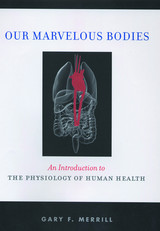 Our Marvelous Bodies: An Introduction to the Physiology of Human Health
Merrill, Gary F
Rutgers University Press, 2008 Our Marvelous Bodies offers a unique perspective on the structure, function, and care of the major systems of the human body. Unlike other texts that use a strictly scientific approach, physiologist Gary F. Merrill relays medical facts alongside personal stories that help students relate to and apply the information. Readers learn the basics of feedback control systems, homeostasis, and physiological gradients. These principles apply to an understanding of the body’s functioning under optimal, healthy conditions, and they provide insight into states of acute and chronic illness. Separate chapters are devoted to each of the body’s systems in detail: nervous, endocrine, cardiovascular, respiratory, renal, gastrointestinal, musculoskeletal, reproductive, and immune. Through a series of real-life examples, the book also shows the importance of maintaining careful medical records for health care professionals, scientists, and patients alike.
 Our Moonlight Revels: "A Midsummer Night's Dream" in the Theatre
Gary Jay Williams
University of Iowa Press, 1997 Many ingenious theatrical worlds have been created for the fairy world of A Midsummer Night's Dream, from the baroque to the postmodern. This is the quintessential play for understanding the ways in which scenery, costumes, music, lighting, and playing spaces affect our experience of Shakespeare. A Midsummer Night's Dream also proves to be extraordinarily responsive to the cultural winds of each era, easily circulating a variety of sometimes competing social interests. In his richly detailed, beautifully illustrated history of Shakespeare's most popular play—the first comprehensive study of A Midsummer Night's Dream in the theatre—Gary Jay Williams covers four hundred years of landmark productions in Europe, the United States, and Canada as well as important opera, dance, and film adaptations. Williams shows how the visual and musical vocabularies of production can be read as cultural texts and how these meditative texts determine this play's available meanings from generation to generation. His account, then, is the story of our imaginative and astonishing uses of Shakespeare's play. Many famous theatre artists have been drawn to this play, and many of their productions have been turning points in theatre history. Williams offers detailed theatrical and cultural analyses of the productions of David Garrick, Ludwig Tieck, Elizabeth Vestris, Charles Kean, Harley Granville-Barker, Sir Herbert Beerbohm Tree, Max Reinhardt, Peter Brook, Liviu Ciulei, and other artists. His engaging, intelligent study will be invaluable to scholars and teachers of Shakespeare and theatre history and to professional directors, designers, critics, and actors. •The Wedding-play Myth and the Dream in Full Play •Shakespeare Absolute: Fairies, Gods, and Oranges in Purcell's Fairy Queen •“Signor Shakespearelli” •The Scenic Language of Empire •These Antique Fables . . . These Fairy Toys” •The National and Natural Dream •The Dream of Modernism: The “New Hieroglyphic Language of Scenery” and the Theology of the Text •The Dream of Modernism: The Sacred and the Secular •Postmodernism: “The Fierce Vexation of a Dream”
 Our Movie Heritage
Tom McGreevey and Joanne L Yeck
Rutgers University Press, 1997 ÒOur Movie Heritage is both a vividly illustrated encyclopedia and a suspense story replete with heroes and heroines and an imperiled treasure of such great worth that one feels impelled to ride to its rescue.ÓÑOlivia deHavillandÒThis book reads like a suspense story. Will we care enough, it asks, to save the rest of our great movie heritage before itÕs too late? For all of us who love the movies there can only be one answer.ÓÑFay Kanin, chair of the National Film Preservation Board Our Movie Heritage should be read by anyone interested in motion picture history. Without film preservation, there can be no valid film history. Documents, autobiographies, oral histories, and secondary sources are of importance, but viewing the actual films preserved or restored to a state comparable to the way they were originally viewed is of inestimable importance.Rudy Behlmer, film historian and author of Memo from David O. Selznick Our Movie Heritage is an enticing, up to the minute account of the complex National Film preservation effort, and should be read by anyone interested in our rich cinematic heritage.Mary Lea Bandy, chief curator, The Museum of Modern Art Imagine an America without any images of itself no Judy Garland in the Wizard of Oz, no Orson Welles in Citizen Kane, and no Bogart and Bergman in Casablanca. Movies are an extraordinary personal and collective history of the American people. Unfortunately, over 90 percent of America's silent films are already lost to us, and more than half of the American feature films made before 1950 no longer exist. Whether it is a piece of cellulose nitrate exposed in 1910 or a strip of Eastman Color acetate stock produced in the 1970s all film self-destructs. Rapidly. Our Movie Heritage is a highly readable and informative view of the world of film preservation, showing the work being done to save our national treasure trove of film history. Full of tales of discovery and rescue, the book is an urgent plea for preservation. Our Movie Heritage describes the race against time currently under way both in the public and private sectors in order to salvage what is left in vaults, theaters, and private collections. The book explains the basics of film preservation, covering the who, what, when, where, and how of the field, with top archivists and film restoration experts expressing their concerns and hopes for the future of movies. This beautifully produced book, with over one hundred pictures of top stars, directors, and film people, is itself a treasure that showcases the importance of this legacy.
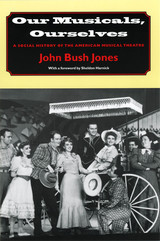 Our Musicals, Ourselves: A Social History of the American Musical Theatre
John Bush Jones
Brandeis University Press, 2004 Our Musicals, Ourselves is the first full-scale social history of the American musical theater from the imported Gilbert and Sullivan comic operas of the late nineteenth century to such recent musicals as The Producers and Urinetown. While many aficionados of the Broadway musical associate it with wonderful, diversionary shows like The Music Man or My Fair Lady, John Bush Jones instead selects musicals for their social relevance and the extent to which they engage, directly or metaphorically, contemporary politics and culture. Organized chronologically, with some liberties taken to keep together similarly themed musicals, Jones examines dozens of Broadway shows from the beginning of the twentieth century to the present that demonstrate numerous links between what played on Broadway and what played on newspapers’ front pages across our nation. He reviews the productions, lyrics, staging, and casts from the lesser-known early musicals (the “gunboat” musicals of the Teddy Roosevelt era and the “Cinderella shows” and “leisure time musicals” of the 1920s) and continues his analysis with better-known shows including Showboat, Porgy and Bess, Oklahoma, South Pacific, West Side Story, Cabaret, Hair, Company, A Chorus Line, and many others. While most examinations of the American musical focus on specific shows or emphasize the development of the musical as an art form, Jones’s book uses musicals as a way of illuminating broader social and cultural themes of the times. With six appendixes detailing the long-running diversionary musicals and a foreword by Sheldon Harnick, the lyricist of Fiddler on the Roof, Jones’s comprehensive social history will appeal to both students and fans of Broadway.
Our Nanotechnology Future
Joseph B. Natowitz and Christian Ngô
Amsterdam University Press, 2017 This book explores nanotechnology, a rapidly evolving and growing field with applications in a large number of areas. The concepts and physics are highlighted through topics such as nanoscience, quantum effects, nanostructures, and new forms of carbon. Applications and potential health and safety implications of nanomaterials are discussed for healthcare, food production, electronics, defence and more. Accessible and timely, this introduction to nanotechnology will interest students, teachers, politicians, and everyone else eager to learn more about this dynamic field.
 Our National Park System: Caring for America's Greatest Natural and Historic Treasures
Dwight F. Rettie
University of Illinois Press, 1995 This is the first comprehensive look at America's national park system, an insider's tour covering the system and the National Park Service, the agency responsible for its care. Dwight F. Rettie, former chief of the NPS policy development office, is uniquely qualified to address the state--the problems and the possibilities--of the system, which is comprised of millions of acres of land in more than 350 areas around the nation, including historic sites, battlefields, and recreation areas.
Rettie agrees, as many critics have claimed, that the system is in disarray; he proposes in detail stronger management operations, clearer and more stringent measures of personnel performance, and training of park rangers to help them become professionals knowledgeable about the scientific management and protection of resources.
For a concerned public as well as for policy-makers and students of government, this comprehensive analysis and outline may provide hope--and a future--for the invaluable legacy that is our national park system.
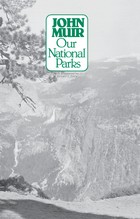 Our National Parks
John Muir
University of Wisconsin Press, 1981 Our National Parks is a guidebook supreme, an exciting introduction to Yosemite and several other magnificent parks by the man who, more than any other person, helped to create them. After this fast-paced trip with Muir, past visitors to the parks will want to revisit them with new insights, and those who have never wandered these trails will not rest until they have done so.
The book, long out of print, was originally published in 1901, its ten essays having previously appeared as articles in the Atlantic Monthly. Muir wrote them with a single purpose—to entice people, by his descriptions, to come to the parks, to see and enjoy them. If enough people did so, reasoned Muir, they would surely love the wilderness as he did, and the parks would be preserved.
Muir carried out his public relations mission with remarkable success. Every page of this book carries his unbridled and irresistible enthusiasm. Our National Parks is part reminiscence, part philosophy, and mostly enticing description. It is all vintage Muir.
Although the book treats Yellowstone, Sequoia, General Grant, and other national parks of the Western U.S., Muir devotes the bulk of the work to his first love—Yosemite, settled into the heart of the Sierra Nevada. Indeed, six of the book’s chapters are devoted to Yosemite, treating the forests, wild gardens, fountains and streams, animals, and birds of the park. The concluding essay is an impassioned plea to save American forests.
All visitors to the great western national parks—and all who will one day visit them—will be captivated by Muir’s descriptions. The grandeur of this wilderness is reflected in the very spirit of John Muir. Both shine through every page of this remarkable book.
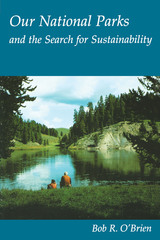 Our National Parks and the Search for Sustainability
By Bob R. O'Brien
University of Texas Press, 1999 "Yosemite Valley in July of 1967 would have had to be seen to be believed. There was never an empty campsite in the valley; you had to create a space for yourself in a sea of cars, tents, and humanity.... The camp next to ours had fifty people in it, with rugs hung between the trees, incense burning, and a stereo set going full volume." Scenes such as this will probably never be repeated in Yosemite or any other national park, yet the urgent problem remains of balancing the public's desire to visit the parks with the parks' need to be protected from too many people and cars and too much development. In this book, longtime park visitor and professional geographer Bob O'Brien explores the National Park Service's attempt to achieve "sustainability"—a balance that allows as many people as possible to visit a park that is kept in as natural a state as possible. O'Brien details methods the NPS has used to walk the line between those who would preserve vast tracts of land for "no use" and those who would tap the Yellowstone geysers to generate electricity. His case studies of six western "crown jewel" parks show how rangers and other NPS employees are coping with issues that impact these cherished public landscapes, including visitation, development, and recreational use.
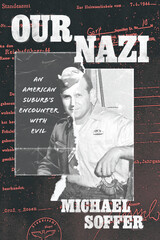 Our Nazi: An American Suburb’s Encounter with Evil
Michael Soffer
University of Chicago Press, 2024 The first book to lay bare the life of a Nazi camp guard who settled in a Chicago suburb and to explore how his community and others responded to discoveries of Nazis in their midst.
Reinhold Kulle seemed like the perfect school employee. But in 1982, as his retirement neared, his long-concealed secret came to light. The chief custodian at Oak Park and River Forest High School outside Chicago had been a Nazi, a member of the SS, and a guard at a brutal slave labor camp during World War II.
Similar revelations stunned communities across the country. Hundreds of Reinhold Kulles were gradually discovered: men who had patrolled concentration camps, selected Jews for execution, and participated in mass shootings—and who were now living ordinary suburban lives. As the Office of Special Investigations raced to uncover Hitler’s men in the United States, neighbors had to reconcile horrific accusations with the helpful, kind, and soft-spoken neighbors they thought they knew. Though Nazis loomed in the American consciousness as evil epitomized, in Oak Park—a Chicago suburb renowned for its liberalism—people rose to defend Reinhold Kulle, a war criminal.
Drawing on archival research and insider interviews, Oak Park and River Forest High School teacher Michael Soffer digs into his community’s tumultuous response to the Kulle affair. He explores the uncomfortable truths of how and why onetime Nazis found allies in American communities after their gruesome pasts were uncovered.
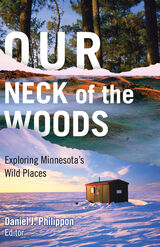 Our Neck of the Woods: Exploring Minnesota's Wild Places
Daniel J. Philippon
University of Minnesota Press, 2009 What are the odds of finding Minnesota's tiniest orchid? Why take a Breathalyzer test to study frogs? How does ice fishing warm the heart? Who would live in such a cold, lean region? Our Neck of the Woods takes on these and other urgent (and sometimes quirky) questions, showcasing writers' own experiences in the best-loved places in Minnesota, including the North Shore, Lake Bemidji, the western prairies and grasslands, the Boundary Waters, and the Mesabi Iron Range. The outdoor experiences described here range from sweeping natural history observations to adventurous tales of coming-of-age camping and hunting trips. We follow notable writers and conservationists Sigurd F. Olson, Paul Gruchow, Bill Holm, Jan Zita Grover, Greg Breining, Laurie Allmann, and many others as they descend a frozen river toward Lake Superior, explore a crystalline palace at minus 20 degrees, and trace a family's history along the Mississippi River. Writing on such themes as embracing winter, making camp, and finding wildness even amid development, these authors tell of hunting, fishing, birding, canoeing, and other great outdoor activities that help define what it means to be Minnesotan. Drawn from the pages of Minnesota Conservation Volunteer magazine-published by the Department of Natural Resources since 1940-these writings evoke a strong sense of place and suggest that the outdoor experiences we share with others come to mean the most to us. With rich observations and spirited tales, Our Neck of the Woods beckons Minnesotans to work, play, and explore in the natural places close to their homes and hearts.
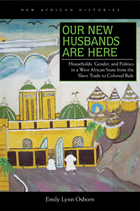 Our New Husbands Are Here: Households, Gender, and Politics in a West African State from the Slave Trade to Colonial Rule
Emily Lynn Osborn
Ohio University Press, 2011 In Our New Husbands Are Here, Emily Lynn Osborn investigates a central puzzle of power and politics in West African history: Why do women figure frequently in the political narratives of the precolonial period, and then vanish altogether with colonization? Osborn addresses this question by exploring the relationship of the household to the state. By analyzing the history of statecraft in the interior savannas of West Africa (in present-day Guinea-Conakry), Osborn shows that the household, and women within it, played a critical role in the pacifist Islamic state of Kankan-Baté, enabling it to endure the predations of the transatlantic slave trade and become a major trading center in the nineteenth century. But French colonization introduced a radical new method of statecraft to the region, one that separated the household from the state and depoliticized women’s domestic roles. This book will be of interest to scholars of politics, gender, the household, slavery, and Islam in African history.
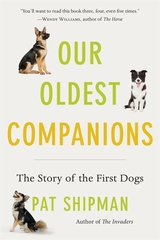 Our Oldest Companions: The Story of the First Dogs
Pat Shipman
Harvard University Press, 2021 How did the dog become man’s best friend? A celebrated anthropologist unearths the mysterious origins of the unique partnership that rewrote the history of both species.
Dogs and humans have been inseparable for more than 40,000 years. The relationship has proved to be a pivotal development in our evolutionary history. The same is also true for our canine friends; our connection with them has had much to do with their essential nature and survival. How and why did humans and dogs find their futures together, and how have these close companions (literally) shaped each other? Award-winning anthropologist Pat Shipman finds answers in prehistory and the present day.
In Our Oldest Companions, Shipman untangles the genetic and archaeological evidence of the first dogs. She follows the trail of the wolf-dog, neither prehistoric wolf nor modern dog, whose bones offer tantalizing clues about the earliest stages of domestication. She considers the enigma of the dingo, not quite domesticated yet not entirely wild, who has lived intimately with humans for thousands of years while actively resisting control or training. Shipman tells how scientists are shedding new light on the origins of the unique relationship between our two species, revealing how deep bonds formed between humans and canines as our guardians, playmates, shepherds, and hunters.
Along the journey together, dogs have changed physically, behaviorally, and emotionally, as humans too have been transformed. Dogs’ labor dramatically expanded the range of human capability, altering our diets and habitats and contributing to our very survival. Shipman proves that we cannot understand our own history as a species without recognizing the central role that dogs have played in it.
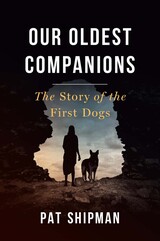 Our Oldest Companions: The Story of the First Dogs
Pat Shipman
Harvard University Press “A lively tale of dog domestication and migration.”—Nature
“When, where, and how did the partnership between dogs and humans begin? Was it an accident? Was it inevitable?…A tour de force drawing together under one proverbial roof what science can tell us to date.”—Wendy Williams, author of The Horse
“Makes a remarkable story out of the long partnership between humans and dogs.”—Foreword Reviews
How did the dog become man’s best friend? A celebrated anthropologist unearths the mysterious origins of the unique partnership that rewrote the history of both species.
Dogs and humans have been inseparable for more than 40,000 years. So what have they taught one another? Determined to untangle the genetic and archaeological evidence of the first dogs, Pat Shipman follows the trail of the wolf-dog, neither prehistoric wolf nor modern dog, whose bones offer tantalizing clues about the earliest stages of domestication. She considers the enigma of the dingo, not quite domesticated yet not entirely wild, and reveals how scientists are shedding new light on the origins of the unique relationship between man and dog, explaining how dogs became our guardians, playmates, shepherds, hunters, and providers. Along the way, dogs have changed physically, behaviorally, and emotionally—but we have been transformed, too. A brilliant work of historical reconstruction, Our Oldest Companions shows that we can’t hope to understand our own species without recognizing the central role dogs have played in making us who we are.
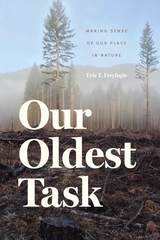 Our Oldest Task: Making Sense of Our Place in Nature
Eric T. Freyfogle
University of Chicago Press, 2017 “This is a book about nature and culture,” Eric T. Freyfogle writes, “about our place and plight on earth, and the nagging challenges we face in living on it in ways that might endure.” Challenges, he says, we are clearly failing to meet. Harking back to a key phrase from the essays of eminent American conservationist Aldo Leopold, Our Oldest Task spins together lessons from history and philosophy, the life sciences and politics, economics and cultural studies in a personal, erudite quest to understand how we might live on—and in accord with—the land.
Passionate and pragmatic, extraordinarily well read and eloquent, Freyfogle details a host of forces that have produced our self-defeating ethos of human exceptionalism. It is this outlook, he argues, not a lack of scientific knowledge or inadequate technology, that is the primary cause of our ecological predicament. Seeking to comprehend both the multifaceted complexity of contemporary environmental problems and the zeitgeist as it unfolds, Freyfogle explores such diverse topics as morality, the nature of reality (and the reality of nature), animal welfare, social justice movements, and market politics. The result is a learned and inspiring rallying cry to achieve balance, a call to use our knowledge to more accurately identify the dividing line between living in and on the world and destruction. “To use nature,” Freyfogle writes, “but not to abuse it.”
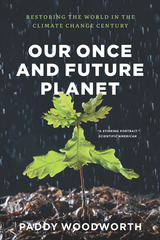 Our Once and Future Planet: Restoring the World in the Climate Change Century
Paddy Woodworth
University of Chicago Press, 2013 The environmental movement is plagued by pessimism. And that’s not unreasonable: with so many complicated, seemingly intractable problems facing the planet, coupled with a need to convince people of the dangers we face, it’s hard not to focus on the negative
But that paints an unbalanced—and overly disheartening—picture of what’s going on with environmental stewardship today. There are success stories, and Our Once and Future Planet delivers a fascinating account of one of the most impressive areas of current environmental experimentation and innovation: ecological restoration. Veteran investigative reporter Paddy Woodworth has spent years traveling the globe and talking with people—scientists, politicians, and ordinary citizens—who are working on the front lines of the battle against environmental degradation. At sites ranging from Mexico to New Zealand and Chicago to Cape Town, Woodworth shows us the striking successes (and a few humbling failures) of groups that are attempting to use cutting-edge science to restore blighted, polluted, and otherwise troubled landscapes to states of ecological health—and, in some of the most controversial cases, to particular moments in historical time, before widespread human intervention. His firsthand field reports and interviews with participants reveal the promise, power, and limitations of restoration.
Ecological restoration alone won’t solve the myriad problems facing our environment. But Our Once and Future Planet demonstrates the role it can play, and the hope, inspiration, and new knowledge that can come from saving even one small patch of earth.
 Our Ordered Lives Confess: Three Nineteenth-Century American Missionaries in East Shantung
Irwin T. Hyatt Jr.
Harvard University Press, 1976 This spirited book is a study of the adjustments of three nineteenth-century missionaries to life in northeast China. Its subject is international relations of the person-to-person kind, based on the daily experiences of living in a foreign land.
The missionaries all worked in the same place in China, but had remarkably different personalities and careers. Tarleton Perry Crawford of the Southern Baptist Convention was an unfeeling, not always trustworthy missionary, whose depressing story contrasts sharply with those of the other two subjects. The famous Lottie Moon, also of the Southern Baptist Convention, has become a culture heroine as the founder of women's work in China (in her name the SBC has collected 250 million dollars). Calvin Wilson Mateer, a Presbyterian, is well known to students of modern Chinese history as a great educator.
In this account of how three individuals responded to the same problems and opportunities, Irwin Hyatt seeks to discover why only some Americans placed among Chinese will find friends and a new appreciation of life. It is a fascinating investigation into the crucial cultural problem of understanding other people. As Andre Malraux has written, “Europeans never understand anything of China that does not resemble themselves.”
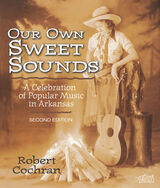 Our Own Sweet Sounds: A Celebration of Popular Music in Arkansas
Robert Cochran
University of Arkansas Press, 2005 A rich portrait of the community that is Arkansas manifested in song, Our Own Sweet Sounds celebrates the diversity of musical forms and music makers that have graced the state since territorial times. Beginning with the earliest references to Quapaw and Caddo music as first reported by seventeenth-century European explorers and continuing forward to the “bizarrely named grunge bands” who will be stars tomorrow, Robert Cochran traces the music and voices that have enriched the life of the Natural State. Arkansas, many are starting to realize, was caught in a cultural crossfire of music. There were the nearby western swing influence of Tulsa, the blues of Memphis, the Louisiana Hayride of Shreveport, and the influence of Ozark music from Missouri. All of this resulted in the Arkansas cross-culture of blues, country, folk, and rock music, creating a broad spectrum of musical styles and musicians that has left an indelible impression on the Arkansas cultural scene. This new edition includes approximately seventy new artists, some of whom became famous after 1996, when the first edition was published, such as Joe Nichols, and some of whom were left out of the original edition, such as Little Willie John. The valuable “Featured Performers” section—lengthy discussions of individual artists with their photographs—is now one-third larger. This new edition, heavily illustrated, is a loving tribute to the common music that has filled local airwaves, lifted community gatherings to the level of joyous festivities, and enlivened the spirit of music lovers everywhere.
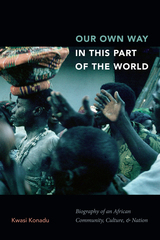 Our Own Way in This Part of the World: Biography of an African Community, Culture, and Nation
Kwasi Konadu
Duke University Press, 2019 Kofi Dᴐnkᴐ was a blacksmith and farmer, as well as an important healer, intellectual, spiritual leader, settler of disputes, and custodian of shared values for his Ghanaian community. In Our Own Way in This Part of the World Kwasi Konadu centers Dᴐnkᴐ's life story and experiences in a communography of Dᴐnkᴐ's community and nation from the late nineteenth century through the end of the twentieth, which were shaped by historical forces from colonial Ghana's cocoa boom to decolonization and political and religious parochialism. Although Dᴐnkᴐ touched the lives of thousands of citizens and patients, neither he nor they appear in national or international archives covering the region. Yet his memory persists in his intellectual and healing legacy, and the story of his community offers a non-national, decolonized example of social organization structured around spiritual forces that serves as a powerful reminder of the importance for scholars to take their cues from the lived experiences and ideas of the people they study.
 Our People Are Warlike: Civil War Pittsburgh and Home-Front Mobilization
Allen York
University of Tennessee Press, 2024 “Let our citizens organize and drill,” urged the editor of the Pittsburgh Gazette in September 1862 as rumors of a Confederate attack on the North grew louder. Bank president John Harper, chair of the city’s Committee of Home Defense, confirmed Pittsburgh was ready to repel any raid: “Our people . . . are warlike,” he averred. The Keystone State played an indispensable role in the Federal war effort, and Pittsburgh does not fit the common “brother-on-brother” historiographical theme, which emphasizes divided loyalties between Federal and Confederate supporters. This volume argues that overwhelmingly pro-Union fervor—which cut across class, ethnic, and gender lines—mobilized the city for the war effort.
From its establishment as a frontier village, Pittsburgh evolved on a cultural path divergent from that of both the Northeast and the towns developing farther west. The city entered the war with close economic ties to the East, West, and South, yet also stood apart from them—too small to assume the political positions of cities like New York or Philadelphia that represented greater ethnic and class conflict and much greater tension over secession—yet large enough to manifest the complex institutions and systems of an urban center.
This book represents a significant contribution to the scholarship of both the Civil War and the city of Pittsburgh, adding to the growing historiography of regional and community studies of the war. With abundant illustrations of local people and places, research on Pittsburgh’s geographic importance and extensive industrial output, this book also provides compelling details on Black citizens’ efforts to oppose slavery, ultimately through their service in the Union Army. Civil War Pittsburgh was unique: its distinctive geography, politics, and economy set the conditions for ordinary citizens to directly participate in the war in myriad ways that connected the experiences of the battlefield and the home front.
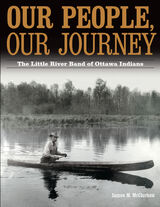 Our People, Our Journey: The Little River Band of Ottawa Indians
James M. McClurken
Michigan State University Press, 2009 Our People, Our Journey is a landmark history of the Little River Band of Ottawa Indians, a Michigan tribe that has survived to the present day despite the expansionist and assimilationist policies that nearly robbed it of an identity in the late nineteenth century.
In his thoroughly researched chronicle, McClurken documents in words and images every major lineage and family of the Little River Ottawas. He describes the Band's struggles to find land to call its own over several centuries, including the hardships that began with European exploration of what is now the upper Midwest. Although the Little River Ottawas were successful at integrating their economic and cultural practices with those of Europeans, they were forced to cede land in the face of American settlements.
McClurken explains how the Little River Band was forced, in 1858, onto a reservation on the Pere Marquette and Manistee Rivers where they settled with a number of other Ottawa bands. However, the very treaty intended to provide the Grand River Ottawas with a permanent reservation "homeland" eventually allowed non-Indians to acquire title to nearly two-thirds of the land within the reservation by 1880.
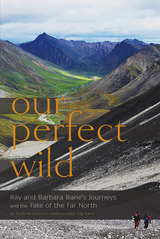 Our Perfect Wild: Ray & Barbara Bane's Journeys and the Fate of Far North
Kaylene Johnson-Sullivan with Ray Bane
University of Alaska Press, 2016 Ray and Barbara Bane worked as teachers in Barrow and Wainwright, Alaska, in the early 1960s—but they didn’t simply teach the children of their Iñupiat Eskimo and Koyukon friends and neighbors: they fully embraced their lifestyle. Doing so, they realized how closely intertwined life in the region was with the land, and, specifically, how critical wilderness was to the ancient traditions and wisdom that undergirded the Native way of life. That slow realization came to a head during a 1,200-mile dogsled trip from Hughes to Barrow in 1974—a trip that led them to give up teaching in favor of working, through the National Park Service, to preserve Alaska’s wilderness.
This book tells their story, a tale of dedication and tireless labor in the face of suspicion, resistance, and even violence. At a time when Alaska’s natural bounty remains under threat, Our Perfect Wild shows us an example of the commitment—and love—that will be required to preserve it.
Our Planet: How much more can Earth take?
Jill Jäger
Haus Publishing, 2009 For more than thirty years, scientists from various disciplines have warned that the constant increase in world population and exponential world economic growth are seriously threatening our ecosystems. The vision on which this book is based is of an ongoing, adaptable societal process which leads the world down the path towards sustainability. In this vision, the speed of global environmental changes will be drastically reduced without forgoing the good life; at the same time prosperity will be distributed more fairly.
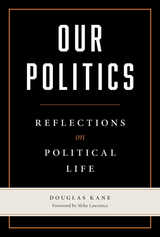 Our Politics: Reflections on Political Life
Douglas Kane, with a foreword by Mike Lawrence
Southern Illinois University Press, 2019 Douglas Kane, an American politician and economist, offers readers a straightforward, personal account of what it is like to run for and hold public office—the demands, conflicts, temptations, and rewards created by political, economic, and social forces. Throughout the book, Kane references Illinois and Wisconsin politics. The campaigns of his wife, Kathleen Vinehout, and her years in the Wisconsin senate show that the centralization of political power, the structure of campaign organizations, and the policy decisions that Kane experienced as an Illinois legislator are not unique to any one state.
In Our Politics Kane reflects on his nearly fifty years of active engagement in state and local politics. In a series of essays, he seeks to understand the forces, motivations, incentives and technologies that shape our politics and produce the consequences that we live with every day. He describes how candidates and officeholders deal with the fundamental contradictions inherent in the democratic process, and how and why the political power structure has changed. He also explores the personal experience of being a legislator, from deciding how to vote to building relationships with party leaders, fellow legislators, the governor, and the voters in the district. Kane concludes by considering the possibility of change, how it might happen, and the steps that candidates, political parties, activists and others might take to better our politics with results more to our liking.
While many journalists record politics from the outside, and numerous political memoirs focus on personalities and what happened to whom and when, this book gives an insider’s view of politics at the level of state government. This book is not about those politicians but about our politics, which together we have created and together we must deal with.
Our Portion: New and Selected Poems
Philip Terman
Autumn House Press, 2015 The new and selected collection of Philip Terman's illustrates the poet's deep understanding and compassion for our world. Spanning 20 years of poetry, this collection of poems focuses on themes of nature, literature, family, and Judaism.
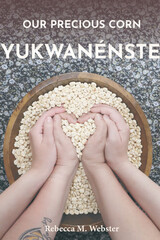 Our Precious Corn: Yukwanénste
Rebecca M. Webster
Michigan State University Press, 2023 For the Oneida people, yukwanénste has two meanings: our corn and our precious. Corn has walked alongside the Oneida and other Haudenosaunee people since creation, playing an integral role in their daily and ceremonial lives throughout their often turbulent history. The relationship between corn and the Oneida has changed over time, but the spirit of this important resource has remained by their side, helping them heal along the way. In Our Precious Corn: Yukwanénste, author Rebecca M. Webster (Kanyʌʔtake·lu), an Oneida woman and Indigenous corn grower, weaves together the words of explorers, military officers, and anthropologists, as well as historic and other contemporary Haudenosaunee people, to tell a story about their relationships with corn. Interviews with over fifty Oneida community members describe how the corn has made positive impacts on their lives, as well as hopeful visions for its future. As an added bonus, the book includes an appendix of different cooking and preparation methods for corn, including traditional and modern recipes.
 Our Primary Expertise: A Future for the Study of Religion
Russell T. McCutcheon
Rutgers University Press, 2026 Our Primary Expertise: A Future for the Study of Religion brings the author full circle—from his first book in 1997, on how claims that religion was unique were used to establish the North America field to his present argument that its future is instead based on the degree to which its findings can be applied in a wide assortment of areas, both inside and outside of academia. Its previously uncollected essays, all with new introductions that frame this timely argument, make plain that longstanding critiques of how scholars go about their work have always been about the study of religion’s odd home in the humanities—a place that’s increasingly vulnerable in today’s university. Calling on members of the field not just to revise their research methods but also the ways that they train the next generation, Our Primary Expertise is the only work in the field taking seriously that scholars of religion can help to secure the future of their own field, if only they’re prepared to see “the life of the mind” as a rhetoric that they can no longer afford.
Our Purpose in Speaking
William Orem
Michigan State University Press, 2018 In this debut poetry collection by an award-winning fiction writer, the longing for God and the poignancy of family life echo each other’s music. The traditional forms of sonnet, sestina, and villanelle punctuate more modern verse forms, this combination being only one of the strands binding past and present. Many of these poems may be read as confessions—of joy, of hurtfulness given or received, of awe at the inescapable reality of love. This volume comprises spiritual writing that remains firmly of this world, part apostasy, part song, reaching out for meaning from both the shifting landscape of Maryland’s Chesapeake Bay and the interior places of the heart.
 Our Renewable Future: Laying the Path for One Hundred Percent Clean Energy
Richard Heinberg and David Fridley
Island Press, 2016 One of GreenBiz's Six Best Sustainability Books of 2016
The next few decades will see a profound energy transformation throughout the world. By the end of the century (and perhaps sooner), we will shift from fossil fuel dependence to rely primarily on renewable sources like solar, wind, biomass, and geothermal power. Driven by the need to avert catastrophic climate change and by the depletion of easily accessible oil, coal, and natural gas, this transformation will entail a major shift in how we live. What might a 100% renewable future look like? Which technologies will play a crucial role in our energy future? What challenges will we face in this transition? And how can we make sure our new system is just and equitable?
In Our Renewable Future, energy expert Richard Heinberg and scientist David Fridley explore the challenges and opportunities presented by the shift to renewable energy. Beginning with a comprehensive overview of our current energy system, the authors survey issues of energy supply and demand in key sectors of the economy, including electricity generation, transportation, buildings, and manufacturing. In their detailed review of each sector, the authors examine the most crucial challenges we face, from intermittency in fuel sources to energy storage and grid redesign. The book concludes with a discussion of energy and equity and a summary of key lessons and steps forward at the individual, community, and national level.
The transition to clean energy will not be a simple matter of replacing coal with wind power or oil with solar; it will require us to adapt our energy usage as dramatically as we adapt our energy sources. Our Renewable Future is a clear-eyed and urgent guide to this transformation that will be a crucial resource for policymakers and energy activists.
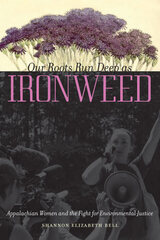 Our Roots Run Deep as Ironweed: Appalachian Women and the Fight for Environmental Justice
Shannon Elizabeth Bell
University of Illinois Press, 2013 Motivated by a deeply rooted sense of place and community, Appalachian women have long fought against the damaging effects of industrialization. In this collection of interviews, sociologist Shannon Elizabeth Bell presents the voices of twelve Central Appalachian women, environmental justice activists fighting against mountaintop removal mining and its devastating effects on public health, regional ecology, and community well-being. Each woman narrates her own personal story of injustice and tells how that experience led her to activism. The interviews--many of them illustrated by the women's "photostories"--describe obstacles, losses, and tragedies. But they also tell of new communities and personal transformations catalyzed through activism. Bell supplements each narrative with careful notes that aid the reader while amplifying the power and flow of the activists' stories. Bell's analysis outlines the relationship between Appalachian women's activism and the gendered responsibilities they feel within their families and communities. Ultimately, Bell argues that these women draw upon a broader "protector identity" that both encompasses and extends the identity of motherhood that has often been associated with grassroots women's activism. As protectors, the women challenge dominant Appalachian gender expectations and guard not only their families but also their homeplaces, their communities, their heritage, and the endangered mountains that surround them. 30% of the proceeds from the sale of this book will be donated to organizations fighting for environmental justice in Central Appalachia.
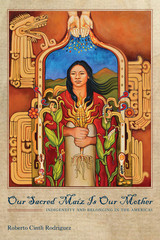 Our Sacred Maíz Is Our Mother: Indigeneity and Belonging in the Americas
Roberto Cintli Rodríguez
University of Arizona Press, 2014 “If you want to know who you are and where you come from, follow the maíz.” That was the advice given to author Roberto Cintli Rodriguez when he was investigating the origins and migrations of Mexican peoples in the Four Corners region of the United States.
Follow it he did, and his book Our Sacred Maíz Is Our Mother changes the way we look at Mexican Americans. Not so much peoples created as a result of war or invasion, they are people of the corn, connected through a seven-thousand-year old maíz culture to other Indigenous inhabitants of the continent. Using corn as the framework for discussing broader issues of knowledge production and history of belonging, the author looks at how corn was included in codices and Mayan texts, how it was discussed by elders, and how it is represented in theater and stories as a way of illustrating that Mexicans and Mexican Americans share a common culture.
Rodriguez brings together scholarly and traditional (elder) knowledge about the long history of maíz/corn cultivation and culture, its roots in Mesoamerica, and its living relationship to Indigenous peoples throughout the continent, including Mexicans and Central Americans now living in the United States. The author argues that, given the restrictive immigration policies and popular resentment toward migrants, a continued connection to maíz culture challenges the social exclusion and discrimination that frames migrants as outsiders and gives them a sense of belonging not encapsulated in the idea of citizenship. The “hidden transcripts” of corn in everyday culture—art, song, stories, dance, and cuisine (maíz-based foods like the tortilla)—have nurtured, even across centuries of colonialism, the living maíz culture of ancient knowledge.
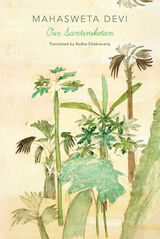 Our Santiniketan
Mahasweta Devi
Seagull Books, 2021 A brief, evocative memoir from one of India’s greatest writers.
“Like a dazzling feather that has fluttered down from some unknown place. . . . How long will the feather keep its colours, waiting? The ‘feather’ stands for memories of childhood. Memories don’t wait.”
In Our Sanitikentan, the late Mahasweta Devi, one of India’s most celebrated writers, vividly narrates her days as a schoolgirl in the 1930s. As the aging author struggles to recapture vignettes of her childhood, these reminiscences bring to the written page not only her individual sensibility but an entire ethos.
Santiniketan is home to the school and university founded by the foremost literary and cultural icon of India, Rabindranath Tagore. In these pages, a forgotten Santiniketan, seen through the innocent eyes of a young girl, comes to life—the place, its people, flora and fauna, along with its educational environment, culture of free creative expression, vision of harmonious coexistence between natural and human worlds, and the towering presence of Tagore himself. Alongside, we get a glimpse of the private Mahasweta—her inner life, family and associates, and the early experiences that shaped her personality.
A nostalgic journey to a bygone era, harking back to its simple yet profound values—so distant today and so urgent yet again—Our Santiniketan is an invaluable addition to Devi’s rich oeuvre available in English translation.
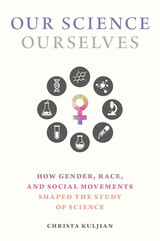 Our Science, Ourselves: How Gender, Race, and Social Movements Shaped the Study of Science
Christa Kuljian
University of Massachusetts Press, 2024 When Christa Kuljian arrived on the Harvard College campus as a first-year student in the fall of 1980 with copies of Our Bodies, Ourselves and Ms. magazine, she was concerned that the women’s movement had peaked in the previous decade. She soon learned, however, that there was a long way to go in terms of achieving equality for women and that social movements would continue to be a critical force in society. She began researching the history of science and gender biases in science, and how they intersect with race, class, and sexuality.
In Our Science, Ourselves, Kuljian tells the origin story of feminist science studies by focusing on the life histories of six key figures—Ruth Hubbard, Rita Arditti, Evelyn Fox Keller, Evelynn Hammonds, Anne Fausto-Sterling, and Banu Subramaniam. These women were part of a trailblazing network of female scientists in the 1970s, 80s, and 90s who were drawn to the Boston area—to Harvard, MIT, and other universities—to study science, to network with other scientists, or to take a job. Inspired by the social and political activism of the women’s movement and organizations such as Science for the People, the Genes and Gender Collective, and the Combahee River Collective, they began to write and teach about women in science, gender and science, and sexist and racist bias and exclusion. They would lead the critiques of E. O. Wilson’s sociobiology in 1975 and Larry Summers’ comments about women in science thirty years later. The book also explores how these contributions differed from those of Nancy Hopkins’, author of the 1999 MIT report on women in science, and a “reluctant feminist.”
Drawing on a rich array of sources that combines published journal articles and books with archival materials and interviews with major luminaries of feminist science studies, Kuljian chronicles and celebrates the contributions that these women have made to our collective scientific knowledge and view of the world.
Our Search with Socrates for Moral Truth
Gary Michael Atkinson
Catholic University of America Press, 2015 Many people believe that when it comes to moral questions, anyone's opinion is as good as anyone else's. Teachers of philosophy, by exposing students to the full panoply of moral theory, can reinforce this prejudice towards skepticism even when they intend to challenge it. Gary Michael Atkinson has taught introductory courses in philosophy for decades, and he has developed an effective approach to show that widespread skepticism based on the existence of persistent moral disagreement is mistaken. Our Search with Socrates for Moral Truth will appeal not only to students and teachers of philosophy but to any educated reader seeking to ascertain or defend the existence of moral truth.
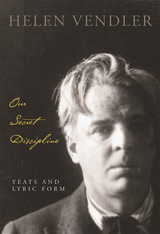 Our Secret Discipline: Yeats and Lyric Form
Helen Vendler
Harvard University Press, 2007 “An intellectual feast.”
—John Leonard, Harper’s Magazine
A monumental study reveals the patient and meticulous labor behind the Irish Nobel laureate’s immaculate poetic craft.
The fundamental difference between rhetoric and poetry, according to Yeats, is that rhetoric is the expression of one’s quarrels with others while poetry is the expression (and sometimes the resolution) of one’s quarrel with oneself. This is where Helen Vendler’s Our Secret Discipline begins. Through exquisite attention to outer and inner forms, Vendler explores the most inventive reaches of the poet’s mind. This book is a space-clearing gesture, an attempt to write about lyric forms in Yeats in unprecedented and comprehensive ways. The secret discipline of the poet is his vigilant attention to forms—whether generic, structural, or metrical. Yeats explores the potential of such forms to give shape and local habitation to volatile thoughts and feelings.
Helen Vendler remains focused on questions of singular importance: Why did Yeats cast his poems into the widely differing forms they ultimately took? Can we understand Yeats’s poetry better if we pay attention to its form, both its internal architectonic and its external organization into conventional verse structures? Chapters of the book take up many Yeatsian ventures, such as the sonnet, the lyric sequence, paired poems, blank verse, and others. With elegance and precision, Vendler offers brilliant insights into the creative process and speculates on Yeats’s aims as he writes and rewrites some of the most famous poems in modern literature.
Our Sister Who Will Not Die: Stories
Rebecca Bernard
Ohio State University Press, 2022 A man recently released from prison returns to the dating scene and struggles to find the right time to reveal his long-past murder conviction. A grieving mother considers her own role in her son’s death. A boy enables the destructive addiction of the person he’s in love with. A dog, witness to his owner’s violent acts, begins to sweat. Each story in Rebecca Bernard’s Our Sister Who Will Not Die brings the reader face to face with the frailties of human character—and demonstrates how the yearning for love and connection allows beauty and resilience to emerge from darkness. In questioning traditional formulations of good and evil, Bernard’s stories ask us to recognize our own culpabilities and acknowledge our shared humanity. None of us is the worst thing we’ve ever done, these stories compel us to believe. Hope is always worth letting in.
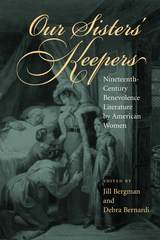 Our Sisters' Keepers: Nineteenth-Century Benevolence Literature by American Women
Edited by Jill Bergman and Debra Bernardi
University of Alabama Press, 2005 Essays on the roles played by women in forming American attitudes about benevolence and poverty relief
American culture has long had a conflicted relationship with assistance to the poor. Cotton Mather and John Winthrop were staunch proponents of Christian charity as fundamental to colonial American society, while transcendentalists harbored deep skepticism towards benevolence in favor of Emersonian self-reliance and Thoreau’s insistence on an ascetic life. Women in the 19th century, as these essays show, approached issues of benevolence far differently than their male counterparts, consistently promoting assistance to the impoverished, in both their acts and their writings. These essays address a wide range of subjects: images of the sentimental seamstress figure in women’s fiction; Rebecca Harding Davis’s rewriting of the “industrial” novel; Sarah Orne Jewett’s place in the transcendental tradition of skepticism toward charity, and her subversion of it; the genre of the poorhouse narrative; and the philanthropic work and writings of Hull House founder Jane Addams. As the editors of Our Sisters’ Keepers argue, the vulnerable and marginal positions occupied by many women in the 19th century fostered an empathetic sensitivity in them to the plight of the poor, and their ability to act and write in advocacy of the impoverished offered a form of empowerment not otherwise available to them. The result was the reformulation of the concept of the American individual.
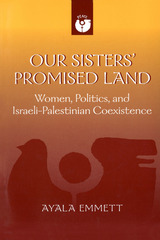 Our Sisters' Promised Land: Women, Politics, and Israeli-Palestinian Coexistence
Ayala Emmett
University of Michigan Press, 2003 In this powerful and timely book, Ayala H. Emmett examines the political roles of women in the Israeli-Palestinian peace process. Emmett's insights come from numerous trips to the region that included in-depth interviews with many of the participants. Excerpts from the interviews give voice to the women who played vitally important yet often overlooked roles in the political transformations of the contemporary Middle East. Emmett's observations on women's actions in political venues have global implications, transcending the specific political and social contexts of the region and shedding light on both the strengths of female activism and the resistances of male political institutions.
Emmett investigates the successes and failures of women in the Israeli political landscape, particularly the harassment experienced during the leadership of Right and ultra-Right groups before the ascension to office of the late Prime Minister Yitzhak Rabin. Her account of women's activism in Israel provides a rich backdrop for viewing the compelling events that have taken place in the Middle East throughout the 1990s and offer insights into the future of women's political activism, both in the ever-changing Israeli political climate and in the broader world of women in politics.
"Brilliant in conception and theory, based on superb fieldwork, and clearly written for both specialist and non-specialist reader." --Maurie Sacks, Montclair State University
"A groundbreaking study. . . .Ayala Emmett brings an unusual voice of clarity into the muddled politics of the Middle East. Where most studies ignore or marginalize women's role in the peace process, Emmett highlights women as political actors and shows their capacity to bridge the chasm between two hostile peoples." --Cynthia Saltzman, Rutgers University, Camden
Ayala Emmett is Associate Professor of Anthropology, University of Rochester.
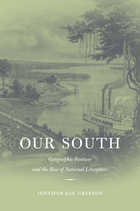 Our South: Geographic Fantasy and the Rise of National Literature
Jennifer Rae Greeson
Harvard University Press, 2010 Since the birth of the nation, we have turned to stories about the American South to narrate the rapid ascendency of the United States on the world stage. The idea of a cohesive South, different from yet integral to the United States, arose with the very formation of the nation itself. Its semitropical climate, plantation production, and heterogeneous population once defined the New World from the perspective of Europe. By founding U.S. literature through opposition to the South, writers boldly asserted their nation to stand apart from the imperial world order.
Our South tracks the nation/South juxtaposition in U.S. literature from the founding to the turn of the twentieth century, through genres including travel writing, gothic and romance novels, geography textbooks, transcendentalist prose, and abolitionist address. Even as the southern states became peripheral to U.S. politics and economy, Jennifer Rae Greeson demonstrates that in literature the South remained central to the expanding and evolving idea of the nation.
Claiming the South as our deviant and recalcitrant “other,” Americans have projected an anti-imperial imperative of domesticating and civilizing, administering and integrating underdeveloped regions both within our borders and beyond. Our South has been a primal site for thinking about geography and power in the United States.
Our Southern Highlanders: Introduction By George Ellison
Horace Kephart
University of Tennessee Press, 1976
No other book on the Southern Appalachians is more widely known or cited.
"Awonderful book. I like it especially for its color and anecdotes. It is a classic, not only for its accuracy and breadth of insights into the people of the region, but because these people themselves are so interesting and strong."
—Annie Dillard, author of Pilgrim at Tinker Creek
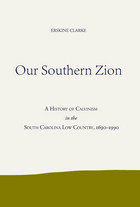 Our Southern Zion: A History of Calvinism in the South Carolina Low Country, 1690-1990
Erskine Clarke
University of Alabama Press, 1996 Three centuries of faith, intellect, and resilience—Calvinism’s quiet power in the Southern low country.
The South Carolina low country has long been regarded—not only in popular imagination and paperback novels but also by respected scholars—as a region dominated by what earlier historians called “a cavalier spirit” and by what later historians have simply described as “a wholehearted devotion to amusement and the neglect of religion and intellectual pursuits.” Such images of the low country have been powerful interpreters of the region because they have had some foundation in social and cultural realities. It is a thesis of this study, however, that there has been a strong Calvinist community in the Carolina low country since its establishment as a British colony and that this community (including in its membership both whites and after the 1740s significant numbers of African Americans) contradicts many of the images of the "received version" of the region. Rather than a devotion to amusement and a neglect of religion and intellectual interests, this community has been marked throughout most of its history by its disciplined religious life, its intellectual pursuits, and its work ethic.
 Our Story in Many Voices: The Alaska State Museum Catalog and Guide
Charles Wohlforth
University of Alaska Press, 2025 Alaska preserves and exhibits its own culture and history in the Andrew P. Kashevaroff Building in Juneau, the home of the State Library, Archives, and Museum. With this catalog and guide, the meaning of the museum exhibits gains new depth. Our Story in Many Voices orients visitors to the museum, explains the objects, and explores the changing history and interpretation of Alaska’s story in the many voices of its telling.
Charles Wohlforth provides three major text sections—an introduction to Alaska, a summary of the museum exhibits, and a history of the exhibit development process—before the catalog of art and artifacts. Richly illustrated and presenting perspectives from Native and non-Native peoples, the book enhances visits to the museum and helps visitors recall and process their experiences, as well as broaden their general understanding of the state.
There is no single history of Alaska. Understanding the place and its peoples can be achieved only by viewing the multiple, complex, and even contradictory ways different people and groups perceive Alaska. Rather than present an official view of the state, Our Story in Many Voices contains independent and critical perspectives that use the extraordinary resources of the museum to consider Alaska’s most challenging cultural issues, reaching toward understanding and reconciliation.
Our Strange Body: Philosophical Reflections on Identity and Medical Interventions
Jenny Slatman
Amsterdam University Press, 2014 The ever increasing ability of medical technology to reshape the human body in fundamental ways - from organ and tissue transplants to reconstructive surgery and prosthetics - is something now largely taken for granted. But for a philosopher, such interventions raise fundamental and fascinating questions about our sense of individual identity and its relationship to the physical body. Drawing on and engaging with philosophers from across the centuries, Jenny Slatman here develops a novel argument: that our own body always entails a strange dimension, a strangeness that enables us to incorporate radical physical changes.
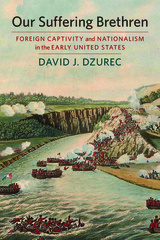 Our Suffering Brethren: Foreign Captivity and Nationalism in the Early United States
David J. Dzurec III
University of Massachusetts Press, 2019 In October 1785, American statesman John Jay acknowledged that the more his countrymen "are treated ill abroad, the more we shall unite and consolidate at home." Behind this simple statement lies a complicated history. From the British impressment of patriots during the Revolution to the capture of American sailors by Algerian corsairs and Barbary pirates at the dawn of the nineteenth century, stories of Americans imprisoned abroad helped jumpstart democratic debate as citizens acted on their newly unified identity to demand that their government strengthen efforts to free their fellow Americans. Deliberations about the country's vulnerabilities in the Atlantic world reveal America's commitment to protecting the legacy of the Revolution as well as growing political divisions.
Drawing on newspaper accounts, prisoner narratives, and government records, David J. Dzurec III explores how stories of American captivity in North America, Europe, and Africa played a critical role in the development of American political culture, adding a new layer to our understanding of foreign relations and domestic politics in the early American republic.
Our Threatened Oceans
Stefan Rahmstorf
Haus Publishing, 2009 The oceans are an important foundation of our lives - they regulate our climate and are an invaluable source of food. However, we threaten their health by heating up the planet, over-fishing and polluting these waters.
Our Town: Race, Housing, and the Soul of Suburbia
Kirp, David L
Rutgers University Press, 1997 An account of the legal battle to open up New Jersey's suburbs to the poor, looking at the views of lawyers on both sides of the controversy. It is a case study of judicial activism and its consequences and an analysis of suburban attitudes regarding race, class and property.
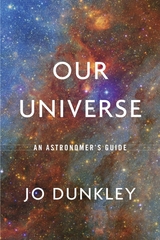 Our Universe: An Astronomer’s Guide
Jo Dunkley
Harvard University Press, 2019 A BBC Sky at Night Best Astronomy and Space Book of the Year
“[A] luminous guide to the cosmos…Jo Dunkley swoops from Earth to the observable limits, then explores stellar life cycles, dark matter, cosmic evolution and the soup-to-nuts history of the Universe.”
—Nature
“A grand tour of space and time, from our nearest planetary neighbors to the edge of the observable Universe…If you feel like refreshing your background knowledge…this little gem certainly won’t disappoint.”
—Govert Schilling, BBC Sky at Night
Most of us have heard of black holes and supernovas, galaxies and the Big Bang. But few understand more than the bare facts about the universe we call home. What is really out there? How did it all begin? Where are we going?
Jo Dunkley begins in Earth’s neighborhood, explaining the nature of the Solar System, the stars in our night sky, and the Milky Way. She traces the evolution of the universe from the Big Bang fourteen billion years ago, past the birth of the Sun and our planets, to today and beyond. She then explains cutting-edge debates about such perplexing phenomena as the accelerating expansion of the universe and the possibility that our universe is only one of many. Our Universe conveys with authority and grace the thrill of scientific discovery and a contagious enthusiasm for the endless wonders of space-time.
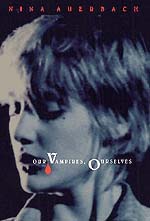 Our Vampires, Ourselves
Nina Auerbach
University of Chicago Press, 1995 Nina Auerbach shows how every age embraces the vampire it needs, and gets the vampire it deserves. Working with a wide range of texts, as well as movies and television, Auerbach locates vampires at the heart of our national experience and uses them as a lens for viewing the last two hundred years of Anglo-American cultural history.
"[Auerbach] has seen more Hammer movies than I (or the monsters) have had steaming hot diners, encountered more bloodsuckers than you could shake a stick at, even a pair of crossed sticks, such as might deter a very sophisticated ogre, a hick from the Moldavian boonies....Auerbach has dissected and deconstructed them with the tender ruthlessness of a hungry chef, with cogency and wit."—Eric Korn, Times Literary Supplement
"This seductive work offers profound insights into many of the urgent concerns of our time and forces us to confront the serious meanings that we invest, and seek, in even the shadiest manifestations of the eroticism of death."—Wendy Doniger, The Nation
"A vigorous, witty look at the undead as cultural icons."—Kirkus Review
"In case anyone should think this book is merely a boring lit-crit exposition...Auerbach sets matters straight in her very first paragraph. 'What vampires are in any given generation,' she writes, 'is a part of what I am and what my times have become. This book is a history of Anglo-American culture through its mutating vampires.'...Her book really takes off."—Maureen Duffy, New York Times Book Review
 Our Vampires, Ourselves
Nina Auerbach
University of Chicago Press, 1995 This is an auto-narrated audiobook version of this book.
Nina Auerbach shows how every age embraces the vampire it needs, and gets the vampire it deserves. Working with a wide range of texts, as well as movies and television, Auerbach locates vampires at the heart of our national experience and uses them as a lens for viewing the last two hundred years of Anglo-American cultural history.
"[Auerbach] has seen more Hammer movies than I (or the monsters) have had steaming hot diners, encountered more bloodsuckers than you could shake a stick at, even a pair of crossed sticks, such as might deter a very sophisticated ogre, a hick from the Moldavian boonies....Auerbach has dissected and deconstructed them with the tender ruthlessness of a hungry chef, with cogency and wit."—Eric Korn, Times Literary Supplement
"This seductive work offers profound insights into many of the urgent concerns of our time and forces us to confront the serious meanings that we invest, and seek, in even the shadiest manifestations of the eroticism of death."—Wendy Doniger, The Nation
"A vigorous, witty look at the undead as cultural icons."—Kirkus Review
"In case anyone should think this book is merely a boring lit-crit exposition...Auerbach sets matters straight in her very first paragraph. 'What vampires are in any given generation,' she writes, 'is a part of what I am and what my times have become. This book is a history of Anglo-American culture through its mutating vampires.'...Her book really takes off."—Maureen Duffy, New York Times Book Review
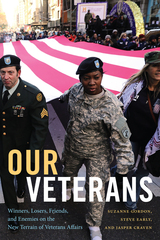 Our Veterans: Winners, Losers, Friends, and Enemies on the New Terrain of Veterans Affairs
Suzane Gordon, Steve Early, and Jasper Craven
Duke University Press, 2022 In Our Veterans, Suzanne Gordon, Steve Early, and Jasper Craven explore the physical, emotional, social, economic, and psychological impact of military service and the problems that veterans face when they return to civilian life. The authors critically examine the role of advocacy organizations, philanthropies, corporations, and politicians who purport to be “pro-veteran.” They describe the ongoing debate about the cost, quality, and effectiveness of healthcare provided or outsourced by the Department of Veterans Affairs (VA). They also examine generational divisions and political tensions among veterans, as revealed in the tumultuous events of 2020, from Black Lives Matter protests to the Trump-Biden presidential contest. Frank and revealing, Our Veterans proposes a new agenda for veterans affairs linking service provision to veterans to the quest for broader social programs benefiting all Americans.
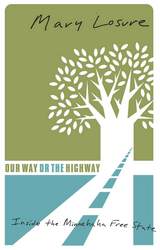 Our Way Or The Highway: Inside The Minnehaha Free State
Mary Losure
University of Minnesota Press, 2002 An eyewitness account of this controversial environmental action. Construction plans for the reroute of Highway 55 through south Minneapolis sparked an environmental movement that pitted activists against public authorities in one of the most dramatic episodes in the city’s history. Mary Losure was there; as a reporter for Minnesota Public Radio she witnessed the neighborhood’s transformation from a quiet street to the center of an emotionally charged standoff. Fueled by idealism and anger, a diverse coalition banded together to try to stop the highway expansion. Beginning in 1998, this group sustained protests for more than one year and eventually faced an unprecedented show of force by law enforcement. In Our Way or the Highway Losure offers an inside view of the activist subculture that converged into a makeshift encampment dubbed the "Minnehaha Free State." Here, a retired stenographer befriended EarthFirst! members and appeared in the organization’s national journal, fist raised in protest of the destruction of her home. A pipe fitter abandoned his old life to defend what he believed to be the sacred sites of his Dakota ancestors. A dreamy, dreadlocked seeker hitchhiked to Minneapolis and spent days perched in a doomed cottonwood tree. A police lieutenant watched the trees fall and felt surprising sympathy for the activists’ beliefs. Engagingly written, Our Way or the Highway reveals the motivations, perceptions, and dynamics of those involved in this conflict of wills and ideals.Among the issues Losure explores are the roles of ecoanarchism and grassroots activism in the age of globalization. This fascinating subculture, brought to the spotlight during protests over the World Trade Organization in Seattle and Genoa, has been largely undocumented in the mainstream press. With a practiced reporter’s eye, Mary Losure shows the activists’ world and the way the establishment views them, and ultimately she lays bare the power of the existing order and the fragility and absolute necessity of dissent.
Our Way to Fight: Peace-Work Under Siege in Israel-Palestine
Michael Riordon
Pluto Press, 2011 This book follows the dangerous lives of peace activists in Israel and Palestine. It explores the crises that stirred them to act, the risks they face, and the small victories that sustain them.
Michael Riordon takes us to thousand year-old olive groves, besieged villages, refugee camps, checkpoints and barracks. In the face of deepening conflict, Our Way to Fight offers courageous grassroots action on both sides of the wall, and points the way to a liveable future.
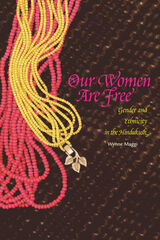 Our Women Are Free: Gender and Ethnicity in the Hindukush
Wynne Maggi
University of Michigan Press, 2001 The Kalasha are a dynamic community of about three thousand people living in three tiny finger valleys near Chitral, Pakistan. A tumultuous history has left them the only remaining practitioners of cultural and religious traditions that once extended across the Hindukush into Afghanistan. The Kalasha differ in many ways from the conservative Muslim communities now surrounding them.
Yet despite their obvious religious differences with nearby communities, when asked what makes the Kalasha unique, both men and women often reply, "Our women are free" (homa istrizia azat asan). The concept that Kalasha women are "free" (azat), that they have "choice" (chit), is a topic of spirited conversation among the Kalasha. It touches at the heart of both individual women's identities and the collective identity of the community.
Our Women are Free introduces the historical and cultural landscape of the Kalasha and describes the role that "women's freedom" plays as an ethnic marker for the entire community. Throughout the narrative, Wynne Maggi stays close to conversations and events that illustrate the daily life of the community, focusing particularly on the Kalasha people's sense of humor; on the pleasure they take in work, children, ritual, and relationships; as well as on the complexity and seriousness of their social lives.
Accessible and thought-provoking, Our Women are Free will be of interest to professional anthropologists, area scholars, and other social scientists.
Wynne Maggi teaches anthropology and women's studies at the University of Colorado.
Ourika
Madame de Duras
University of Exeter Press, 1998
Ourika is the story of an African girl growing up in France: based on a true story, it was a runaway bestseller following its first publication in Paris in 1823. It is now seen as a novel of exceptional psychological penetration and intercultural interest, anticipating Fanon in several ways. Race, class and the role of women in society are key issues it raises. Ourika is acknowledged by John Fowles to have inspired his novel The French Lieutenant’s Woman.
This is a corrected and updated reprint of the 1998 second edition of this text, first published by University of Exeter Press in 1993 in the series Exeter French Texts/Textes littéraires. It is one of the most consistently successful volumes in the series, frequently used as a teaching text on university and other courses.
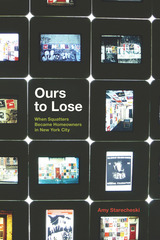 Ours to Lose: When Squatters Became Homeowners in New York City
Amy Starecheski
University of Chicago Press, 2016 Though New York’s Lower East Side today is home to high-end condos and hip restaurants, it was for decades an infamous site of blight, open-air drug dealing, and class conflict—an emblematic example of the tattered state of 1970s and ’80s Manhattan.
Those decades of strife, however, also gave the Lower East Side something unusual: a radical movement that blended urban homesteading and European-style squatting in a way never before seen in the United States. Ours to Lose tells the oral history of that movement through a close look at a diverse group of Lower East Side squatters who occupied abandoned city-owned buildings in the 1980s, fought to keep them for decades, and eventually began a long, complicated process to turn their illegal occupancy into legal cooperative ownership. Amy Starecheski here not only tells a little-known New York story, she also shows how property shapes our sense of ourselves as social beings and explores the ethics of homeownership and debt in post-recession America.
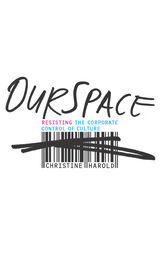 OurSpace: Resisting the Corporate Control of Culture
Christine Harold
University of Minnesota Press, 2009 Culture jamming is so twentieth century! What’s next? When reporters asked about the Bush administration’s timing in making their case for the Iraq war, then Chief of Staff Andrew Card responded that “from a marketing point of view, you don’t introduce new products in August.” While surprising only in its candor, this statement signified the extent to which consumer culture has pervaded every aspect of life. For those troubled by the long reach of the marketplace, resistance can seem futile. However, a new generation of progressive activists has begun to combat the media supremacy of multinational corporations by using the very tools and techniques employed by their adversaries. In OurSpace, Christine Harold examines the deployment and limitations of “culture jamming” by activists. These techniques defy repressive corporate culture through parodies, hoaxes, and pranks. Among the examples of sabotage she analyzes are the magazine Adbusters’s spoofs of familiar ads and the Yes Men’s impersonations of company spokespersons.While these strategies are appealing, Harold argues that they are severely limited in their ability to challenge capitalism. Indeed, many of these tactics have already been appropriated by corporate marketers to create an aura of authenticity and to sell even more products. For Harold, it is a different type of opposition that offers a genuine alternative to corporate consumerism. Exploring the revolutionary Creative Commons movement, copyleft, and open source technology, she advocates a more inclusive approach to intellectual property that invites innovation and wider participation in the creative process.From switching the digital voice boxes of Barbie dolls and G.I. Joe action figures to inserting the silhouetted image of Abu Ghraib’s iconic hooded and wired victim into Apple’s iPod ads, high-profile instances of anticorporate activism over the past decade have challenged, but not toppled, corporate media domination. OurSpace makes the case for a provocative new approach by co-opting the logic of capitalism itself.
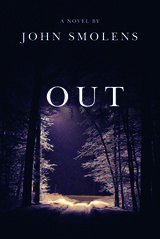 Out
John Smolens
Michigan State University Press, 2019 Out, the sequel to John Smolens’s internationally acclaimed novel Cold, finds the former constable Del Maki recovering from surgery and haunted by the recent loss of his wife. His house, set deep in the woods of Michigan’s Upper Peninsula, becomes a haven for refugees during a fierce blizzard. First his pregnant physical therapist’s car won’t start. Then her two lovers come for her—and after each other. After her current boyfriend saves an enigmatic Finnish woman from freezing to death in the storm, they are followed by her former boyfriend, a petty thief who is armed and seeks revenge. As the weather worsens, leading to a power outage, damage from a fallen tree, and a fire, tensions rise. Forced to abandon the house, their flight through the snowbound forest leads to a bad deal with a deadly result. John Smolens’s novel Cold was lauded for its “stunning brutality and uncommon tenderness.” In the sequel, Out, nature and human nature again collide, illuminating the difference between being rescued and being saved.
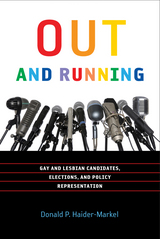 Out and Running: Gay and Lesbian Candidates, Elections, and Policy Representation
Donald P. Haider-Markel
Georgetown University Press, 2011 Out and Running is the first systematic analysis of lesbian, gay, bisexual, and transgender (LGBT) political representation that explores the dynamics of state legislative campaigns and the influence of lesbian and gay legislators in the state policymaking process. By examining state legislative elections from 1992 to 2006 and state policymaking from 1992 to 2009, Donald Haider-Markel suggests that the LGBT community can overcome hurdles and win elections; and, once in office, these officials can play a critical role in the policy representation of the community. However, he also discovers that there are limits to where and when LGBT candidates can run for office and that, while their presence in office often enhances policy representation, it can also create backlash. But even with some of these negative consequences, Out and Running provides compelling evidence that gays and lesbians are more likely to see beneficial legislation pass by increasing the number of LGBT state legislators. Indeed, grassroots politics in the states may allow the LGBT community its best opportunity for achieving its policy goals.
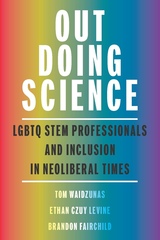 Out Doing Science: LGBTQ STEM Professionals and Inclusion in Neoliberal Times
Tom Waidzunas, Ethan Czuy Levine, and Brandon Fairchild
University of Massachusetts Press, 2025 Over the past 50 years, lesbian, gay, bisexual, transgender, and queer professionals have organized to achieve greater inclusion into the fields of science, technology, engineering, and mathematics (STEM). This inclusion, however, has come at a cost. In the 1970s, these professionals sought to radically transform STEM fields by confronting the homophobia and sexism embedded within them. Instead, these fields became more corporatized and privatized, and STEM institutions and workspaces—particularly in the spheres of government and business—became dominated by a focus on individualism, self-improvement/advancement, and meritocracy, which are hallmarks of neoliberalism. For many LGBTQ STEM professionals, inclusion now required becoming more apolitical, pro-capital, and focused on professional development.
In Out Doing Science, Tom Waidzunas, Ethan Czuy Levine, and Brandon Fairchild explore this transformation of LGBTQ STEM professionals from oppositional outsiders to assimilationist insiders. Drawing on historical archives, oral interviews, and participant observation of professional societies and workspaces, the authors interrogate the meanings of “inclusion” and why some LGBTQ STEM professionals have benefited from it more than others. They also advocate for a “queer STEM” that challenges and transforms the racism, classism, sexism, cisheterosexism, and imperialism of these fields, institutions, and workspaces. Written in an accessible and engaging style, Out Doing Science will appeal to readers interested in LGBTQ studies, and science and technology studies, as well as anyone who wants to create a more diverse and inclusive work environment.
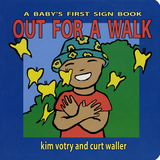 Out for a Walk
Kim Votry
Gallaudet University Press, 2003 From the team that created the Baby’s First Signs books come two new board books. A Book of Colors depicts the charming character with the favorite hat signing all of the primary and secondary colors—red, yellow, blue, orange, green, and purple—in interesting settings. The other pages display a wide variety of appealing colors, too, including pink, white, black, gray, brown, and tan, topped off with a richly rendered illustration of a rainbow.
Out for a Walk offers toddlers their first look at signs for the world around them. As they follow our distinctively hatted youngster on a stroll, they encounter familiar animals and insects, among them a dog, cat, butterfly, and squirrel, and learn which ones can be pets. They’ll enjoy imaginative images of the senses, too—sight, smell, hearing, taste, and touch. Printed on robust cardboard stock, these delightful full-color books will engage toddlers in new topics as they discover more basic signs, proven to accelerate their grasp of language.
 Out for Glamour in Africa: A History of Black Urban Femininities in Drum Magazine
Wanjiru G. Mbure
University of Michigan Press, 2026 Out for Glamour in Africa critically reflects on how Black women utilized Drum magazine, a leading publication in Africa during the era of independence, for political empowerment and constructing notions of Black femininity. Wanjirũ G. Mbure terms the concept of femme urbAfricana, a model of Black femininity depicted as urban, political, fashionable, paradoxically Afrocentric, heteronormative, and transnational. Foregrounding stories of the women who embodied these traits and the social, political, and economic forces that shaped their presence in Drum, Mbure argues that these representations of Black women from Africa, the Caribbean, Europe, and the United States produced a novel form of Black urban femininity.
Utilizing a breadth of archival materials from cover girl photographs, advertisements, and columns, to readers’ comments, Mbure reveals the complex relationship between the Black urban woman and the era’s contested ideals within a transnational matrix.
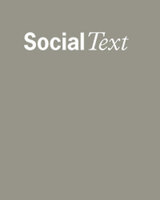 Out Front: Lesbians, Gays, and the Struggle for Workplace Rights, Volume 17
Patrick McCreery and Kitty Krupat, eds.
Duke University Press The contributors to Out Front take a hard look at the emergent relationship between sexual politics and the labor movement. With a fundamental focus on the relationship between class and social identity, they explore real and potential connections between the gay rights and labor movements. Encompassing a range of political issues concerning rights and representation, the essays have been shaped by the combined influences of trade unionism and identity politics of New Left social movements. In their examinations of worker and gay rights, the scholars, artists, and activists who speak in this volume argue that neither the labor movement nor the gay rights movement will make substantial progress without a deeper understanding of the connections between identity politics and class. Included is a major policy statement by AFL-CIO president John J. Sweeney. Four other labor leaders—Bill Fletcher Jr., Yvette Hererra, Gloria Johnson, and Van Allen Sheets—discuss homophobia as “labor’s new frontier.” Nikhil Pal Singh’s conversation with lesbian activist Amber Hollibaugh and a virtuoso piece by filmmaker Tami Gold offer incisive personal histories and commentaries, which Cathy J. Cohen takes the mainstream gay and lesbian movement to task for not adequately or consistently focusing on issues of class. Contributors. Cathy J. Cohen, Bill Fletcher Jr., Tami Gold, Yvette Herrera, Amber Hollibaugh, Gloria Johnson, Kitty Krupat, Patrick McCreery, Van Allen Sheets, Nikhal Pal Singh, John J. Sweeney
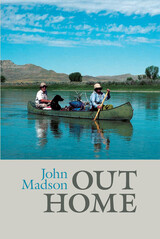 Out Home
John Madson
University of Iowa Press, 1979 Long out of print, Out Home is the first published collection of naturalist and conservationist John Madson’s essays. Written between 1961 and 1977 for such venues as Outdoor Life, Sports Afield, Audubon, and Guns and Ammo, the twenty-one essays and one poem in this classic volume focus on game and nongame animals and the people who love them and their outdoor world. Madson writes of hunting and wildlife management, the tricks of whitetail and cottontail, the bewildering interactions of pheasants with their harsh winter world, the cliff-nesting geese of the Missouri River, biscuits and gravy and stories shared around campfires with friends and family, and the great seasonal migrations of geese and cranes.
Writing always with the knowledge that he was witnessing the end of the wilderness, of the outdoor home that nourished him, Madson brings a brilliant energy to these tough, unsentimental tales. “A strong place puts a mark on all that lives there, and the mark may outlast the place itself. Prairie people are like their western meadowlarks, seeming to be the same as their eastern relatives, but with a different song.” In his song about the “play of wind on tallgrasses, with the land running beneath a towering sky,” we hear the voice that went on to give us the magic of Where the Sky Began.
Editor Michael McIntosh, one of the nation’s foremost experts on shotguns, has written a short introduction to this first paperback edition of these ageless wilderness tales.
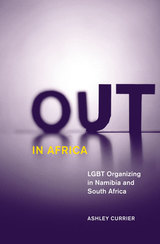 Out in Africa: LGBT Organizing in Namibia and South Africa
Ashley Currier
University of Minnesota Press, 2012 Visibility matters to activists—to their social and political relevance, their credibility, their influence. But invisibility matters, too, in times of political hostility or internal crisis. Out in Africa is the first to present an intimate look at how Namibian and South African lesbian, gay, bisexual, and transgender (LGBT) organizations have cultivated visibility and invisibility as strategies over time. As such, it reveals the complexities of the LGBT movements in both countries as these organizations make use of Western terminology and notions of identity to gain funding even as they work to counter the perception that they are “un-African.” Different sociopolitical conditions in Namibia and South Africa affected how activists in each country campaigned for LGBT rights between 1995 and 2006. Focusing on this period, Ashley Currier shows how, in Namibia, LGBT activists struggled against ruling party leaders’ homophobic rhetoric and how, at the same time, black LGBT citizens of South Africa, though enjoying constitutional protections, greater visibility, and heightened activism, nonetheless confronted homophobic violence because of their gender and sexual nonconformity. As it tells the story of the evolving political landscape in postapartheid Namibia and South Africa, Out in Africa situates these countries’ movements in relation to developments in pan-African LGBT organizing and offers broader insights into visibility as a social movement strategy rather than simply as a static accomplishment or outcome of political organizing.
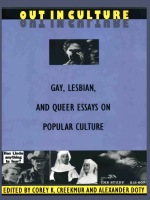 Out in Culture: Gay, Lesbian and Queer Essays on Popular Culture
Corey K. Creekmur and Alexander Doty, eds.
Duke University Press, 1995 Out in Culture charts some of the ways in which lesbians, gays, and queers have understood and negotiated the pleasures and affirmations, as well as the disappointments, of mass culture. The essays collected here, combining critical and theoretical works from a cross-section of academics, journalists, and artists, demonstrate a rich variety of gay and lesbian approaches to film, television, popular music, and fashion. This wide-ranging anthology is the first to juxtapose pioneering work in gay and lesbian media criticism with recent essays in contemporary queer cultural studies. Uniquely accessible, Out in Culture presents such popular writers as B. Ruby Rich, Essex Hemphill, and Michael Musto as well as influential critics such as Richard Dyer, Chris Straayer, and Julia Lesage, on topics ranging from the queer careers of Agnes Moorehead and Pee Wee Herman to the cultural politics of gay drag, lesbian style, the visualization of AIDS, and the black snap! queen experience. Of particular interest are two "dossiers," the first linking essays on the queer content of Alfred Hitchcock’s films, and the second on the production and reception of popular music within gay and lesbian communities. The volume concludes with an extensive bibliography—the most comprehensive currently available—of sources in gay, lesbian, and queer media criticism. Out in Culture explores the distinctive and original ways in which gays, lesbians, and queers have experienced, appropriated, and resisted the images and artifacts of popular culture. This eclectic anthology will be of interest to a broad audience of general readers and scholars interested in gay and lesbian issues; students of film, media, gender, and cultural studies; and those interested in the emerging field of queer theory. Contributors. Sabrina Barton, Edith Becker, Rhona J. Berenstein, Nayland Blake, Michelle Citron, Danae Clark, Corey K. Creekmur, Alexander Doty, Richard Dyer, Heather Findlay, Jan Zita Grover, Essex Hemphill, John Hepworth, Jeffrey Hilbert, Lucretia Knapp, Bruce La Bruce, Al LaValley, Julia Lesage, Michael Moon, Michael Musto, B. Ruby Rich, Marlon Riggs, Arlene Stein, Chris Straayer, Anthony Thomas, Mark Thompson, Valerie Traub, Thomas Waugh, Patricia White, Robin Wood
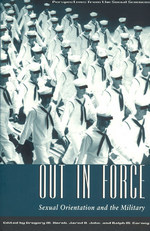 Out in Force: Sexual Orientation and the Military
Edited by Gregory M. Herek, Jared B. Jobe, and Ralph M. Carney
University of Chicago Press, 1996 Can the U.S. military integrate gay personnel into its ranks and still accomplish its mission? In 1993, this question became the center of a heated debate when President Clinton attempted to lift the long-standing ban on gays in the military. This debate persists because the compromise policy "Don't Ask, Don't Tell, Don't Pursue," faces serious legal challenges, and is likely to go to the Supreme Court before the end of the decade. Just below the surface of this debate rages a more general argument about the status of gay people in America.
Both sides base their views on assumptions about the consequences of integration. Even defenders of the ban grudgingly acknowledge that homosexuals are fully capable of serving with distinction. Few question gay service members' abilities or patriotism; justifications for the ban are now predicated on heterosexuals' negative reactions.
Out in Force refutes the notions that homosexuality is incompatible with military service and that gay personnel would undermine order and discipline. Leading social science scholars of sexual orientation and the military offer reasoned and comprehensive discussions about military organizations, human sexuality, and attitudes toward individuals and groups. They demonstrate forcefully that the debate is really about the military as an institution, and how that institution will adapt to larger social changes. The contributors show that the ban could be successfully eliminated, and set forth a program for implementation. In sorting opinion from fact, myth from reality, Out in Force stands as an invaluable guide for the military, lawmakers, and the courts as they continue to grapple with this question of institutional and societal change.
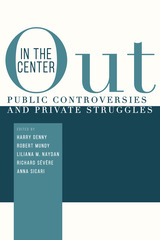 Out in the Center: Public Controversies and Private Struggles
Harry C. Denny
Utah State University Press, 2018 Out in the Center explores the personal struggles of tutors, faculty, and administrators in writing center communities as they negotiate the interplay between public controversies and features of their own intersectional identities. These essays address how race, ethnicity, gender, sexuality, class, faith, multilingualism, and learning differences, along with their intersections, challenge those who inhabit writing centers and engage in their conversations.
A diverse group of contributors interweaves personal experience with writing center theory and critical race theory, as well as theories on the politics and performance of identity. In doing so, Out in the Center extends upon the writing center corpus to disrupt and reimagine conventional approaches to writing center theory and practice. Out in the Center proposes that practitioners benefit from engaging in dialogue about identity to better navigate writing center work—work that informs the local and carries forth a social and cultural impact that stretches well beyond academic institutions.
Contributors:
Allia Abdullah-Matta, Nancy Alvarez, Hadi Banat, Tammy S. Conard-Salvo, Michele Eodice, Rochell Isaac, Sami Korgan, Ella Leviyeva, Alexandria Lockett, Talisha Haltiwanger Morrison, Anna Rita Napoleone, Beth A. Towle, Elizabeth Weaver, Tim Zmudka
 Out in the Field: Reflections of Lesbian and Gay Anthropologists
Edited by Ellen Lewin and William L. Leap
University of Illinois Press, 1996 "Definitive and well-rounded. . . . Explores how anthropologists
manage issues of identity and sexuality in field research and professional
life. In an era when the field worker's positionality is critical to research
and ethnographic writing, this insightful book has much to say to gay
and straight researchers alike." -- Louise Lamphere, University of
New Mexico
"Addresses sensitive, controversial, and tabooed subjects. . . .
Out in the Field will be read by a variety of audiences, within
and outside of anthropology." -- Jean Jackson, Massachusetts Institute
of Technology
Lesbian and gay anthropologists write candidly in Out in the Field
about their research and personal experiences in conducting fieldwork,
about the ethical and intellectual dilemmas they face in writing about
lesbian or gay populations, and about the impact on their careers of doing
lesbian/gay research.
The first volume in which lesbian and gay anthropologists discuss personal
experiences, Out in the Field offers compelling illustrations of
professional lives both closeted and out to colleagues and fieldwork informants.
It also concerns aligning career goals with personal sexual preferences
and speaks directly to issues of representation and authority currently
being explored throughout the social sciences.
CONTRIBUTORS: Geoffrey Burkhart, Liz Goodman, Delores M. Walters, Walter
L. Williams, Sabine Lang, Ellen Lewin, William L. Leap, Ralph Bolton,
Elizabeth Lapovsky Kennedy, Madeline Davis, Will Roscoe, Esther Newton,
Stephen O. Murray, James Wafer, Kath Weston, Sue-Ellen Jacobs
Out In The South
edited by Carlos L. Dews and Carolyn Leste Law
Temple University Press, 2001 In this book gays and lesbians from the Deep South to East Texas and Appalachia speak from vivid personal experience and turn an analytical eye on the South and its culture. Some contributors examine the power of traditional Southern attitudes toward race and religion, and consider the "don't ask, don't tell" attitude about homosexuality in some communities (the "public secret"). Other contributors show how gay culture is thriving in the form of women's festivals, gay bars, and unusual networks like that of Asian and Pacific Islanders in Atlanta. Out in the South is organized into sections that focus on a central metaphor of space and location. This grounds the book in the sense of the South as a special region and in the inside/outside dilemma faced by many gay and lesbian Southerners as they negotiate their place in an often-inhospitable homeland.
 Out in the Union: A Labor History of Queer America
Miriam Frank
Temple University Press, 2015 Out in the Union tells the continuous story of queer American workers from the mid-1960s through 2013. Miriam Frank shrewdly chronicles the evolution of labor politics with queer activism and identity formation, showing how unions began affirming the rights of lesbian, gay, bisexual, and transgender workers in the 1970s and 1980s. She documents coming out on the job and in the union as well as issues of discrimination and harassment, and the creation of alliances between unions and LGBT communities. Featuring in-depth interviews with LGBT and labor activists, Frank provides an inclusive history of the convergence of labor and LGBT interests. She carefully details how queer caucuses in local unions introduced domestic partner benefits and union-based AIDS education for health care workers-innovations that have been influential across the U.S. workforce. Out in the Union also examines organizing drives at queer workplaces, campaigns for marriage equality, and other gay civil rights issues to show the enduring power of LGBT workers.
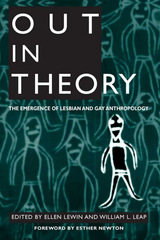 Out in Theory: The Emergence of Lesbian and Gay Anthropology
Edited by Ellen Lewin and William L. Leap
University of Illinois Press, 2002 A companion volume to Out in the Field, a benchmark examination of lesbian and gay experiences in anthropology, Out in Theory presents lesbian and gay anthropology as a distinct specialization and addresses the theoretical issues that define the emerging field.
This compelling collection of essays details the scholarly and personal factors that affected the emergence of lesbian and gay anthropology and speculates on the directions it will take as it continues to grow and diversify. Seeking to legitimize the field's scholarship and address issues in terminology, the essays also define the lesbian and gay anthropology's scope and subject matter and locate factors that separate it from the wider concerns of the profession.
Specific essays track the emergence of lesbian and gay studies in social and cultural anthropology, linguistics, archaeology, and in various areas of anthropological activism. They also consider how feminist anthropology helped define the field and how transgendered experience, queer theory, and race and class studies are promoting new directions of inquiry within lesbian and gay anthropology.
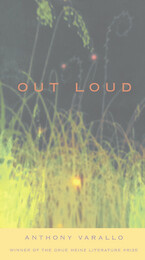 Out Loud
Anthony Varallo
University of Pittsburgh Press, 2008
WINNER OF THE 2008 DRUE HEINZ LITERATURE PRIZE
Selected by Scott Turow
Feeling distanced from her friends and family, middle-aged divorcée Caitlin Drury is encouraged by her daughter to express her feelings in a diary, but she is hesitant: “I feel lonely she wrote, then crossed it out. She didn't like the idea of someone coming along later to read her journal, finding out she felt lonely." “Like That,” and other stories from Anthony Varallo's new collection Out Loud give voice to the disconnections of family and relationships, and the silent emotions that often speak louder than words.
In “The Walkers,” we follow a couple on their daily trek through a bedroom community, where they partially glimpse their neighbors' lives, longing for inclusion. Yet their insular lifestyle ensures that they deal with people only on the surface--without learning the truth of their problems.
Out Loud tells of longings for meaningful expression and the complexities and escapism of human interactions that keep us from these truths. Varallo uses the trials of youth and remembrances of the past, the rituals and routines of the everyday, the interactions of family, friends, teachers, and neighbors to peel away the layers of language and actions we use to shield ourselves.
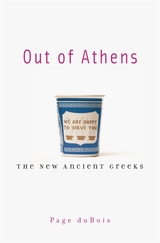 Out of Athens: The New Ancient Greeks
Page duBois
Harvard University Press, 2010 The iconoclast of Classics, Page duBois refuses to act as border patrol for a sometimes fiercely protected traditional discipline. Instead, she incorporates insights from postcolonial, psychoanalytic, and postmodern theories into her nuanced close readings of ancient Greek texts. Contemporary theory and ancient texts are mutually transformed in the process. Out of Athens sets ancient Greek culture next to the global ancient world of Vedic India, the Han dynasty in China, and the empires that survived Alexander the Great. DuBois also extends the range of classical studies through illuminating transhistorical juxtapositions—ancients brush elbows with Colette as she performs as a mummy at the Moulin Rouge, or with Kirk Douglas as he appears on the silver screen as Spartacus. She reads the poetry of Sappho, the tattooed body of the sage Epimenides, as well as Athenian tragedy, Buddhist texts set in a post-Alexandrian Bactria, alongside the work of Judith Butler and Alain Badiou. Page duBois establishes a daring agenda for the next generation of Classicists and, for both the intimate friend of Greek texts and the freshly arrived reader, makes ancient Greeks new.
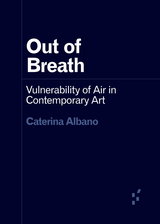 Out of Breath: Vulnerability of Air in Contemporary Art
Caterina Albano
University of Minnesota Press, 2022 Explores the intrinsic relation of life to air, and breathing, through contemporary art
In Out of Breath, Caterina Albano examines the cultural significance of breath and air to a wide array of forces in our midst, including economy, politics, infection, and ecological violence. Through a consideration of recent art practices and projects, including the dance project Breath Catalogue, which makes visible the breathing patterns of dancers, and Forensic Architecture’s Cloud Studies video, which investigates eight different kinds of clouds from airstrikes to herbicides to tear gas, Albano focuses on breath as both an intuitive process and a conveyer of meanings. Conceived in response to the Covid-19 pandemic and systemic inequalities that it has laid bare, Out of Breath shows the potential of artistic practices to mobilize affect as a form of cultural and political critique.
Forerunners is a thought-in-process series of breakthrough digital works. Written between fresh ideas and finished books, Forerunners draws on scholarly work initiated in notable blogs, social media, conference plenaries, journal articles, and the synergy of academic exchange. This is gray literature publishing: where intense thinking, change, and speculation take place in scholarship.
Out of Brownsville: Encounters with Nobel Laureates and Other Jewish Writers: A Cultural Memoir
Jules Chametzky
University of Massachusetts Press, 2012 In this collection of literary portraits, Jules Chametzky shares his recollections of more than forty notable Jewish writers, from Alfred Kazin to Isaac Bashevis Singer, Grace Paley, Saul Bellow, Irving Howe, Cynthia Ozick, Leslie Fiedler, Tillie Olsen, Adrienne Rich, Allen Ginsberg, Joseph Brodsky, and Amos Oz—to name a few. Also included are cameo appearances by non-Jewish authors, such as James Baldwin, Amiri Baraka, and Jose Yglesias. Not only do these various writers emerge as interesting and often complicated human beings, but Chametzky reveals himself to be a warm and gracious storyteller.
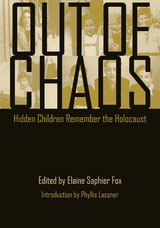 Out of Chaos: Hidden Children Remember the Holocaust
Elaine Saphier Fox
Northwestern University Press, 2013 The stories in Out of Chaos forms a profound testament to lost and found lives that are translated into compelling reading. The collection illuminates brief or elongated moments, fragments of memory and experience, what the great Holocaust writer Ida Fink called “a scrap of time.” In all, the anthology expresses survivors’ memories and reactions to a wide range of experiences as they survived in so many European settings, from Holland, Belgium, Italy, Germany, Greece, Yugoslavia, Poland, and France.
The writers recall being on the run between different countries, escaping over mountains, hiding and even sometimes forgetting their Jewish identities in convents and rescuers’ homes and hovels, basements and attics. Some were left on their own; others found themselves embroiled in rescuer family conflicts. Some writers chose to write story clusters, each one capturing a moment or incident and often disconnected by memory or temporal and spatial divides.
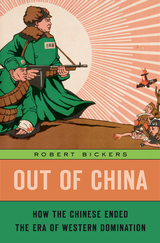 Out of China: How the Chinese Ended the Era of Western Domination
Robert Bickers
Harvard University Press, 2017 Nationalism matters in China, and what matters in China matters to everyone. China’s new nationalism, Robert Bickers shows, is rooted not in its present power but in shameful memories of its former weaknesses. Invaded, humiliated, and looted in the nineteenth and twentieth centuries by foreign powers, China looks out at the twenty-first century through the lens of the past. History matters deeply to Beijing’s current rulers, and Out of China explains why.
Bickers tracks the long, often agonizing process by which the Chinese regained control of their own country. He describes the corrupt, lurid modernity of prewar Shanghai, the often tiny patches of extraterritorial land controlled by foreign powers, the entrepôts of Hong Kong and Macao, and the myriad means—through armed threats, technology, and legal chicanery—by which China was kept subservient until, gradually, it emerged from Western control. This plural and partial subjugation of China is a story that involves not only European powers and Japan but also the United States.
This complex history must be grasped not to atone for the sins of the past but to recognize China’s internationalized landscapes with all their contradictions, violence, cosmopolitanism, and ambitions. The story of the foreign presence in China in the nineteenth and twentieth centuries is too important to be left in the hands of the Chinese party-state and its approved script. Out of China is essential reading for anyone wishing to understand what shapes China’s view of the world in the twenty-first century.
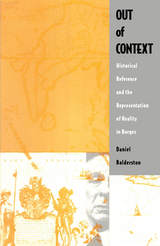 Out of Context: Historical Reference and the Representation of Reality in Borges
Daniel Balderston
Duke University Press, 1993 In Jorge Luis Borges's finely wrought, fantastic stories, so filigreed with strange allusions, critics have consistently found little to relate to the external world, to history--in short, to reality. Out of Context corrects this shortsighted view and reveals the very real basis of the Argentine master's purported "irreality." By providing the historical context for some of the writer's best-loved and least understood works, this study also gives us a new sense of Borges's place within the context of contemporary literature.
Through a detailed examination of seven stories, Daniel Balderston shows how Borges's historical and political references, so often misread as part of a literary game, actually open up a much more complex reality than the one made explicit to the reader. Working in tension with the fantastic aspects of Borges' work, these precise references to realities outside the text illuminate relations between literature and history as well as the author's particular understanding of both. In Borges's perspective as it is revealed here, history emerges as an "other" only partially recoverable in narrative form. From what can be recovered, Balderston is able to clarify Borges's position on historical episodes and trends such as colonialism, the Peronist movement, "Western culture," militarism, and the Spanish invasion of the Americas.
Informed by a wide reading of history, a sympathetic use of critical theory, and a deep understanding of Borges's work, this iconoclastic study provides a radical new approach to one of the most celebrated and—until now—hermetic authors of our time.
Out of due time: Wilfrid Ward and the Dublin review
Paschal Scotti
Catholic University of America Press, 2006 Following the tradition of the great literary quarterlies, the journal discussed every aspect of human endeavor, and Out of Due Time offers a fine opportunity to view the best of the Catholic mind in an extraordinary period.
Out of Focus Nuyoricans
Adál Maldonado
Harvard University Press Adál’s artistry is neither conventional nor pleasing for the spectator, as it is acquired through the continuous questioning of the particular condition of Puerto Ricans in the United States. The blurry portraits in this collection reflect the Nuyorican experience, but such a lesson becomes an ethical one: we are requested to learn to appreciate them in their opacity, because just as Rev. Pedro Pietri proclaims in the accompanying text, the Out of Focus Nuyoricans are proud “to not be figured out,” ever. If there is anything we should clearly get out of these out-of-focus portraits it is that to look fuzzy to some and opaque to others is not a condition to be feared or dreaded, but an achievement to be attained.
This book was published as a companion to the exhibits “Auto-Portraits/Blue Bananas on Fire” and “Blueprints for a Nation” at the David Rockefeller Center for Latin American Studies in 2004.
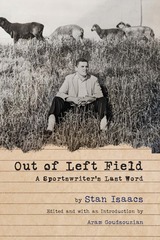 Out of Left Field: A Sportswriter’s Last Word
Stan Isaacs. Edited and with an Introduction by Aram Goudsouzian
University of Illinois Press, 2024 “My idol growing up, all I wanted to be, was Stan Isaacs.” --Tony Kornheiser “Stan Isaacs is directly responsible for my television career--and much of how I approached what I’ve said and whom I’ve said it about.” --Keith Olbermann Iconoclastic and irreverent, Stan Isaacs was part of a generation that bucked the sports establishment with a skepticism for authority, an appreciation for absurdity, and a gift for placing athletes and events within the context of their tumultuous times. Isaacs draws on his trademark wink-and-a-grin approach to tell the story of the long-ago Brooklyn that formed him and a career that placed him amidst the major sporting events of his era. Mixing reminiscences with column excerpts, Isaacs recalls antics like stealing a Brooklyn Dodgers pennant after the team moved to Los Angeles and his many writings on Paul Revere’s horse. But Isaacs also reveals the crusading and humanist instincts that gave Black athletes like Muhammad Ali a rare forum to express their views and celebrated the oddball, unsung Mets over the straitlaced Yankees. Insightful and hilarious, Out of Left Field is the long-awaited memoir of the influential sportswriter and his adventures in the era of Jim Brown, Arthur Ashe, and the Amazin’ Mets.
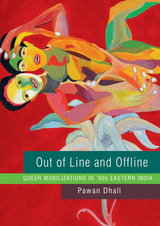 Out of Line and Offline: Queer Mobilizations in '90s Eastern India
Pawan Dhall
Seagull Books, 2020 The 1990s and early 2000s were heady days for Indian queer people and their networks as they emerged from the shadows. They grouped together to deal with covert and overt forms of stigma, discrimination, and violence in different spheres of life. Tracing the life stories of around a dozen queer individuals and their allies from eastern India, Out of Line and Offline dwells on the many ways in which queer communities were mobilized in the first decade of the movement in India, and how such mobilization affected the lives of queer people in the long run. Pawan Dhall draws on in-depth interviews, which generate compelling stories of individual lives and experiences amid a society that was slowly being pressured to change. Dhall also delves into the archives of some of the earliest queer support forums in eastern India to reveal the ways in which the movement developed and grew. A thoroughly researched and poignantly human document, this volume will find an important place in the canon of literature on queer movements across the world.
 Out of Line: Reading and Writing Protest in West Germany, 1968
Peter Schweppe
University of Michigan Press, 2026 By analyzing how protest fused the politics of reading and writing in 1968 West Germany, author Peter Schweppe uncovers the vibrant history of alternative literary form during a watershed moment of social upheaval. Out of Line interlinks the politics of reading and writing with the verve of Global Sixties’ protest, where fringe books, underground newspapers, incendiary flyers, and furtive graffiti galvanized readers and writers alike. The phrase “out of line” scrutinizes the emerging performative relationship between visual and textual media in the late 1960s as it metamorphosed modes of West German literary production, channeled the agenda of the protest movement, and, in doing so, shaped new kinds of textual meaning. Through its engagement with theories of materiality and “things,” Out of Line interrogates the dynamic ways that protest readers and writers pushed and broke conventional boundaries. Schweppe’s exploration of form discloses how reading and writing out of line implicates a textual and material history of protest and the lessons it offers protest histories to come.
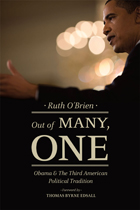 Out of Many, One: Obama and the Third American Political Tradition
Ruth O'Brien
University of Chicago Press, 2013 Feared by conservatives and embraced by liberals when he entered the White House, Barack Obama has since been battered by criticism from both sides. In Out of Many, One, Ruth O’Brien explains why. We are accustomed to seeing politicians supporting either a minimalist state characterized by unfettered capitalism and individual rights or a relatively strong welfare state and regulatory capitalism. Obama, O’Brien argues, represents the values of a lesser-known third tradition in American political thought that defies the usual left-right categorization.
Bearing traces of Baruch Spinoza, John Dewey, and Saul Alinsky, Obama’s progressivism embraces the ideas of mutual reliance and collective responsibility, and adopts an interconnected view of the individual and the state. So, while Obama might emphasize difference, he rejects identity politics, which can create permanent minorities and diminish individual agency. Analyzing Obama’s major legislative victories—financial regulation, health care, and the stimulus package—O’Brien shows how they reflect a stakeholder society that neither regulates in the manner of the New Deal nor deregulates. Instead, Obama focuses on negotiated rule making and allows executive branch agencies to fill in the details when dealing with a deadlocked Congress. Similarly, his commitment to difference and his resistance to universal mandates underlies his reluctance to advocate for human rights as much as many on the Democratic left had hoped.
By establishing Obama within the context of a much longer and broader political tradition, this book sheds critical light on both the political and philosophical underpinnings of his presidency and a fundamental shift in American political thought.
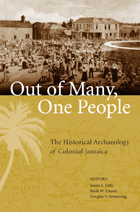 Out of Many, One People: The Historical Archaeology of Colonial Jamaica
Edited by James A. Delle, Mark W. Hauser, and Douglas W. Armstrong
University of Alabama Press, 2011 Normal0falsefalsefalseEN-USX-NONEX-NONEMicrosoftInternetExplorer4 As a source of colonial wealth and a crucible for global culture, Jamaica has had a profound impact on the formation of the modern world system. From the island's economic and military importance to the colonial empires it has hosted and the multitude of ways in which diverse people from varied parts of the world have coexisted in and reacted against systems of inequality, Jamaica has long been a major focus of archaeological studies of the colonial period. This volume assembles for the first time the results of nearly three decades of historical archaeology in Jamaica. Scholars present research on maritime and terrestrial archaeological sites, addressing issues such as: the early Spanish period at Seville la Nueva; the development of the first major British settlement at Port Royal; the complexities of the sugar and coffee plantation system, and the conditions prior to, and following, the abolition of slavery in Jamaica. The everyday life of African Jamaican people is examined by focusing on the development of Jamaica's internal marketing system, consumer behavior among enslaved people, iron-working and ceramic-making traditions, and the development of a sovereign Maroon society at Nanny Town. Out of Many, One People paints a complex and fascinating picture of life in colonial Jamaica, and demonstrates how archaeology has contributed to heritage preservation on the island.
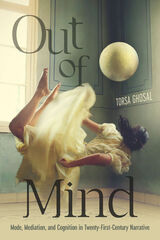 Out of Mind: Mode, Mediation, and Cognition in Twenty-First-Century Narrative
Torsa Ghosal
Ohio State University Press, 2021 What is the relationship between aesthetic presentation of thought and scientific conceptions of cognition? Torsa Ghosal’s Out of Mind: Mode, Mediation, and Cognition in Twenty-First-Century Narrative answers this question by offering incisive commentary on a range of contemporary fictions that combine language, maps, photographs, and other images to portray thought. Situating literature within groundbreaking debates on memory, perception, abstraction, and computation, Ghosal shows how stories not only reflect historical beliefs about how minds work but also participate in their reappraisal. Out of Mind makes a compelling case for understanding narrative forms and cognitive-scientific frameworks as co-emergent and cross-pollinating. To this end, Ghosal harnesses narrative theory, multimodality studies, cognitive sciences, and disability studies to track competing perspectives on remembering, reading, and sense of place and self. Through new readings of the works of Kamila Shamsie, Aleksandar Hemon, Mark Haddon, Lance Olsen, Steve Tomasula, Jonathan Safran Foer, and others, Out of Mind generates unique insights into literary imagination’s influence on how we think and perceive amid twenty-first-century social, technological, and environmental changes.
 Out of My Skull: The Psychology of Boredom
James Danckert and John D. Eastwood
Harvard University Press, 2020 A Behavioral Scientist Notable Book of the Year
A Guardian “Best Book about Ideas” of the Year
No one likes to be bored. Two leading psychologists explain what causes boredom and how to listen to what it is telling you, so you can live a more engaged life.
We avoid boredom at all costs. It makes us feel restless and agitated. Desperate for something to do, we play games on our phones, retie our shoes, or even count ceiling tiles. And if we escape it this time, eventually it will strike again. But what if we listened to boredom instead of banishing it?
Psychologists James Danckert and John Eastwood contend that boredom isn’t bad for us. It’s just that we do a bad job of heeding its guidance. When we’re bored, our minds are telling us that whatever we are doing isn’t working—we’re failing to satisfy our basic psychological need to be engaged and effective. Too many of us respond poorly. We become prone to accidents, risky activities, loneliness, and ennui, and we waste ever more time on technological distractions. But, Danckert and Eastwood argue, we can let boredom have the opposite effect, motivating the change we need. The latest research suggests that an adaptive approach to boredom will help us avoid its troubling effects and, through its reminder to become aware and involved, might lead us to live fuller lives.
Out of My Skull combines scientific findings with everyday observations to explain an experience we’d like to ignore, but from which we have a lot to learn. Boredom evolved to help us. It’s time we gave it a chance.
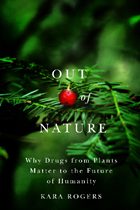 Out of Nature: Why Drugs from Plants Matter to the Future of Humanity
Kara Rogers
University of Arizona Press, 2012 About half of all species under threat of extinction in the world today are plants. The loss of plant biodiversity is disturbing for many reasons, but especially because it is a reflection of the growing disconnect between humans and nature. Plants have been used for millennia in traditional systems of healing and have held a significant place in drug development for Western medicine as well. Despite the recent dominance of synthetic drug production, natural product discovery remains the backbone of drug development. As the diversity of life on Earth is depleted and increasing numbers of species become lost to extinction, we continue to lose opportunities to achieve advances in medicine.
Through stories of drug revelation in nature and forays into botany, human behavior, and conservation, Kara Rogers sheds light on the multiple ways in which humans, medicine, and plants are interconnected. With accessible and engaging writing, she explores the relationships between humans and plants, relating the stories of plant hunters of centuries past and examining the impact of human activities on the environment and the world's biodiversity. Rogers also highlights the role that plant-based products can play in encouraging conservation and protecting the heritage and knowledge of indigenous peoples.
Out of Nature provides a fresh perspective on modern drug innovation and its relationship with nature. The book delves into the complexity of biophilia—the innate human attraction to life in the natural world—and suggests that the reawakening of this drive is fundamental to expanding conservation efforts and improving medicine. Rogers's examination of plants, humans, and drug discovery also conveys a passionate optimism for the future of biodiversity and medicine. Including a collection of hand-drawn maps and plant illustrations created by the author, this well-researched narrative will inspire as well as inform.
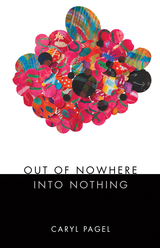 Out of Nowhere Into Nothing
Caryl Pagel
University of Alabama Press, 2020 Where ghosts speak and memory listens, nothing becomes everything. The ghosts—literal and figurative—that drive our deepest impulses, disturb our most precious memories, and haunt the passages of our daily lives are present in this collection of sublime meditations on the unbelievable, the coincidental, and the apparitional. Often containing reflections on the art of storytelling, Caryl Pagel’s essays blend memoir, research, and reflection, and are driven by a desire to observe connections between the visual and the invisible. The narrator of Pagel’s essays explores each enigma or encounter (a football coach’s faked death, the faces of women walking, historical accounts of hallucinations, a city’s public celebration gone wrong) as an intellectual detective ascending a labyrinthine tower of clues in pursuit of a solution to an unreachable problem: always curious, and with a sense of profound wonder. Out of Nowhere Into Nothing is a sprawling, highly associative consideration of the ways in which the observed material world recalls us to larger narrative and aesthetic truths. Interspersed with documentary-style photographs, Pagel’s first collection of prose is a radiant, obsessive investigation into the mysteries at the center of our seemingly mundane lives.
Out of Nowhere: New and Selected Poems
Mary Ann Taylor-Hall
Ohio University Press, 2017 The first comprehensive poetry collection by award-winning Kentucky writer and poet Mary Ann Taylor-Hall Selected and arranged by the author, the poems in Out of Nowhere unfold as a luminous narrative of the poet’s life, moving through seasons of experience—from the first stirrings of childhood consciousness to present-day meditations on loss and grief—with candor, clarity, and startling tenderness. She opens to the reader the intimate landscape of her life in rural Kentucky, which she connects directly to the immensities and astonishing mysteries of the universe that come smashing through even our most ordinary days. Published in 2017 by Old Cove Press
 Out of One, Many Africas: Reconstructing the Study and Meaning of Africa
Edited by William G. Martin and Michael O. West
University of Illinois Press, 1999 Even as symbols of Africa permeate Western culture in the 1990s, centers for the academic study of Africa suffer from a steady erosion of institutional support and intellectual legitimacy. Out of One, Many Africas assesses the rising tide of discontent that has destabilized the conceptions, institutions, and communities dedicated to African studies. In vibrant detail, contributors from Africa, Europe, and North America lay out the multiple, contending histories and perspectives that inform African studies. They assess the reaction against the white-dominated consensus that has marked African studies since its inception in the 1950s and note the emergence of alternative approaches, energized in part by feminist and cultural studies. They examine African scholars' struggle against paradigms that have justified and covered up colonialism, militarism, and underdevelopment. They also consider such issues as how to bring black scholars on the continent and in the diaspora closer together on questions of intellectual freedom, accountability, and the democratization of information and knowledge production.
By surveying the present predicament and the current grassroots impulse toward reconsidering the meaning of the continent, Out of One, Many Africas gives shape and momentum to a crucial dialogue aimed at transforming the study of Africa
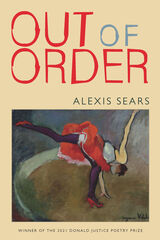 Out of Order
Alexis Sears
Autumn House Press, 2022 A debut collection featuring formally diverse poems that address topics from misogyny and mental health to race and identity.
Alexis Sears’s debut collection, Out of Order, is a collage of unapologetic intimacy, risk-taking vulnerability, and unwavering candor. A biracial millennial woman, Sears navigates the challenges of growing out of girlhood and into womanhood with its potential dangers, interrogating the male gaze, beauty standards, and confidence and identity. Pop culture references run through the collection, with rock icons David Bowie and Prince and poets like Kenneth Koch offering windows into desire and adaptation. In these poems, Sears works through heavy topics, such as loneliness, mental illness, chronic pain, the legacies of race and racism, and the aftermath of a father’s suicide. As she writes, “I’m learning something every ravishing day / and none of it is easy.”
This young poet demonstrates an uncommon mastery of craft, writing in forms including the sonnet redoublé, sestina, canzone, and villanelle. With all her linguistic skills, Sears’s work remains approachable, offering readers a striking blend of honesty, humor, anguish, joy, and surprise. Drawing influence from contemporary poets like Mark Jarman, Erica Dawson, and Tiana Clark, Sears cuts a path of her own.
Out of Order was the 2021 winner of the Donald Justice Poetry Prize.
 Out of Order
Alexis Sears
Autumn House Press, 2022 A debut collection featuring formally diverse poems that address topics from misogyny and mental health to race and identity.
Alexis Sears’s debut collection, Out of Order, is a collage of unapologetic intimacy, risk-taking vulnerability, and unwavering candor. A biracial millennial woman, Sears navigates the challenges of growing out of girlhood and into womanhood with its potential dangers, interrogating the male gaze, beauty standards, and confidence and identity. Pop culture references run through the collection, with rock icons David Bowie and Prince and poets like Kenneth Koch offering windows into desire and adaptation. In these poems, Sears works through heavy topics, such as loneliness, mental illness, chronic pain, the legacies of race and racism, and the aftermath of a father’s suicide. As she writes, “I’m learning something every ravishing day / and none of it is easy.”
This young poet demonstrates an uncommon mastery of craft, writing in forms including the sonnet redoublé, sestina, canzone, and villanelle. With all her linguistic skills, Sears’s work remains approachable, offering readers a striking blend of honesty, humor, anguish, joy, and surprise. Drawing influence from contemporary poets like Mark Jarman, Erica Dawson, and Tiana Clark, Sears cuts a path of her own.
Out of Order was the 2021 winner of the Donald Justice Poetry Prize.
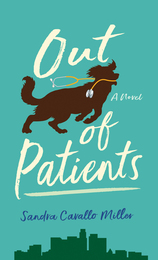 Out of Patients: A Novel
Sandra Cavallo Miller
University of Nevada Press, 2022 After practicing medicine for more than thirty years in the sweltering suburbs of Phoenix, Dr. Norah Waters is weighing her options, and early retirement is looking better and better. At age fifty-eight, she questions whether she still needs to deal with midnight calls, cranky patients, and the financial headaches that come with running a small clinic. Fighting burnout and workplace melodrama, Norah gives herself one final year to find the fulfillment and satisfaction she remembers from the early years of her once-cherished career.
As she embarks on her year’s journey, Norah grapples with a medical practice that is experiencing a concerning loss of income. She is supervising two medical students, one whose shyness hampers his development and another whose arrogance and contempt for family medicine creates major friction at the clinic. Norah’s life is further complicated by her elderly mother, a feisty 86-year-old living in Sun City, who once rejoiced at Woodstock and recently partied at Burning Man. Troubled by a shadow in their past, both women find themselves on a quest for self-worth in their shifting worlds. Norah also must cope with the end of an unhappy, long-term relationship with an aspiring, but deadbeat, novelist.
Supported by her steadfast dog, a misfit veterinarian, and a thoughtful radiologist, Norah wrestles through a surprising assortment of obstacles, sometimes amusing and sometimes dreadful, on her way to making a decision about her future.
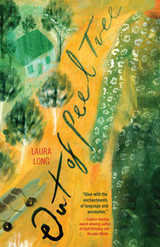 Out of Peel Tree
Laura Long
West Virginia University Press, 2014 Moving through time and space, Out of Peel Tree unfolds the patterns of an Appalachian sensibility that reverberate everywhere: a fatalism balanced by humor and flinty, hard-won hope, an appreciation for the surprises of the everyday, and a search for love and home amid strange and familiar places and people. This innovative debut novel reveals the lives of a far-flung contemporary Appalachian family through a web of delicate turning points. A child discovers a grandmother she never knew has died. A runaway teen schemes to start a new life in Texas. A man on parole falls hopelessly in love with a shoplifter. A woman receives a letter about her husband’s other wife. An old woman confronts a burglar with the help of her ghost-husband. United by a connection to their matriarch, these characters search at home and beyond to make a fresh sense of their changing lives. As a novel in stories, Out of Peel Tree brings a new lyricism to the page and a new voice to American and Appalachian literature—a voice deeply inflected by the beauty of the natural world and by working-class grit.
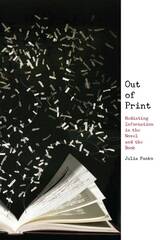 Out of Print: Mediating Information in the Novel and the Book
Julia Panko
University of Massachusetts Press, 2020 Through technological experiments, readers have seen the concept of the book change over the years, and the novel reflects these experiments, acting as a kind of archive for information. Out of Print reveals that the novel continues to shape popular understandings of information culture, even as it adapts to engage with new media and new practices of mediating information in the digital age.
This innovative study chronicles how the print book has fared as both novelists and the burgeoning profession of information science have grappled with unprecedented quantities of data across the twentieth and twenty-first centuries. As the novel's archival project took a critical turn from realism to an investigation of the structures, possibilities, and ideologies of information media, novelists have considered ideas about how data can best be collected and stored. Julia Panko pairs case studies from information history with close readings of modernist works such as James Joyce's Ulysses and Virginia Woolf's Orlando and contemporary novels from Jonathan Safran Foer, Stephen King, and Mark Z. Danielewski that emphasize their own informational qualities and experiment with the aesthetic potential of the print book.
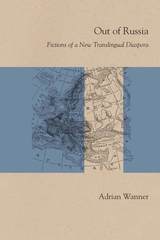 Out of Russia: Fictions of a New Translingual Diaspora
Adrian Wanner
Northwestern University Press, 2011 Out of Russia is the first scholarly work to focus on a group of writers who, over the past decade, have formed a distinct phenomenon: immigrants with cultural and linguistic roots in Russia who have chosen to write in the language of their adopted countries. The best known among these are Andreï Makine, who writes in French, Wladimir Kaminer, who writes in German, and Gary Shteyngart, who writes in English. Wanner also addresses the work of emerging immigrant writers active in North America, Germany, and Israel. He argues that it is in part by writing in a language other than their native Russian that these writers have made something of a commodity of their “Russianness.” That many of them also happen to be Jewish adds still another layer to the questions of identity raised by their work. In situating these writers within broader contexts, Wanner explores such topics as migration, cultural hybrids, and the construction and perception of ethnicity.
Out of Silence: Selected Poems
Muriel Rukeyser
Northwestern University Press, 1992 Out of Silence is a poetry book encompassing the contradictions of twentieth-century America.
 “Out of Smalle Beginnings…”: An Economic History of Harvard College in the Puritan Period (1636–1712)
Margery Somers Foster
Harvard University Press With its pleasant perspective on the American past, this book is a relevant document for higher education today. Government aid to universities, for example, has an early precedent in the grant of "£4OO towards a schoale or colledge" by the Massachusetts Bay Colony in 1636. This is the first recorded notice of the institution which was to become Harvard University, and significantly, Margery Somers Foster comments, "it is a notice concerned with finance."
Harvard College in the seventeenth century was one of America's largest and most continuous economic enterprises. Its financing is a record of resourceful extemporization. Harvest time was a period for paying bills with corn or wheat made legal tender at varying rates. How the College looked upon "country pay" or "commodity money" may be understood in the phrase, "Cash received...Should be £5 per annum, but, being paid in money, £4 accepted." And "bookkeeping barter," in which one commodity was traded for another rather than used directly as money, might involve the College in accepting a cow for tuition: Harvard does not want the animal, but the College is in debt to someone who can use the cow.
Obtaining funds from what was at first hardly more than a subsistence economy, the College attempted to derive from them some reliable income. The instability, as well as the inadequacy, of investments necessitated repeated community support. One of the most important gifts was the "College corn"--the "fourth part of a bushell of Corne, or somethinge equivalent thereunto," given yearly by every family in New England, "which is able and willing," for scholarship assistance to "poor, pious, and learned" students. Another source of income came from the receipts of the ferry running between Charlestown and Boston; between 1640 and 1712 this operation contributed over three thousand pounds to the College, although some of the money received was "bad" or counterfeit wampum. By 1712 the growing endowment income had significantly stabilized and improved the running of the College.
Though seventeenth-century Harvard was tiny compared with modern colleges or universities, it was proportional in its size to the population of its time, and its economic influence in the community was at least as important as that of present-day educational institutions. Foster's study is a significant contribution to economic and business history. Using the long and detailed financial reports she has made for the College she is able to illustrate the behavior of money (or lack of money) and prices when America was at the beginning of its economic development. Her "historic multiplier" allows real values--such as the faculty salaries of Colonial Harvard--to be compared with those of today.
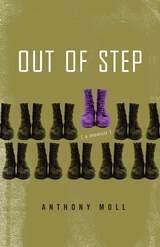 Out of Step: A Memoir
Anthony Moll
Ohio State University Press, 2018 Winner of 2018 Lambda Book Award (Bisexual Nonfiction)
What makes a pink-haired queer raise his hand to enlist in the military just as the nation is charging into war? In his memoir, Out of Step, Anthony Moll tells the story of a working-class bisexual boy running off to join the army in the midst of two wars and the “Don’t Ask, Don’t Tell” era. Set against the backdrop of hypermasculinity and sexual secrecy, Moll weaves a queer coming-of-age story.
Out of Step traces Moll’s development through his military service, recounting how the army both breaks and builds relationships, and what it was like to explore his queer identity while also coming to terms with his role in the nation’s ugly foreign policy. From a punk, nerdy, left-leaning, poor boy in Nevada leaving home for the first time to an adult returning to civilian life and forced to address a world more complicated than he was raised to believe, Moll’s journey isn’t a classic flag-waving memoir or war story—it’s a tale of finding one’s identity in the face of war and changing ideals.
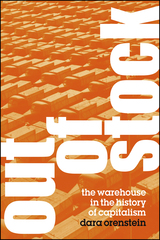 Out of Stock: The Warehouse in the History of Capitalism
Dara Orenstein
University of Chicago Press, 2019 In Out of Stock, Dara Orenstein delivers an ambitious and engrossing account of that most generic and underappreciated site in American commerce and industry: the warehouse. She traces the progression from the nineteenth century’s bonded warehouses to today’s foreign-trade zones, enclaves where goods can be simultaneously on US soil and off US customs territory. Orenstein contends that these zones—nearly 800 of which are scattered across the country—are emblematic of why warehouses have begun to supplant factories in the age of Amazon and Walmart. Circulation is so crucial to the logistics of how and where goods are made that it is increasingly inseparable from production, to the point that warehouses are now some of the most pivotal spaces of global capitalism. Drawing from cultural geography, cultural history, and political economy, Out of Stock nimbly demonstrates the centrality of warehouses for corporations, workers, cities, and empires.
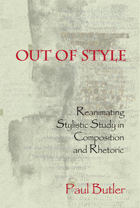 Out of Style: Reanimating Stylistic Study in Composition and Rhetoric
Paul G. Butler
Utah State University Press, 2008 Paul Butler applauds the emerging interest in the study of style among scholars of rhetoric and composition, arguing that the loss of stylistics from composition in recent decades left it alive only in the popular imagination as a set of grammar conventions. Butler’s goal in Out of Style is to articulate style as a vital and productive source of invention, and to redefine its importance for current research, theory, and pedagogy.
Scholars in composition know that the ideas about writing most common in the discourse of public intellectuals are egregiously backward. Without a vital approach to stylistics, Butler argues, writing studies will never dislodge the controlling fantasies of self-authorized pundits in the nation’s intellectual press. Rhetoric and composition must answer with a public discourse that is responsive to readers’ ongoing interest in style but is also grounded in composition theory.
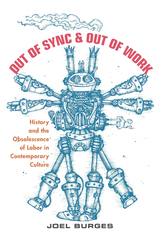 Out of Sync & Out of Work: History and the Obsolescence of Labor in Contemporary Culture
Burges, Joel
Rutgers University Press, 2018 Out of Sync & Out of Work explores the representation of obsolescence, particularly of labor, in film and literature during a historical moment in which automation has intensified in capitalist economies. Joel Burges analyzes texts such as The Invention of Hugo Cabret, Wreck-It Ralph, Fantastic Mr. Fox, and Iron Council, and examines their “means” of production. Those means include a range of subjects and narrative techniques, including the “residual means” of including classic film stills in a text, the “obstinate means” of depicting machine breaking, the “dated means” of employing the largely defunct technique of stop-motion animation, and the “obsolete” means of celebrating a labor strike. In every case, the novels and films that Burges scrutinizes call on these means to activate the reader’s/viewer’s awareness of historical time. Out of Sync & Out of Work advances its readers’ grasp of the complexities of historical time in contemporary culture, moving the study of temporality forward in film and media studies, literary studies, critical theory, and cultural critique.
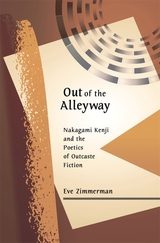 Out of the Alleyway: Nakagami Kenji and the Poetics of Outcaste Fiction
Eve Zimmerman
Harvard University Press, 2007 The writer Nakagami Kenji (1946-1992) rose to fame in the mid-1970s for his vivid stories about a clan scarred by violence and poverty on the underside of the Japanese economic miracle. Drawing upon the lives, experiences, and languages of the burakumin, the outcaste communities long discriminated against in Japanese society as a defiled underclass, Nakagami's works of fiction and nonfiction record with vitality and violence the realities—actual and imagined—of buraku culture.
In this critical study of Nakagami's life and oeuvre, Eve Zimmerman delves into the writer's literary world, exploring the genres, forms, and themes with which Nakagami worked and experimented. These chapters trace the biographical thread running through his works while foregrounding such diverse facets of his writing as his interest in the modern possibilities of traditional myths and forms of storytelling, his deployment of shocking tropes and images, and his crafting of a unique poetic language.
By bringing to the fore the literary urgency and social engagement that informed all aspects of Nakagami's creative and intellectual production, from his works of prose and poetry to his criticism, this book argues eloquently and effectively for us to appreciate Nakagami as a distinctive and relevant voice in modern Japanese literature.
 Out of the Attic: Inventing Antiques in Twentieth-Century New England
Briann G. Greenfield
University of Massachusetts Press, 2009 In this era of Antiques Roadshow and eBay, it is hard to imagine a time when Americans did not treasure the home furnishings of elite early American families. But as this book demonstrates, antiquing—particularly the practice of valuing old things for their aesthetic qualities—is a relatively recent invention whose origins can be found in the early years of the twentieth century. Although nineteenth-century Americans did appreciate heirlooms, they saw them as memory markers, tangible representations of honored ancestors or local history.
In Out of the Attic, Briann G. Greenfield traces the transformation of antiques from family keepsakes to valuable artistic objects, examining the role of collectors, dealers, and museum makers in the construction of a new tradition based on the aesthetic qualities of early American furnishings. While recognizing the significance of antiques as symbols of an enduring American culture, Greenfield also delves behind popular rhetoric to examine the development of a retail structure specifically designed to facilitate the buying and selling of old wares. With antique shops proliferating all over New England, pickers going door-to-door in search of "finds," and forgers taking illicit advantage of growing demand, antique owners and collectors found themselves trying to navigate a retail market characterized by escalating prices and high stakes purchases. In this sense, antiques functioned as more than remnants of a treasured past; they became modern consumer goods.
The book is divided into a series of case studies, each intended to illuminate some aspect of "the dynamic of consumer history." One chapter examines the role of Jewish dealers in promoting American antiques; another profiles Jessie Baker Gardner, a small-time collector and would-be museum maker from Providence, Rhode Island. Greenfield also looks at the institutionalization of antiques, with chapters focusing on Henry Flynt of Deerfield, Massachusetts, who embraced the "aestheticization of antiques" in the 1940s and 1950s, and on Smithsonian curator C. Malcolm Watkins, who challenged the decorative art market during the 1950s and 1960s by purchasing old tools and crude furniture for the nation's museum.
Out Of The Black Patch
Noel Carmack
Utah State University Press, 1999 Effie Marquess Carmack (1885-1974) grew up in the tobacco-growing region of southern Kentucky known as the Black Patch. As an adult she moved to Utah, back to Kentucky, to Arizona, and finally to California. Economic necessity primarily motivated Effie and her husband's moves, but her conversion to the Mormon Church in youth also was a factor. Throughout her life, she was committed to preserving the rural, southern folkways she had experienced as a child. She and other members of her family were folk musicians, at times professionally, and she also became a folk poet and artist, teaching herself to paint. In the 1940s she began writing her autobiography and eventually also completed a verse adaptation of it and an unpublished novel about life in the Black Patch.
 Out of the Cave: A Philosophical Inquiry into the Dead Sea Scrolls Research
Edna Ullmann-Margalit
Harvard University Press More than fifty years ago the discovery of scrolls in eleven caves beside the Dead Sea ignited the imagination of the world--and launched a vast academic field. Expectations abounded that the scrolls would reveal actual contemporaneous accounts of the birth of Christianity, perhaps even of the life of Jesus. The research that followed--its inner logic, and what its impassioned and often highly controversial theories reveal about the framing of facts and the interpreting of texts--is what interests philosopher Edna Ullmann-Margalit in this thoroughly absorbing book.
Since the inception of Dead Sea Scrolls research, a central theory has emerged. Known as the Qumran-Essene Hypothesis, it asserts that the scrolls belonged to the Essenes, a sect whose center was at the nearby site of Qumran. In Out of the Cave, Ullmann-Margalit focuses on this theory and the vicissitudes of its career. Looking at the Essene connection, the archaeology of Qumran, and the sectarian nature of the scrolls community, she explores the different arenas, and ways, in which contesting theories of the scrolls do battle. In this context she finds fascinating examples of issues that exercise philosophers of science as well as the general public--issues that only amplify the already intrinsic interest of the Dead Sea scrolls.
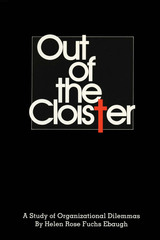 Out of the Cloister: A Study of Organizational Dilemmas
By Helen Rose Fuchs Ebaugh
University of Texas Press, 1977 Since Vatican Council II, convent walls have crumbled. and the structures that once separated nuns from the world are gone. Out of the Cloister is an organizational analysis of the structural and ideological changes that took place in Catholic religious orders of women in the United States. Many nuns today dress in street clothes, choose their own jobs, have a degree of financial independence from the larger order, and may not be recognized by their coworkers as nuns. What might once have been defined as a "total institution" has become, within the span of a few years, a type of voluntary organization where members join together loosely to achieve a common purpose. Helen Rose Fuchs Ebaugh approaches religious orders as utopian communities and examines how contact with the larger society has affected the distinctiveness and solidarity that hold such groups together. She analyzes the patterns occurring within orders with particular focus on the relationship between organizational change and membership loss. Since changes have been introduced into religious orders at different rates, and since orders vary in such characteristics as size and educational level of members, it is possible to analyze relationships between exit rates and other organizational variables. The complex interplay of education and membership loss is one of the organizational dilemmas the author examines. Although she is no longer a part of organized religious life, Ebaugh spent ten years as a nun and during that time collected much of the data presented in this book. As a nun she also helped conduct a number of self-studies and evaluations involved with the post-Vatican II reform and renewal efforts. She is therefore in the unique position of a researcher who collected data as an insider and analyzed it as an outsider. This book is one of the first systematic, empirical studies of religious orders in the United States and one of the few sociological investigations of convents and the changes occurring within them.
 Out of the Cloister: Literati Perspectives on Buddhism in Sung China, 960–1279
Mark Halperin
Harvard University Press, 2006 The intense piety of late T'ang essays on Buddhism by literati has helped earn the T'ang its title of the "golden age of Chinese Buddhism." In contrast, the Sung is often seen as an age in which the literati distanced themselves from Buddhism. This study of Sung devotional texts shows, however, that many literati participated in intra-Buddhist debates. Others were drawn to Buddhism because of its power, which found expression and reinforcement in its ties with the state. For some, monasteries were extravagant houses of worship that reflected the corruption of the age; for others, the sacrifice and industry demanded by such projects were exemplars worthy of emulation. Finally, Buddhist temples could evoke highly personal feelings of filial piety and nostalgia.
This book demonstrates that representations of Buddhism by lay people underwent a major change during the T'ang-Sung transition. These changes built on basic transformations within the Buddhist and classicist traditions and sometimes resulted in the use of Buddhism and Buddhist temples as frames of reference to evaluate aspects of lay society. Buddhism, far from being pushed to the margins of Chinese culture, became even more a part of everyday elite Chinese life.
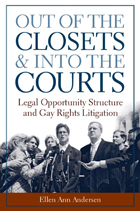 Out of the Closets and into the Courts: Legal Opportunity Structure and Gay Rights Litigation
Ellen Ann Andersen
University of Michigan Press, 2004 Over the past 30 years, the gay rights movement has moved from the margins to the center of American politics, sparking debate from bedroom to boardroom to battlefield. Out of the Closets and into the Courts analyzes the most recent gay rights cases, and explores the complex relationship between litigation and social change. Ellen Andersen describes what happens when these cases—many overseen by the Lambda Legal Defense Fund, the nation's oldest and largest gay rights defense firm—enter the courtroom, and explains why they have met with mixed success.
Out of the Closets and into the Courts explores both the promise and the limits of using legal mobilization to effect social change. Crossing disciplinary boundaries, Ellen Andersen draws on the accumulated knowledge of political science, law, and sociology to explain the origins and outcomes of gay rights litigation. The resulting book is essential reading for anyone interested in gay rights, legal change, and social movements.
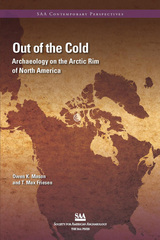 Out of the Cold: Archaeology on the Arctic Rim of North America
Owen K. Mason
University Press of Colorado, 2018 The Arctic rim of North America presents one of the most daunting environments for humans. Cold and austere, it is lacking in plants but rich in marine mammals-primarily the ringed seal, walrus, and bowhead whale. In this book in the SAA Press Current Perspectives Series, the authors track the history of cultural innovations in the Arctic and Subarctic for the past 12,000 years, including the development of sophisticated architecture, watercraft, fur clothing, hunting technology, and worldviews. Climate change is linked to many of the successes and failures of its inhabitants; warming or cooling periods led to periods of resource abundance or collapse, and in several instances to long-distance migrations. At its western and eastern margins, the Arctic also experienced the impact of Asian and European world systems, from that of the Norse in the East to the Russians in the Bering Strait.
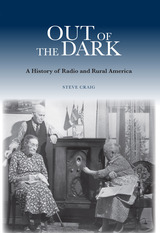 Out of the Dark: A History of Radio and Rural America
Steve Craig
University of Alabama Press, 2009 Out of the Dark is a comprehensive study of radio's impact on rural America in the three decades between its inception and the arrival of television. In the 1920s, the USDA asked farmers about the impact the new medium of radio was having on their lives. One farmer summed it up this way: “Radio brought me out of the dark.” The coming of radio broadcasting had a profound impact on the lives of many Americans, but none more so than those who lived in rural America. Radio provided isolated families with something they had never known before--an instantaneous connection with news, entertainment, and the rapidly evolving lifestyles and mores of the entire nation.
This study documents the social changes radio helped bring about, such as the effects of advertising and entertainment in creating a more uniform set of values across the nation and, consequently, a stronger national identity. Out of the Dark also addresses the political and economic impact the rural audience had on the development of the broadcasting industry and its regulation; the role played by the USDA in the promotion and development of rural radio; and an analysis of how radio entertainment and advertising contributed to the growing demand for consumer goods among rural families, thus speeding their entry into the modern American lifestyle.
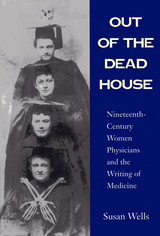 Out of the Dead House: Nineteenth-Century Women Physicians and the Writing of Medicine
Susan Wells
University of Wisconsin Press, 2001 In the last decades of the nineteenth century, two thousand women physicians formed a significant and lively scientific community in the United States. Many were active writers; they participated in the development of medical record-keeping and research, and they wrote self-help books, social and political essays, fiction, and poetry. Out of the Dead House rediscovers the contributions these women made to the developing practice of medicine and to a community of women in science.
Susan Wells combines studies of medical genres, such as the patient history or the diagnostic conversation, with discussions of individual writers. The women she discusses include Ann Preston, the first woman dean of a medical college; Hannah Longshore, a successful practitioner who combined conventional and homeopathic medicine; Rebecca Crumpler, the first African American woman physician to publish a medical book; and Mary Putnam Jacobi, writer of more than 180 medical articles and several important books. Wells shows how these women learned to write, what they wrote, and how these texts were read.
Out of the Dead House also documents the ways that women doctors influenced medical discourse during the formation of the modern profession. They invented forms and strategies for medical research and writing, including methods of using survey information, taking patient histories, and telling case histories. Out of the Dead House adds a critical episode to the developing story of women as producers and critics of culture, including scientific culture.
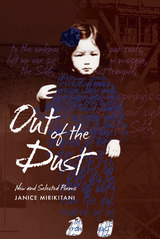 Out of the Dust: New and Selected Poems
Janice Mirikitani
University of Hawaii Press, 2014 Out of the Dust is a collection of new poems by activist, leader, poet, and editor Janice Mirikitani. After being named San Francisco’s second Poet Laureate in 2000, this fifth book of poems from Mirikitani was written in response to the terrorist attacks on September 11, 2001.
Drawing from her own background as a Sansei (third generation) Japanese American, Mirikitani reflects on the many ways we connect through the dust and our ability to rise and renew ourselves from this place. From the dust of the World Trade Center in New York to the retaliatory ashes of the dead in America’s war in Afghanistan, the poems in this volume seek to explicate the connections of our humanity to the reactionary profiling of people of Middle Eastern descent and different ethnicities, comparing these choices to the incarceration of Japanese Americans during World War II.
Mirikitani’s poems cover topics about rape, incest, the continued struggle for justice and economic equality, and the poet’s experiences throughout her 50-year career at Glide Foundation and Church in San Francisco, where she has helped to create groundbreaking programs for the poor, women and children, and those who are healing from sexual assault, violence and abuse. Though constructed from a depth of experiences with struggle, these poems also erupt in celebration of marriage, daughters, and the discovery of self through diversity.
 Out of the Frame: The Struggle for Academic Freedom in Israel
Ilan Pappe
Pluto Press, 2010 Even before he wrote his bestselling book The Ethnic Cleansing of Palestine, historian Ilan Pappe was a controversial figure in Israel. In Out of the Frame, he gives a full account of his break with mainstream Israeli scholarship and its consequences.
Here he traces his journey of discovery from the whispers of Palestinian classmates to his realisation that the 'enemy's' narrative of the events of 1948 was correct. After completing his thesis at Oxford University in the early 1980s, he returned to Palestine determined to protect the memory of the Nakbah. For the first time he gives the details of the formidable opposition he faced in Israel, including death threats fed by the media, denunciations by the Knesset and calls for him to be sacked from his post at Haifa university.
This revealing work, written with dignity and humour, highlights Israel's difficulty in facing up to its past and forging a peaceful, inclusive future in Palestine.
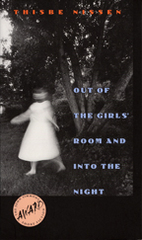 Out of the Girls' Room and into the Night
Thisbe Nissen
University of Iowa Press, 1999 Out of the Girls' Room and into the Night is a spirited, offbeat collection of stories, elongated riffs on that thing we call …love. All manner of love stories: thwarted love stories, imaginary love stories, love stories offhand and obsessive, philosophical love stories, erudite and amusing love stories. “People don't meet because they both like Burmese food,” says one character, “or because someone's sister has a friend who's single and new in town, or because Billy's nose happened to crook just slightly to the left at an angle that made me want to weep…People don't fall in love with each other …they just fall into love.” Everyone does it: women of fierce independence, men of thin character, rambling Deadheads, gay teenage girls, despondent Peace Corps volunteers, anorexic Broadway theatre dancers, the eager, the grieving, the uncommunicative. Even the confused do it. And they don't just fall in love with each other—they fall in love with certain moments and familiar places, with things as ephemeral as gestures and as evanescent as sunlight. Quirky, real, idealistic, deluded, bohemian, and true, these are people who can—and often do—fall in love with a pair of ears, August afternoons, saucers of vitamins, New Age carpenters, and dead bumblebees. And if there's something they can teach us, it's how to conceive of alternative worlds and the terror and the exhilaration of venturing outside the confines of the lives we know and making our way into a dark, glittering unknown.
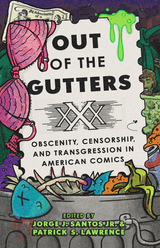 Out of the Gutters: Obscenity, Censorship, and Transgression in American Comics
Edited by Jorge J. Santos Jr. and Patrick S. Lawrence
University of Texas Press, 2025 Comics have long been a subject of moral panics, no doubt thanks to their in-your-face illustrations and their association with young readers. Indeed, the politicians and parents behind today’s book-banning campaigns reserve special ire for graphic novels. What makes today’s controversies different is the content of the alleged obscenity. Instead of targeting sex as such, censors now focus on affirmations of nonheteronormative identity, as in Maia Kobabe’s Gender Queer. And while violence is a constant in comics, stories that acknowledge nationalist oppression and violence, such as Art Spiegelman’s Maus, are also being blacklisted. Out of the Gutters assembles scholars from diverse disciplines to examine US comics, graphic novels, and cartooning that have been challenged as obscene or transgressive. Covering well-known underground figures like Robert Crumb and Charles Burns, newcomers such as C. Spike Trotman and Emil Ferris, and mainstream creators including Chris Claremont and Archie Goodwin, the collection explores the market economics of transgression, historical representations of graphic violence, the ever-changing meaning of pornography, sex-positive comics by BIPOC authors, and queerness in pop-culture mega-properties like X-Men and The Walking Dead.
Out Of The Jungle: Jimmy Hoffa And The Remaking Of
Thaddeus Russell
Temple University Press, 2003 In Out of the Jungle, historian Thaddeus Russell gives us a detailed, crisply written, and fascinating account of Jimmy Hoffa's life and times, much of it previously untold. Russell argues that Hoffa was compelled by a variety of social forces to place the economic interests of his union members over broad ideological concerns. The most important of those forces was the demonstrated desire of ordinary Teamsters to improve their material lives. "What do you hire us for," he famously asked a meeting of truck drivers, "if not to sell your labor at the highest buck we can get?" He responded to the rank-and-file members' demands as did none of his contemporaries in the labor movement, seeking financial gain with the mercilessness that made him renowned and feared. This new paperback edition will be most cherished by students of labor history and American studies.
Out of the Mountains: Appalachian Stories
Meredith Sue Willis
Ohio University Press, 2010 Meredith Sue Willis’s Out of the Mountains is a collection of thirteen short stories set in contemporary Appalachia. Firmly grounded in place, the stories voyage out into the conflicting cultural identities that native Appalachians experience as they balance mainstream and mountain identities. Willis’s stories explore the complex negotiations between longtime natives of the region and its newcomers and the rifts that develop within families over current issues such as mountaintop removal and homophobia. Always, however, the situations depicted in these stories are explored in the service of a deeper understanding of the people involved, and of the place. This is not the mythic version of Appalachia, but the Appalachia of the twenty-first century.
Out of the Mouths of Babes: Infant Voices in Medieval French Literature
Julie Singer
University of Chicago Press, 2025 A wide-ranging study of the rich questions raised by speaking infants in medieval French literature.
Medieval literature is full of strange moments when infants (even fetuses) speak. In Out of the Mouths of Babes, Julie Singer explores the unsettling questions raised by these events, including What is a person? Is speech fundamental to our humanity? And what does it mean, or what does it matter, to speak truth to power?
Singer contends that descriptions of baby talk in medieval French literature are far from trivial. Through treatises, manuals, poetry, and devotional texts, Singer charts how writers imagined infants to speak with an authority untainted by human experience. What their children say, then, offers unique insight into medieval hopes for universal answers to life’s deepest wonderings.
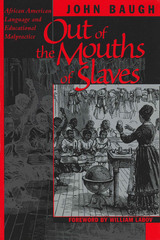 Out of the Mouths of Slaves: African American Language and Educational Malpractice
By John Baugh
University of Texas Press, 1999 Winner, A Choice Outstanding Academic Book When the Oakland, California, school board called African American English "Ebonics" and claimed that it "is not a black dialect or any dialect of English," they reignited a debate over language, race, and culture that reaches back to the era of slavery in the United States. In this book, John Baugh, an authority on African American English, sets new parameters for the debate by dissecting and challenging many of the prevailing myths about African American language and its place in American society. Baugh's inquiry ranges from the origins of African American English among slaves and their descendants to its recent adoption by standard English speakers of various races. Some of the topics he considers include practices and malpractices for educating language minority students, linguistic discrimination in the administration of justice, cross-cultural communication between Blacks and whites, and specific linguistic aspects of African American English. This detailed overview of the main points of debate about African American language will be important reading for both scholars and the concerned public.
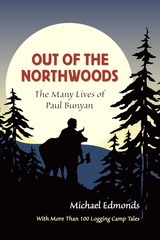 Out of the Northwoods: The Many Lives of Paul Bunyan, With More Than 100 Logging Camp Tales
Michael Edmonds
Wisconsin Historical Society Press, 2009 Every American has heard of the lumberjack hero Paul Bunyan and his big blue ox. For 100 years his exploits filled cartoons, magazines, short stories, and children's books, and his name advertised everything from pancake breakfasts to construction supplies. By 1950 Bunyan was a ubiquitous icon of America's strength and ingenuity. Until now, no one knew where he came from—and the extent to which this mythical hero is rooted in Wisconsin. Out of the Northwoods presents the culture of nineteenth-century lumberjacks in their own words. It includes eyewitness accounts of how the first Bunyan stories were shared on frigid winter nights, around logging camp stoves, in the Wisconsin pinery. It describes where the tales began, how they moved out of the forest and into print, and why publication changed them forever. Part bibliographic mystery and part social history, Out of the Northwoods explains for the first time why we all know and love Paul Bunyan.
Out Of The Ordinary: Folklore and the Supernatural
Barbara Walker
Utah State University Press, 1995 Out of the Ordinary explores the functions of belief and supernatural experience within an array of cultures, as well as the stance of academe toward the study of belief and the supernatural. The essays in this volume call into question the idea that supernatural experience is extraordinary. Among the contributors are Shelley Adler, David Hufford, Barre Toelken, and Gillian Bennett.
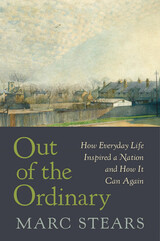 Out of the Ordinary: How Everyday Life Inspired a Nation and How It Can Again
Marc Stears
Harvard University Press, 2020 From a major British political thinker and activist, a passionate case that both the left and right have lost their faith in ordinary people and must learn to find it again.
This is an age of polarization. It’s us vs. them. The battle lines are clear, and compromise is surrender.
As Out of the Ordinary reminds us, we have been here before. From the 1920s to the 1950s, in a world transformed by revolution and war, extreme ideologies of left and right fueled utopian hopes and dystopian fears. In response, Marc Stears writes, a group of British writers, artists, photographers, and filmmakers showed a way out. These men and women, including J. B. Priestley, George Orwell, Barbara Jones, Dylan Thomas, Laurie Lee, and Bill Brandt, had no formal connection to one another. But they each worked to forge a politics that resisted the empty idealisms and totalizing abstractions of their time. Instead they were convinced that people going about their daily lives possess all the insight, virtue, and determination required to build a good society. In poems, novels, essays, films, paintings, and photographs, they gave witness to everyday people’s ability to overcome the supposedly insoluble contradictions between tradition and progress, patriotism and diversity, rights and duties, nationalism and internationalism, conservatism and radicalism. It was this humble vision that animated the great Festival of Britain in 1951 and put everyday citizens at the heart of a new vision of national regeneration.
A leading political theorist and a veteran of British politics, Stears writes with unusual passion and clarity about the achievements of these apostles of the ordinary. They helped Britain through an age of crisis. Their ideas might do so again, in the United Kingdom and beyond.
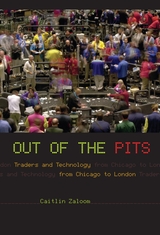 Out of the Pits: Traders and Technology from Chicago to London
Caitlin Zaloom
University of Chicago Press, 2006 From New York to Singapore, from Chicago to London, the trading floors of the world’s financial markets are icons of global capitalism. Images of them are used on the news all the time—traders burying their heads in their hands when the market is down, their arms flailing in a frenzy when fortunes are rising—to convey the current state of the economy. But these marketplaces, and the cultural life that sustains them, are dissolving into the ether of the digital age: powerful financial institutions are shutting down the trading pits, replacing face-to-face exchanges with an electronic network where traders sit, face to screen, finger to mouse, and compete in a global arena made up of digits and charts.
Out of the Pits considers the implications of this sea change for everyone involved, from the traders and brokers to the market as a whole. Caitlin Zaloom takes us down to the floor at the Chicago Board of Trade and into a digital dealing room in the City of London. Drawing on her own firsthand experiences as a clerk and a trader and on her unusual access to these key sites of global finance, she explainshow changes at the world’s leading financial exchanges have transformed economic cultures and the craft of speculation; how people and places are responding to the digital transition; how traders are remaking themselves to compete in the contemporary marketplace; and how brokers, business managers, and software designers are collaborating to build new financial markets.
A penetrating and richly detailed account of how cities, culture, and technology shape everyday life in the new global economy, Out of the Pits will be must reading for business buffs or anyone who has ever wondered how financial markets work.
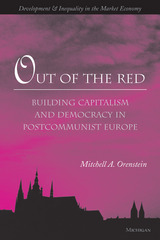 Out of the Red: Building Capitalism and Democracy in Postcommunist Europe
Mitchell A. Orenstein
University of Michigan Press, 2001 After the fall of the Berlin Wall, the countries of East-Central Europe embarked on a journey to transform themselves into democratic capitalist societies. Their governments searched for strategies that would allow them to pursue radical market reforms within the context of nascent democratic politics. Poland adopted a neoliberal strategy that attempted to push through as much reform as possible before an antireform backlash could occur. In the Czech Republic, a social liberal strategy for transformation attempted to combine neoliberal macro-economic policies with social democratic measures designed to avert such a backlash.
A detailed analysis of Poland and the Czech Republic suggests that alternation between strategies has been the secret to the success of East-Central European countries.
This comparative case analysis identifies the significance of reform mistakes during transition and the corrective benefits of policy alternation, its claims illustrated with an in-depth study of privatization policy in the two countries.
Mitchell A. Orenstein delves into the historic struggle to build capitalism and democracy during a decade of post- communist transition in East-Central Europe and develops a model that explains why democratic policy alternation may accelerate policy learning under conditions of uncertainty and constraint.
Out of the Red is accessible to a general audience and as such is suitable for both graduate and undergraduate courses on political economy. It will be of particular interest to economists, political scientists, sociologists, students of postcommunism, and anyone interested in the relations between capitalism and democracy in the contemporary world.
Mitchell A. Orenstein is Assistant Professor of Political Science, Syracuse University.
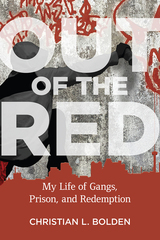 Out of the Red: My Life of Gangs, Prison, and Redemption
Christian L. Bolden
Rutgers University Press, 2020 Frank Tannenbaum Outstanding Book Award from the American Society of Criminology
Faculty Senate Award for Research from Loyola University New Orleans
Out of the Red is one man’s pathbreaking story of how social forces and personal choices combined to deliver an unfortunate fate. After a childhood of poverty, institutional discrimination, violence, and being thrown away by the public education system, Bolden's life took him through the treacherous landscape of street gangs at the age of fourteen. The Bloods offered a sense of family, protection, excitement, and power. Incarcerated during the Texas prison boom, the teenage former gangster was thrust into a fight for survival as he navigated the perils of adult prison. As mass incarceration and prison gangs swallowed up youth like him, survival meant finding hope in a hopeless situation and carving a path to his own rehabilitation. Despite all odds, he forged a new path through education, ultimately achieving the seemingly impossible for a formerly incarcerated ex-gangbanger.
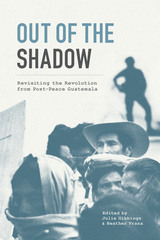 Out of the Shadow: Revisiting the Revolution from Post-Peace Guatemala
Edited by Julie Gibbings and Heather Vrana
University of Texas Press, 2020 Guatemala’s “Ten Years of Spring” (1944–1954) began when citizens overthrew a military dictatorship and ushered in a remarkable period of social reform. This decade of progressive policies ended abruptly when a coup d’état, backed by the United States at the urging of the United Fruit Company, deposed a democratically elected president and set the stage for a period of systematic human rights abuses that endured for generations. Presenting the research of diverse anthropologists and historians, Out of the Shadow offers a new examination of this pivotal chapter in Latin American history. Marshaling information on regions that have been neglected by other scholars, such as coastlines dominated by people of African descent, the contributors describe an era when Guatemalan peasants, Maya and non-Maya alike, embraced change, became landowners themselves, diversified agricultural production, and fully engaged in electoral democracy. Yet this volume also sheds light on the period’s atrocities, such as the US Public Health Service’s medical experimentation on Guatemalans between 1946 and 1948. Rethinking institutional memories of the Cold War, the book concludes by considering the process of translating memory into possibility among present-day urban activists.
Out of the Shadows: A Biographical History of African American Athletes
David K. Wiggins
University of Arkansas Press, 2008 The original essays in this comprehensive collection examine the lives and sports of famous and not-so-famous African American male and female athletes from the nineteenth century to today. Here are twenty insightful biographies that furnish perspectives on the changing status of these athletes and how these changes mirrored the transformation of sports, American society, and civil rights legislation. Some of the athletes discussed include Marshall Taylor (bicycling), William Henry Lewis (football), Jack Johnson, Satchel Paige, Jesse Owens, Joe Lewis, Alice Coachman (track and field), Althea Gibson (tennis), Wilma Rudolph, Bill Russell, Jim Brown, Arthur Ashe, Michael Jordan, Tiger Woods, and Venus and Serena Williams.
Out of the Shadows: The Health and Well-Being of Private Contractors Working in Conflict Environments
Molly Dunigan
RAND Corporation, 2013 Private contractors have been deployed extensively around the globe for the past decade and may be exposed to many of the stressors that are known to have physical and mental health implications for military personnel. Results from a RAND survey offer preliminary findings about the mental and physical health of contractors, their deployment experiences, and their access to and use of health care resources.
 Out of the Vinyl Deeps: Ellen Willis on Rock Music
Nona Willis Aronowitz
University of Minnesota Press, 2010 In 1968, the New Yorker hired Ellen Willis as its first popular music critic. Her column, Rock, Etc., ran for seven years and established Willis as a leader in cultural commentary and a pioneer in the nascent and otherwise male-dominated field of rock criticism. As a writer for a magazine with a circulation of nearly half a million, Willis was also the country’s most widely read rock critic. With a voice at once sharp, thoughtful, and ecstatic, she covered a wide range of artists—Bob Dylan, The Who, Van Morrison, Elvis Presley, David Bowie, the Rolling Stones, Creedence Clearwater Revival, Joni Mitchell, the Velvet Underground, Sam and Dave, Bruce Springsteen, and Stevie Wonder—assessing their albums and performances not only on their originality, musicianship, and cultural impact but also in terms of how they made her feel.
Because Willis stopped writing about music in the early 1980s—when, she felt, rock ’n’ roll had lost its political edge—her significant contribution to the history and reception of rock music has been overshadowed by contemporary music critics like Robert Christgau, Lester Bangs, and Dave Marsh. Out of the Vinyl Deeps collects for the first time Willis’s Rock, Etc. columns and her other writings about popular music from this period (includingliner notes for works by Lou Reed and Janis Joplin) and reasserts her rightful place in rock music criticism.
More than simply setting the record straight, Out of the Vinyl Deeps reintroduces Willis’s singular approach and style—her use of music to comment on broader social and political issues, critical acuity, vivid prose, against-the-grain opinions, and distinctly female (and feminist) perspective—to a new generation of readers. Featuring essays by the New Yorker’s current popular music critic, Sasha Frere-Jones, and cultural critics Daphne Carr and Evie Nagy, this volume also provides a lively and still relevant account of rock music during, arguably, its most innovative period.
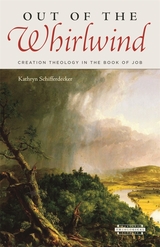 Out of the Whirlwind: Creation Theology in the Book of Job
Kathryn Schifferdecker
Harvard University Press, 2008 The book of Job is a complex, sophisticated treatment of the problem of undeserved suffering. It is also a sustained meditation on creation, on humanity’s place in creation, and on God’s ordering of creation. In this study, Kathryn Schifferdecker offers a close literary and theological reading of the book of Job—particularly of the speeches of God at the end of the book—in order to articulate its creation theology, which is particularly pertinent in our environmentally-conscious age.
After all of Job’s agonized questioning, God’s answer does not directly address Job’s questions about undeserved suffering or divine justice. Instead, the divine speeches take Job on a God’s-eye tour of creation in all its beauty and complexity. In extraordinarily detailed and beautiful poetry, the divine speeches show Job that the world is radically non-anthropocentric, that there exist wild places and animals whose value has nothing to do with their usefulness to humanity, and that God delights in the freedom of God’s creatures. This vision of the divine speeches enables Job to move out of despair into renewed participation in God’s often-dangerous but beautiful world.
This creation theology of Job, virtually unique in the Bible, has much to say to us today, as we struggle theologically and politically with the issues of environmental degradation and humanity’s relationship to the natural world.
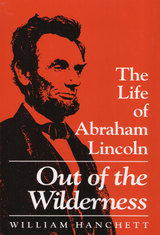 Out of the Wilderness: THE LIFE OF ABRAHAM LINCOLN
William Hanchett
University of Illinois Press, 1994 In Out of Darkness William Hanchett, a leading Lincoln Scholar,
follows Abraham Lincoln from his birth and chronicles his thirst for education,
his achievements as a lawyer and congressman, his presidency, and his
assassination.
Hanchett gives readers a deeper understanding of how Lincoln's self-directed
study and clear thinking offset his lack of a formal education, enabling
him to become a respected and successful attorney. He also shows how Lincoln's
uncanny leadership helped him to end slavery and still keep the divided
North sufficiently united to win the Civil War. By focusing on a variety
of roles and settings, Hanchett invites readers to get to know Lincoln
as a president, as well as a lover, husband, father, and friend.
"Excellent! Hanchett is a fine writer, and his biography of Lincoln
is succinct and thought-provoking."
-- Frank J. Williams, president, Abraham Lincoln Association
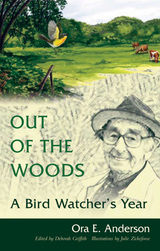 Out of the Woods: A Bird Watcher’s Year
Ora E. Anderson
Ohio University Press, 2007 Out of the Woods: A Bird Watcher’s Year is a journey through the seasons and a joyous celebration of growing old. In fifty-nine essays and poems, Ora E. Anderson, birder, bird carver, naturalist, and nature writer, reveals the insights and recollections of a keen-eyed observer of nature, both human and avian. The essays follow the rivers and creeks, the highways and little-known byways of Appalachia, and along the way we become nearly as familiar with its numerous bird, plant, and animal species as with the author himself.
These are not the memories of a single year, however, but of a long lifetime spent immersed in the natural world. Out of the Woods, presented with humor and passion, is an account of a well-lived, productive, and satisfying life. The essays offer an intimate portrait of a half century of Anderson's life on his beloved old farm (more nearly a nature preserve), where he lived in harmony with birds and nature and followed the rhythm of the seasons. We are invited to share the joys—and the disappointments and sorrows—inherent in such a life.
Generously illustrated with Julie Zickefoose’s detailed and evocative drawings, this book will delight bird watchers, artists, naturalists, backyard gardeners, and anyone who is ever tempted to take a rutted, overgrown path just to see where it leads.
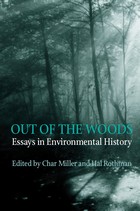 Out Of The Woods: Essays in Environmental History
Char Miller
University of Pittsburgh Press, 1997
Through the pages of Environmental History Review, now Environmental History, an entire discipline has been created and defined over time through the publication of the finest scholarship by humanists, social and natural scientists, and other professionals concerned with the complex relationship between people and our global environment. Out of the Woods gathers together the best of this scholarship.
Covering a broad array of topics and reflecting the continuing diversity within the field of environmental history, Out of the Woods begins with three theoretical pieces by William Cronon, Carolyn Merchant, and Donald Worster probing the assumptions that underlie the words and ideas historians use to analyze human interaction with the physical world. One of these - the concept of place - is the subject of a second group of essays. The political context is picked up in the third section, followed by a selection of some of the journal’s most recent contributions discussing the intersection between urban and environmental history. Water’s role in defining the contours of the human and natural landscape is undeniable and forms the focus of the fifth section. Finally, the global character of environmental issues emerges in three compelling articles by Alfred Crosby, Thomas Dunlap, and Stephen Pyne.
Of interest to a wide range of scholars in environmental history, law, and politics, Out of the Woods is intended as a reader for course use and a benchmark for the field of environmental history as it continues to develop into the next century.
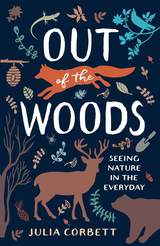 Out of the Woods: Seeing Nature in the Everyday
Julia Corbett
University of Nevada Press, 2018 2018 Reading the West Book Awards Nonfiction Winner
Have you ever wondered about society’s desire to cultivate the perfect lawn, why we view some animals as “good” and some as “bad,” or even thought about the bits of nature inside everyday items–toothbrushes, cell phones, and coffee mugs? In this fresh and introspective collection of essays, Julia Corbett examines nature in our lives with all of its ironies and contradictions by seamlessly integrating personal narratives with morsels of highly digestible science and research. Each story delves into an overlooked aspect of our relationship with nature—insects, garbage, backyards, noise, open doors, animals, and language—and how we cover our tracks.
With a keen sense of irony and humor and an awareness of the miraculous in the mundane, Julia recognizes the contradictions of contemporary life. She confronts the owner of a high-end market who insists on keeping his doors open in all temperatures. Takes us on a trip to a new mall with a replica of a trout stream that once flowed nearby. The phrase “out of the woods” guides us through layers of meaning to a contemplation of grief, remembrance, and resilience.
Out of the Woods leads to surprising insights into the products, practices, and phrases we take for granted in our everyday encounters with nature and encourages us all to consider how we might re-value or reimagine our relationships with nature in our everyday lives.
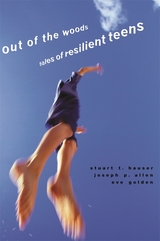 Out of the Woods: Tales of Resilient Teens
Stuart T. Hauser, Joseph P. Allen, and Eve Golden
Harvard University Press, 2008 Seventy deeply troubled teenagers spend weeks, months, even years on a locked psychiatric ward. They’re not just failing in school, not just using drugs. They are out of control—violent or suicidal, in trouble with the law, unpredictable, and dangerous. Their futures are at risk.
Twenty years later, most of them still struggle. But astonishingly, a handful are thriving. They’re off drugs and on the right side of the law. They’ve finished school and hold jobs that matter to them. They have close friends and are responsible, loving parents.
What happened? How did some kids stumble out of the woods while others remain lost? Could their strikingly different futures have been predicted back during their teenage struggles? The kids provide the answers in a series of interviews that began during their hospitalizations and ended years later. Even in the early days, the resilient kids had a grasp of how they contributed to their own troubles. They tried to make sense of their experience and they groped toward an understanding of other people’s inner lives.
In their own impatient voices, Out of the Woods portrays edgy teenagers developing into thoughtful, responsible adults. Listening in on interviews through the years, narratives that are often poignant, sometimes dramatic, frequently funny, we hear the kids growing into more composed—yet always recognizable—versions of their tough and feisty selves.
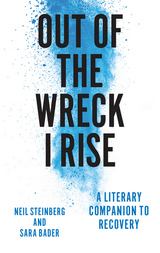 Out of the Wreck I Rise: A Literary Companion to Recovery
Neil Steinberg and Sara Bader
University of Chicago Press, 2016 “There’s still time to change things.”—Siri Hustvedt, The Blazing World
Addiction is easy to fall into and hard to escape. It destroys the lives of individuals, and has a devastating cost to society. The National Institute of Health estimates seventeen million adults in the United States are alcoholics or have a serious problem with alcohol. At the same time, the country is seeing entire communities brought to their knees because of opioid additions. These scourges affect not only those who drink or use drugs but also their families and friends, who witness the horror of addiction. With Out of the Wreck I Rise, Neil Steinberg and Sara Bader have created a resource like no other—one that harnesses the power of literature, poetry, and creativity to illuminate what alcoholism and addiction are all about, while forging change, deepening understanding, and even saving lives.
Structured to follow the arduous steps to sobriety, the book marshals the wisdom of centuries and explores essential topics, including the importance of time, navigating family and friends, relapse, and what Raymond Carver calls “gravy,” the reward that is recovery. Each chapter begins with advice and commentary followed by a wealth of quotes to inspire and heal. The result is a mosaic of observations and encouragement that draws on writers and artists spanning thousands of years—from Seneca to David Foster Wallace, William Shakespeare to Patti Smith. The ruminations of notorious drinkers like John Cheever, Charles Bukowski, and Ernest Hemingway shed light on the difficult process of becoming sober and remind the reader that while the literary alcoholic is often romanticized, recovery is the true path of the hero.
Along with traditional routes to recovery—Alcoholics Anonymous, out-patient therapy, and intensive rehabilitation programs—this literary companion offers valuable support and inspiration to anyone seeking to fight their addiction or to a struggling loved one.
Featuring Charles Bukowski, John Cheever, Dante, Ricky Gervais, Ernest Hemingway, Billie Holiday, Anne Lamott, John Lennon, Haruki Murakami, Anaïs Nin, Mary Oliver, Samuel Pepys, Rainer Maria Rilke, J. K. Rowling, Patti Smith, Kurt Vonnegut, and many more.
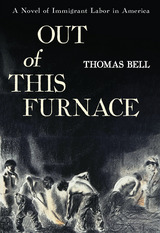 Out Of This Furnace
Thomas Bell
University of Pittsburgh Press, 1976
Out of This Furnace is Thomas Bell’s most compelling achievement. Its story of three generations of an immigrant Slovak family -- the Dobrejcaks -- still stands as a fresh and extraordinary accomplishment.
The novel begins in the mid-1880s with the naive blundering career of Djuro Kracha. It tracks his arrival from the old country as he walked from New York to White Haven, his later migration to the steel mills of Braddock, Pennsylvania, and his eventual downfall through foolish financial speculations and an extramarital affair. The second generation is represented by Kracha’s daughter, Mary, who married Mike Dobrejcak, a steel worker. Their decent lives, made desperate by the inhuman working conditions of the mills, were held together by the warm bonds of their family life, and Mike’s political idealism set an example for the children. Dobie Dobrejcak, the third generation, came of age in the 1920s determined not to be sacrificed to the mills. His involvement in the successful unionization of the steel industry climaxed a half-century struggle to establish economic justice for the workers.
Out of This Furnace is a document of ethnic heritage and of a violent and cruel period in our history, but it is also a superb story. The writing is strong and forthright, and the novel builds constantly to its triumphantly human conclusion.
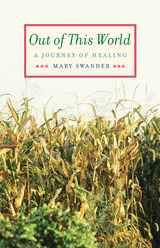 Out of This World: A Journey of Healing
Mary Swander
University of Iowa Press, 1995 When a life-threatening allergic illness demanded that she eat only organically grown food, writer and professor Mary Swander built a new life in a former one-room Iowa schoolhouse in the middle of the largest Amish community west of the Mississippi. In this rich and engaging memoir, which follows the course of a farmer’s year, she writes from the well-named Fairview School to share the radical transformation of her life.
From her perch in rural Kalona, Iowa, Swander discovers new strength and self-reliance along with a community of hardworking and hospitable neighbors. Raising goats and poultry, participating in barn raisings and auctions, protecting her garden from a plague of grasshoppers, creating a living crèche at Christmastime, all the while laughing at her attempts to wrestle with the pioneer challenges of midwestern winters and summers, she explores what it means to be a lone physical and spiritual homesteader at the end of the twentieth century.
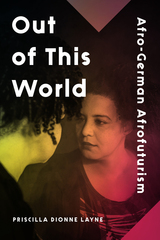 Out of This World: Afro-German Afrofuturism
Priscilla Dionne Layne
Northwestern University Press, 2025 Examining Afro-German artists’ use of Afrofuturist tropes to critique German racial history The term Afrofuturism was first coined in the 1990s to describe African diasporic artists’ use of science fiction, speculative fiction, and fantasy to reimagine the diaspora’s pasts and to counter not only Eurocentric prejudices but also pessimistic narratives. Out of This World: Afro-German Afrofuturism focuses on contemporary Black German Afrofuturist literature and performance that critiques Eurocentrism and, specifically, German racism and colonial history. This young generation has, Priscilla Layne argues, engaged with Afrofuturism to disrupt linear time and imagine alternative worlds, to introduce non-Western technologies into the German cultural milieu, and to consider the possibilities of posthumanism. Their experiments in futurist and speculative narratives offer new tools for breaking with the binary thinking about race, culture, and gender identity that have been enforced by repressive ideological and state apparatuses, such as educational, cultural, and police institutions. Rather than providing escapism or purely imaginary alternatives, however, they have created a space—outer and artistic—in which their lives matter.
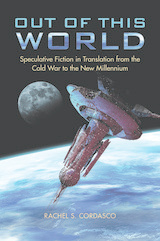 Out of This World: Speculative Fiction in Translation from the Cold War to the New Millennium
Rachel S. Cordasco
University of Illinois Press, 2021 The twenty-first century has witnessed an explosion of speculative fiction in translation (SFT). Rachel Cordasco examines speculative fiction published in English translation since 1960, ranging from Soviet-era fiction to the Arabic-language dystopias that emerged following the Iraq War. Individual chapters on SFT from Korean, Czech, Finnish, and eleven other source languages feature an introduction by an expert in the language's speculative fiction tradition and its present-day output. Cordasco then breaks down each chapter by subgenre--including science fiction, fantasy, and horror--to guide readers toward the kinds of works that most interest them. Her discussion of available SFT stands alongside an analysis of how various subgenres emerged and developed in a given language. She also examines the reasons a given subgenre has been translated into English. An informative and one-of-a-kind guide, Out of This World offers readers and scholars alike a tour of speculative fiction's new globalized era.
Out of Time
Geoff Schmidt
University of North Texas Press, 2011
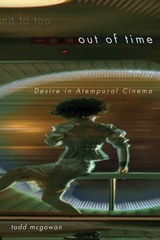 Out of Time: Desire in Atemporal Cinema
Todd McGowan
University of Minnesota Press, 2010 In Out of Time, Todd McGowan takes as his starting point the emergence of a temporal aesthetic in cinema that arose in response to the digital era. Linking developments in cinema to current debates within philosophy, McGowan claims that films that change the viewer’s relation to time constitute a new cinematic mode: atemporal cinema.
In atemporal cinema, formal distortions of time introduce spectators to an alternative way of experiencing existence in time—or, more exactly, a way of experiencing existence out of time. McGowan draws on contemporary psychoanalysis, particularly Jacques Lacan, to argue that atemporal cinema unfolds according to the logic of the psychoanalytic notion of the drive rather than that of desire, which has conventionally been the guiding concept of psychoanalytic film studies.
Despite their thematic diversity, these films distort chronological time with a shared motivation: to reveal the logic of repetition. Like psychoanalysis, McGowan contends, the atemporal mode locates enjoyment in the embrace of repetition rather than in the search for the new and different.
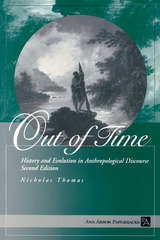 Out of Time: History and Evolution in Anthropological Discourse
Nicholas Thomas
University of Michigan Press, 1996 Despite the enormous amount of work that has attempted to combine historical and anthropological approaches in recent years, few books have outlined the underlying premises that make integration of the two fields difficult. In Out of Time, Nicholas Thomas argues that a "historical perspective" cannot simply be added to conventional anthropology, which systematically takes ethnography "out of time." Drawing examples from the Polynesian anthropological literature, he points to discredited social evolutionary ideas that have persisted even after apparently dramatic theoretical shifts and to the need to take seriously sources that anthropologists have previously dismissed.
When it was first published in 1989, Out of Time generated much-needed discussion on the appropriate models for historical anthropology. Thomas considered that both the historical structuralism of Marshall Sahlins and neo-Marxist regional systems theory had failed to transcend crucial limitations of conventional anthropology. Yet they provided elements of a more stimulating and critical perspective, which would also take account of contemporary political developments in the Pacific region.
For this second edition, Thomas has added an afterword that reflects on the book's initial reception and brings its critique up to date. He suggests a need to historicize the professionalization of anthropology as a discipline to understand shifts in practice and the need to acknowledge the historical specificity and limits of all forms of cultural knowledge, whether "Western" or indigenous.
Out of Time will be a useful text for graduate courses in anthropology, history, and cultural studies.
"This book displays rare integrity: Thomas' intellectual stance toward the theoretical approaches of others is fully consistent with his own discursive practices." --Contemporary Pacific
Nicholas Thomas is Senior Research Fellow, Department of Archaeology and Anthropology, Australian National University.
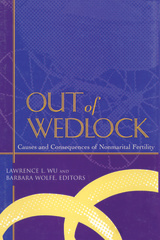 Out of Wedlock: Causes and Consequences of Nonmarital Fertility
Larry Wu
Russell Sage Foundation, 2001 Today, one third of all American babies are born to unmarried mothers—a startling statistic that has prompted national concern about the consequences for women, children, and society. Indeed, the debate about welfare and the overhaul of the federal welfare program for single mothers was partially motivated by the desire to reduce out of wedlock births. Although the proportion of births to unwed mothers has stopped climbing for the first time since the 1960s, it has not decreased, and recent trends are too complex to attribute solely to policy interventions. What are these trends and how do they differ across groups? Are they peculiar to the United States, or rooted in more widespread social forces? Do children of unmarried mothers face greater life challenges, and if so what can be done to help them? Out of Wedlock investigates these questions, marshalling sociologists, demographers, and economists to review the state of current research and to provide both empirical information and critical analyses. The conflicting data on nonmarital fertility give rise to a host of vexing theoretical, methodological, and empirical issues, some of which researchers are only beginning to address. Out of Wedlock breaks important new ground, bringing clarity to the data and examining policies that may benefit these particularly vulnerable children.
|
|
